
Hong Kong to Tokyo
February 14 to March 5, 2025
Mike and Judy Henderson
I'll leave this map at the beginning of each webpage to help you see where we are. In this installment we'll sail from Hong Kong to Shanghai.

+++++++++++++++++++++++++++++++++++++++++++++
2/18/2025 (Tuesday) This is our last day in Xi'an. We take a short excursion in the morning and then go to the airport to fly to Hong Kong.
++++++++++++++++++++++++++++++++++++++++++++
Let me make a short digression to talk about Internet access in Xi'an and in China.
In working on this blog in Xi'an, I discovered the China Great Firewall. The hotel had decent Internet access (speed) but a number of web sites were blocked. For example, I could not access Google, Wikipedia, and several other sites while using the hotel Internet access. But I could access those sites with my iPhone when using the cellular 5G system. It may be that the Great Firewall could determine from my phone number that I was not Chinese and gave me access to sites that it would have blocked to a phone with a Chinese phone number.
I could access and use Bing.com for searches in the hotel, but the results had a note at the bottom that some sites were not shown because of government regulation. Other times, I searched for something and the results I got back had nothing to do with my search query.
According to a web source, all language versions of Wikipedia have been blocked in China since April 2019 (some sources say May 2019). Internet access in Hong Kong appears to be fairly open, but Hong Kong is a Special Administrative Region (SAR).
My advice for travelers using the Internet in China is to be careful what you say on the Internet. You can be arrested for saying things critical of the China government (and for many other reasons). You may be tempted to use a Virtual Private Network (VPN) to get out of China, but I expect China can detect the use of a VPN.
++++++++++++++++++++++++++++++++++++++++++
We left the hotel about 9:30 am. We're going to the Giant Wild Goose Pagoda, a Buddhist pagoda built in 652 AD. Buddhism came to China from India.
Here's the group waiting while Ivy-2 gets the tickets.
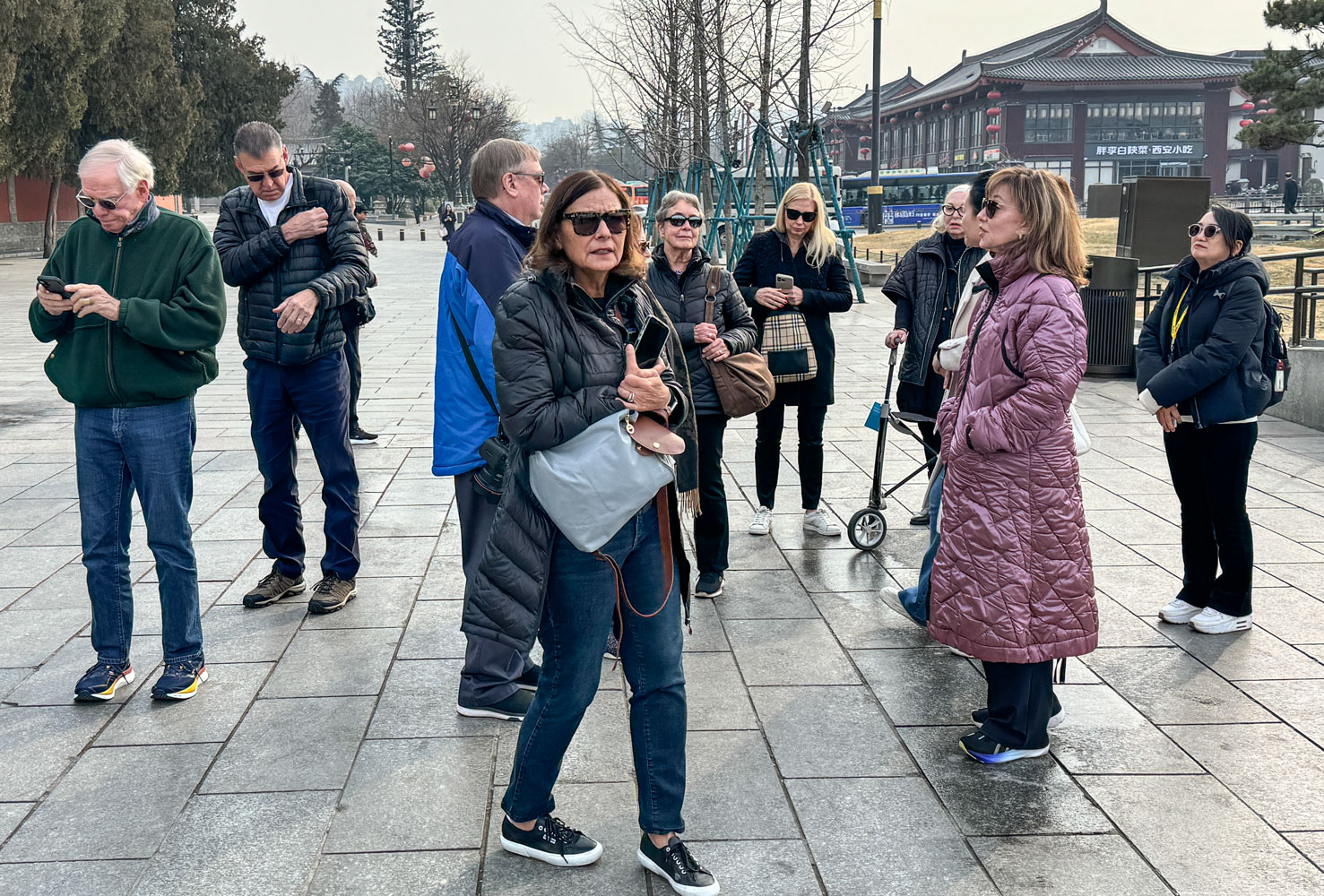
The entrance to the facility.
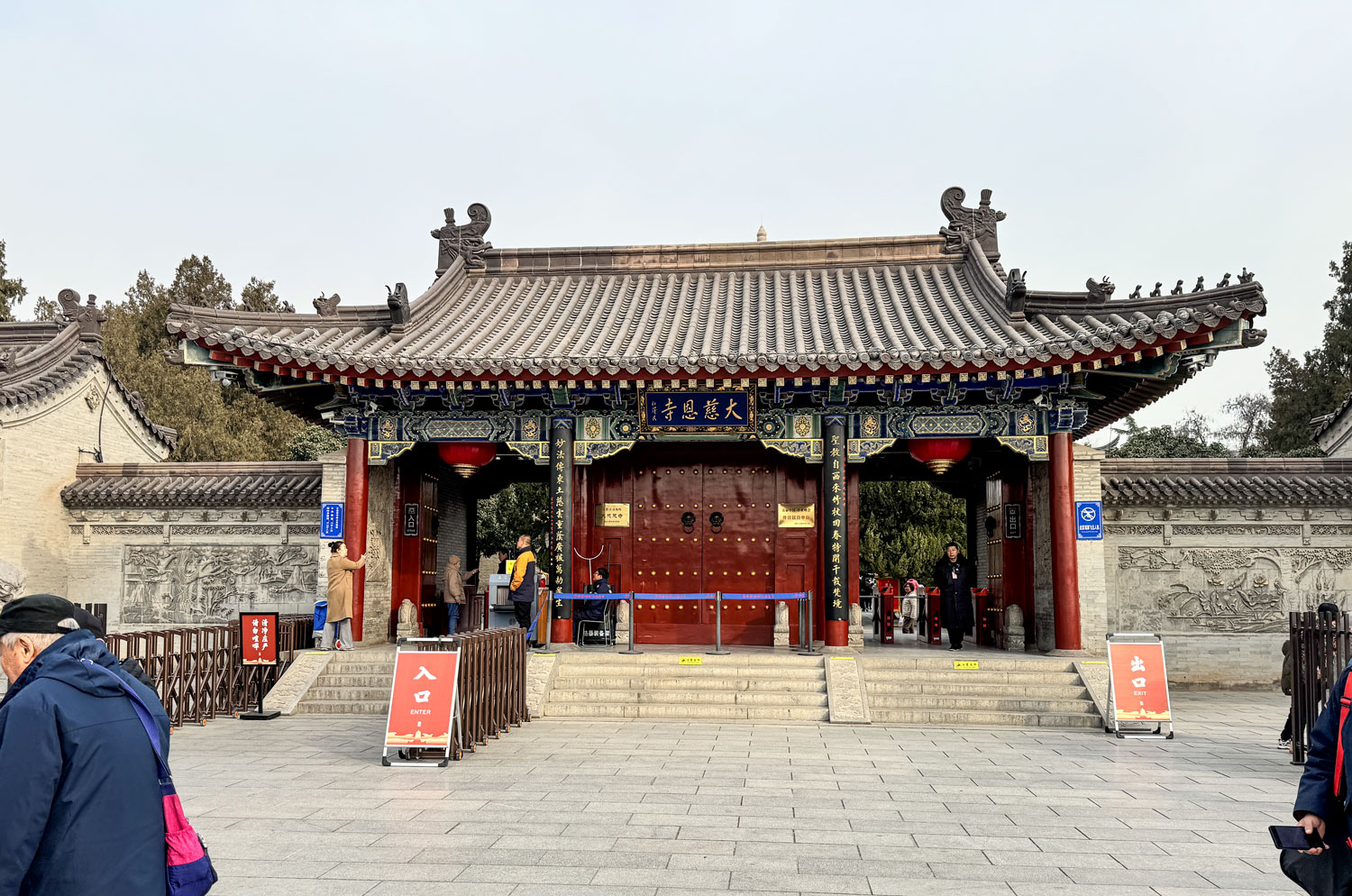
You can see the pagoda as soon as you pass the entrance gate.
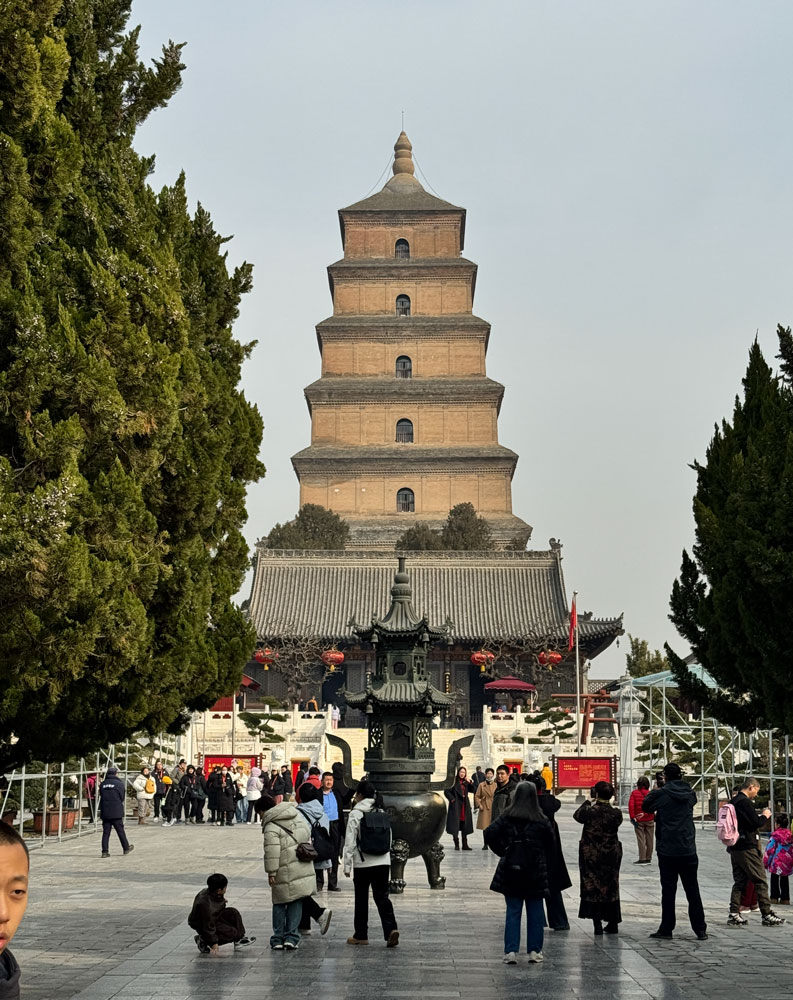
We walked up the steps to the platform at the base of the pagoda. This metal box has sand in the bottom. They give you three incense sticks, which you light and place into the sand.

Judy placing her three incense sticks into the sand while trying to keep from burning the sleeve of her jacket.
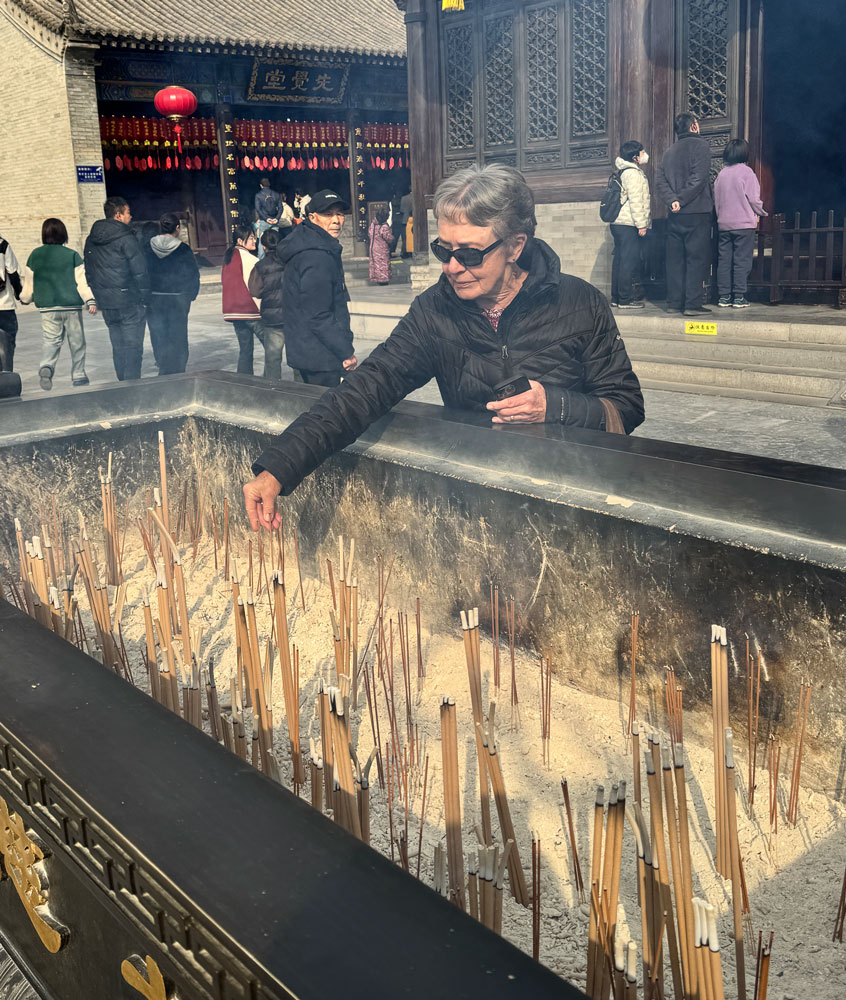
The buildings in the area had many different "altars", with interesting decorations. I'm going to put some pictures of them here. I don't know their meanings so I can't give any explanation. This one was very colorful.
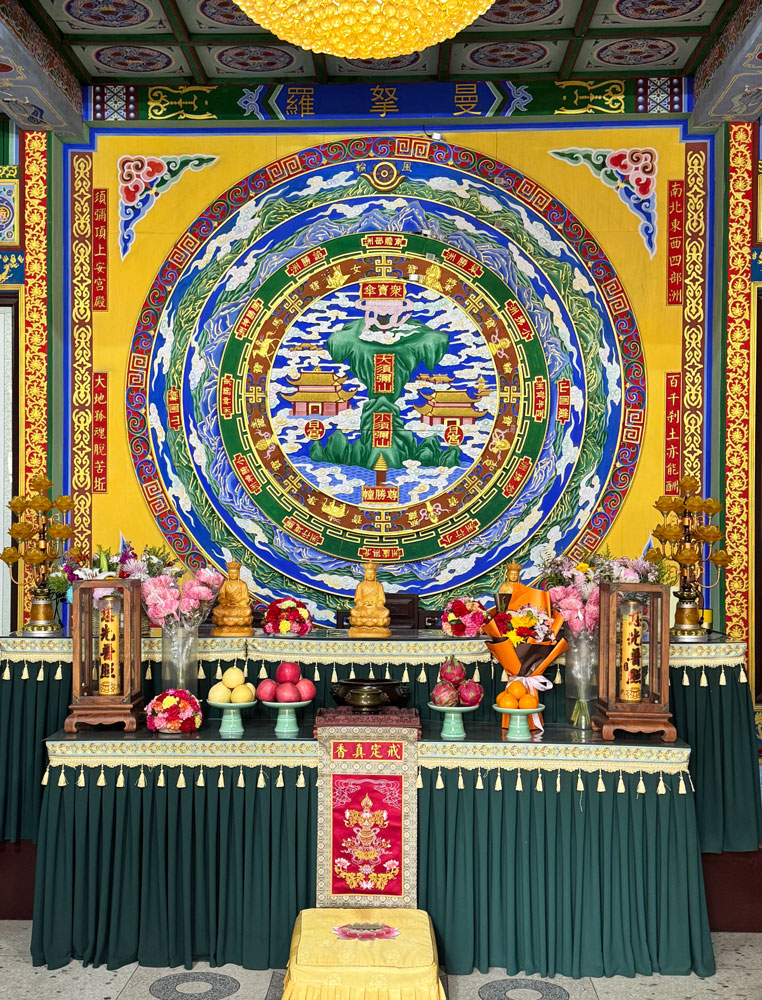
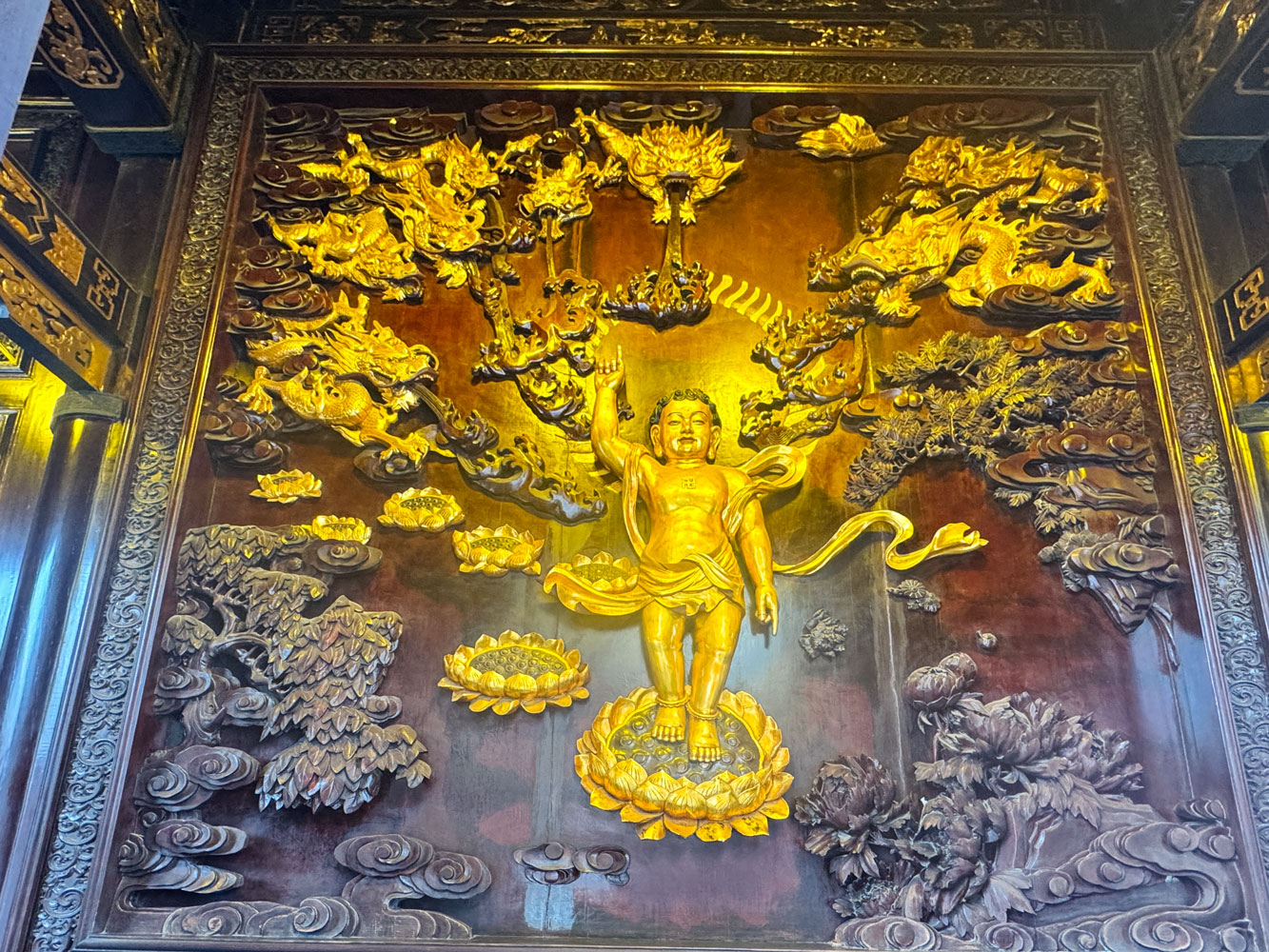

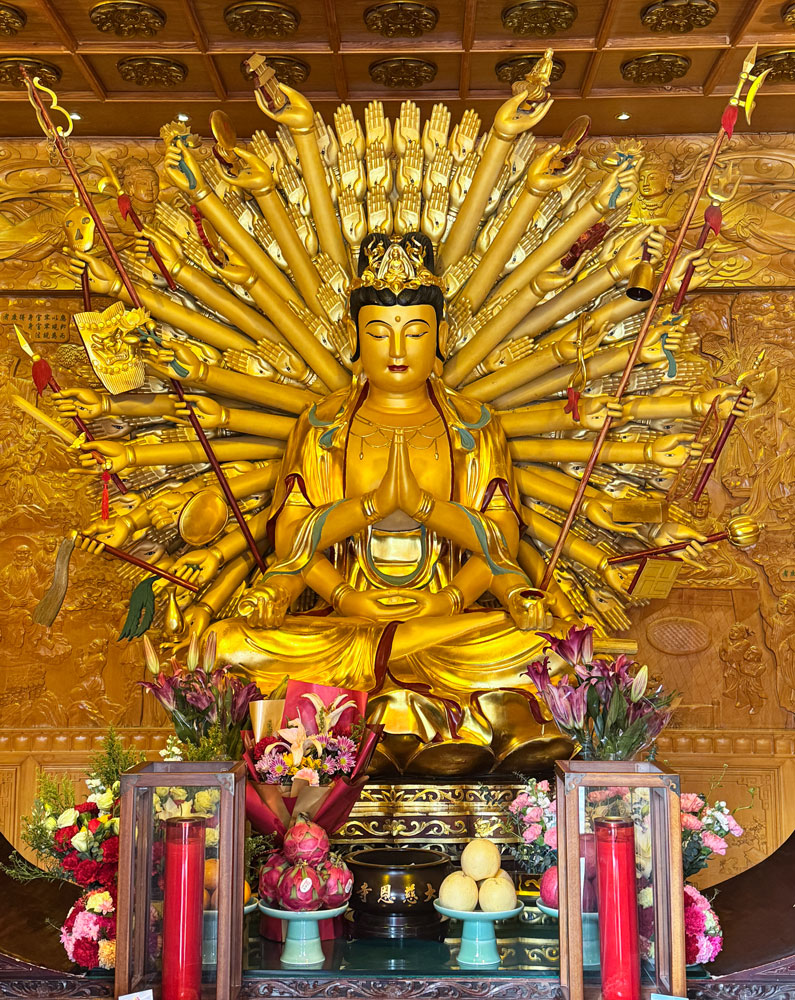
Closer look.
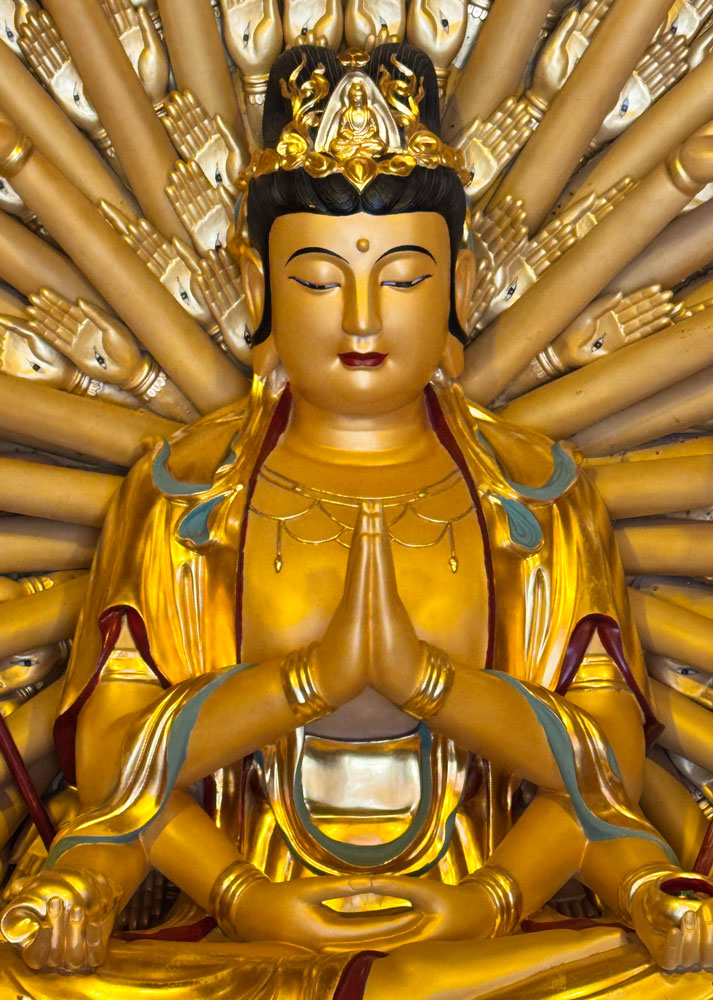
A building on the grounds.

We left the pagoda and walked to a restaurant for lunch. Just outside the Pagoda area was this statue of Master Xuanzang, a 7th Century Buddhist monk who contributed to the spread of Buddhism in China. Buddism had its beginnings in India in the 6th century BC.
Master Xuanzang traveled to India as a young man and brought back many Buddhist texts to China. He also translated many of the most important.
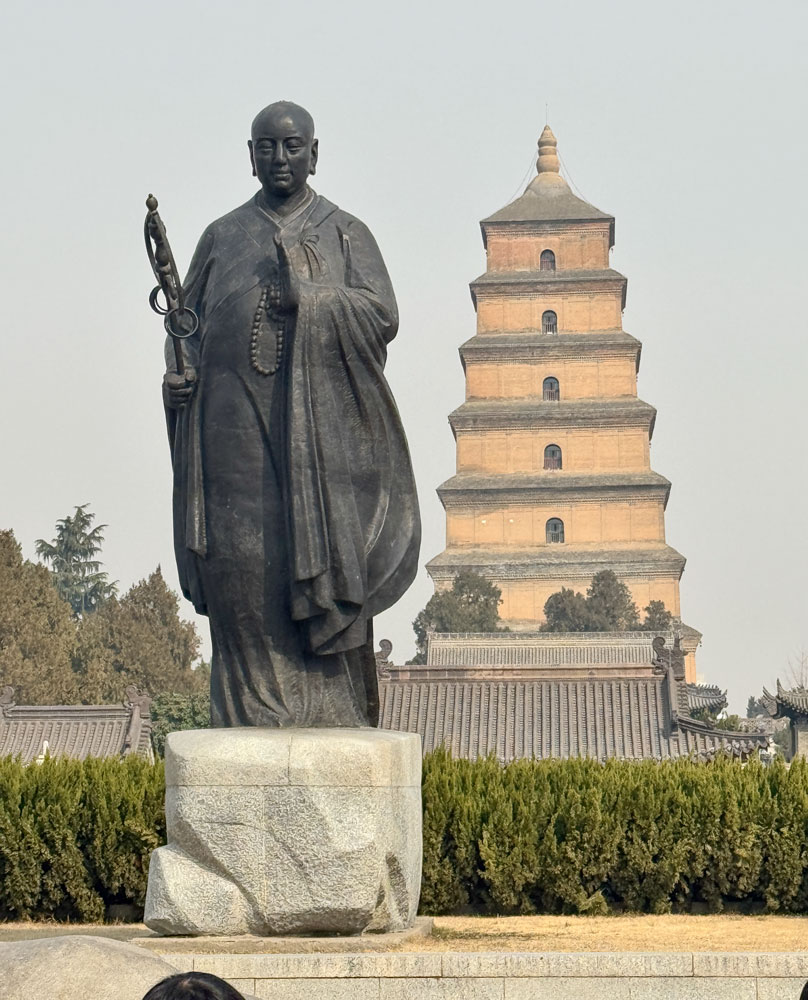
The wide walkway had various sculptures in the middle, shops along the sides, and was described as a popular and crowded gathering spot in the evenings. I'll just include a few pictures.
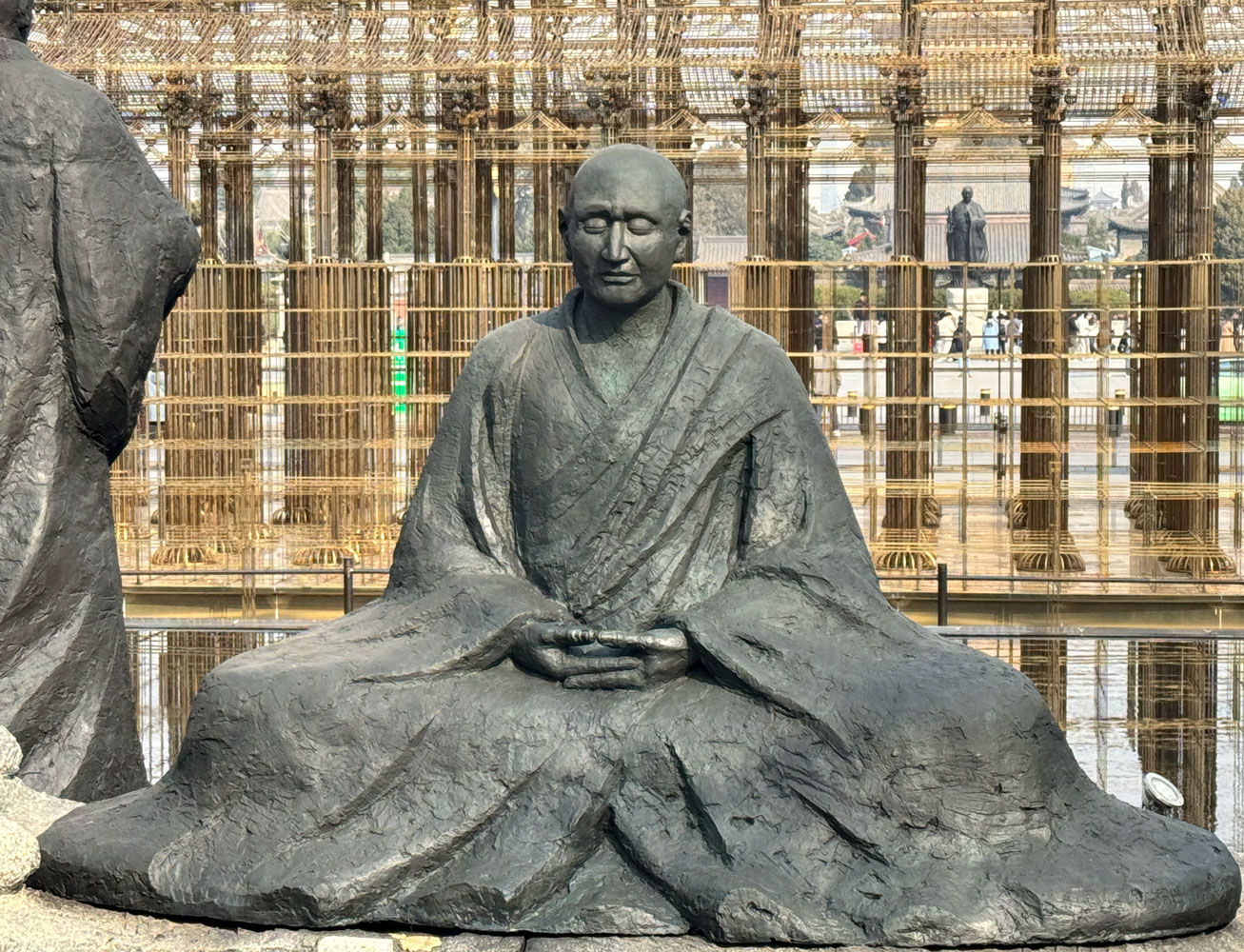

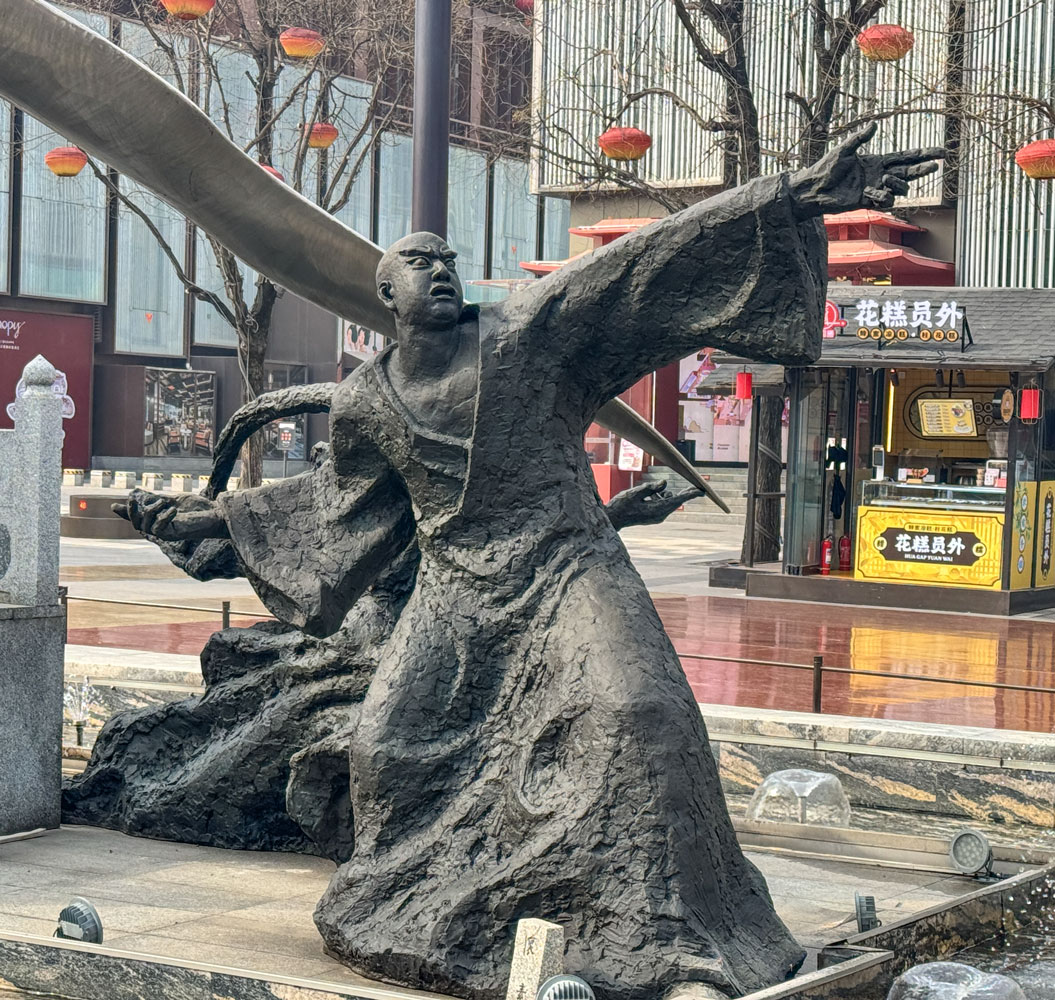
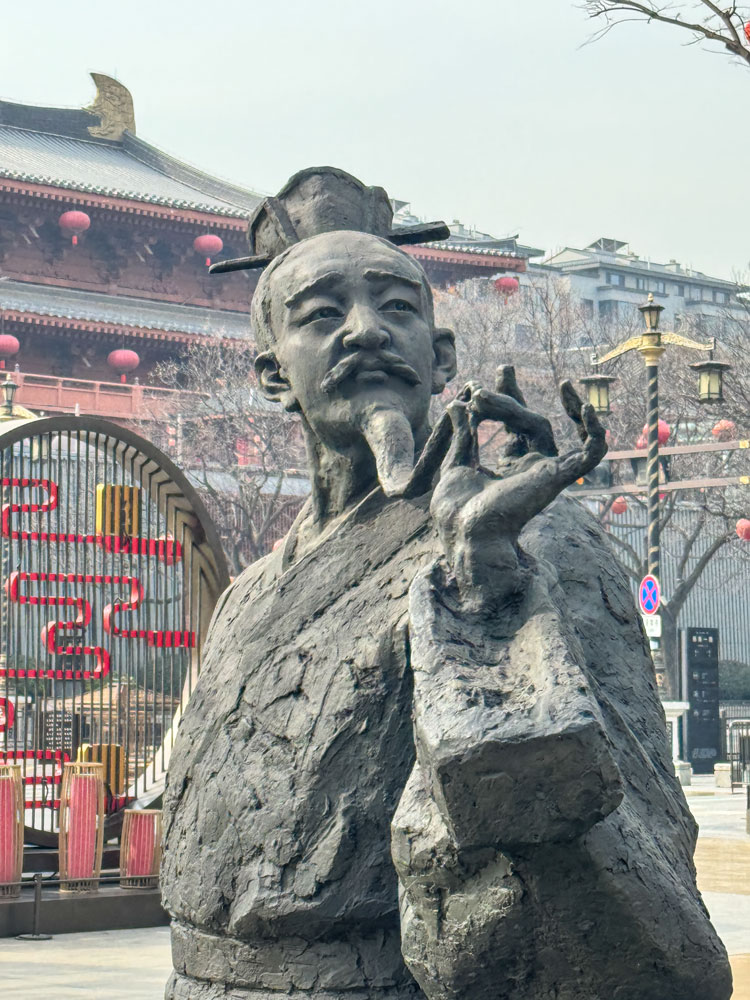
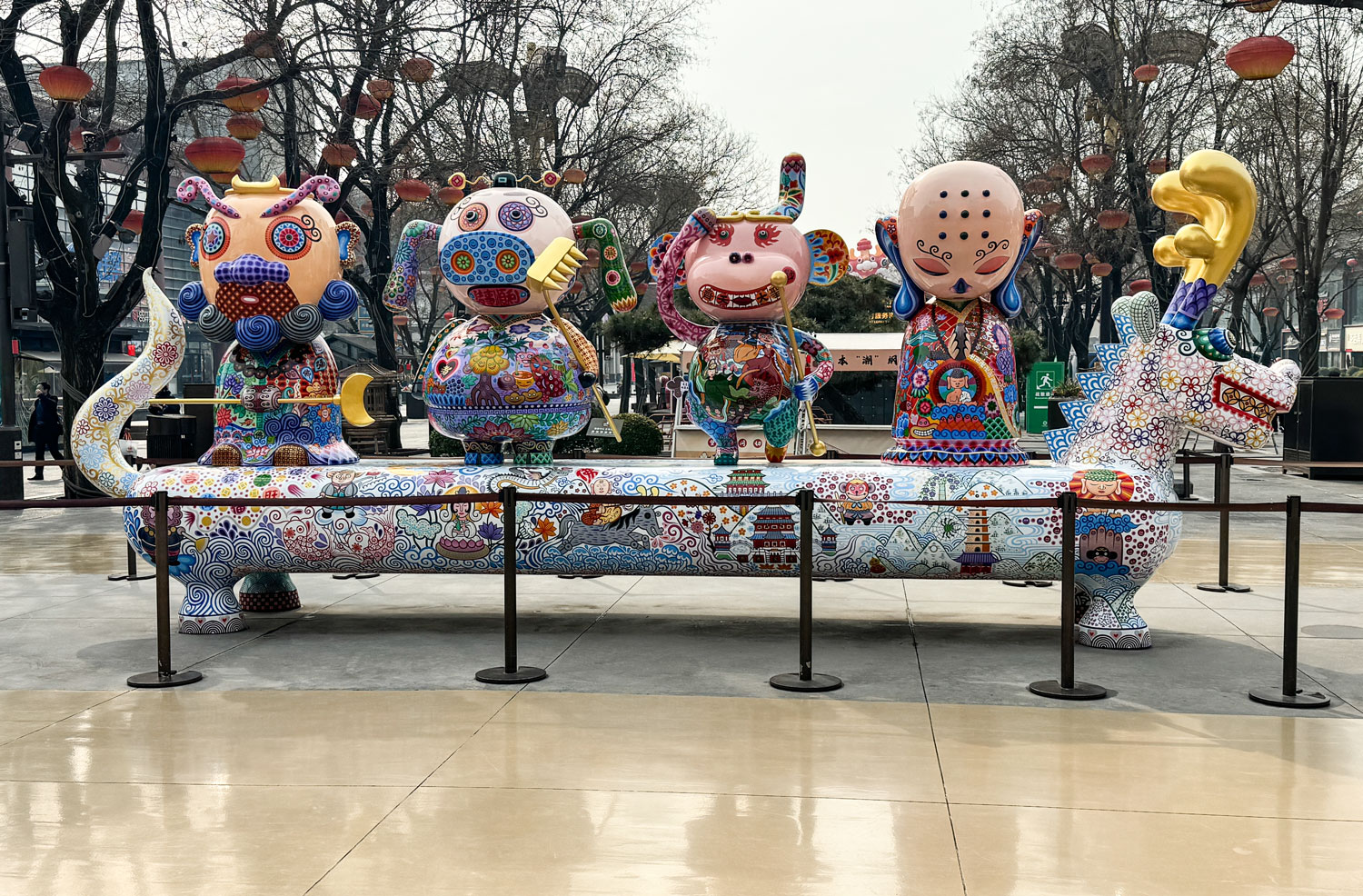
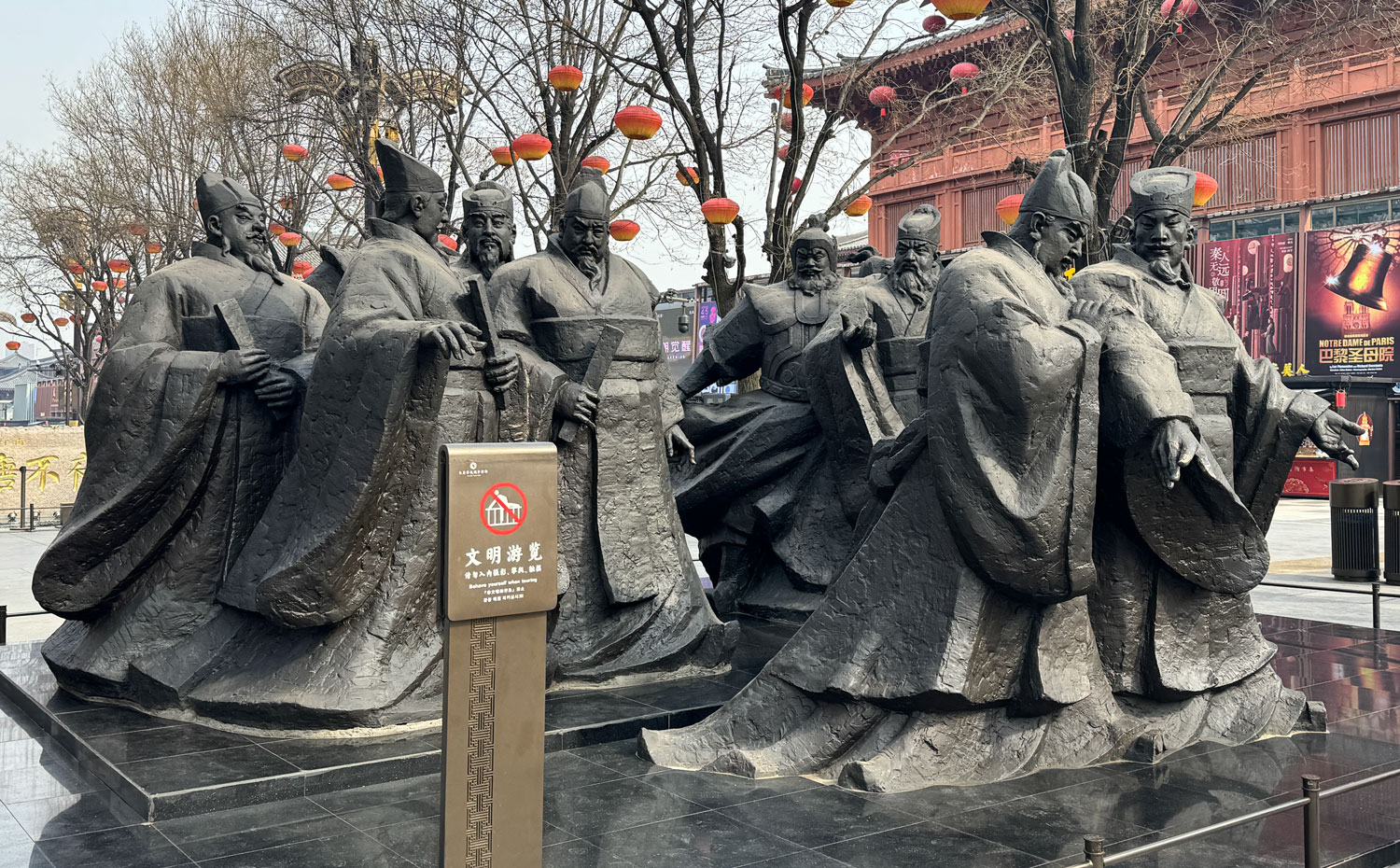
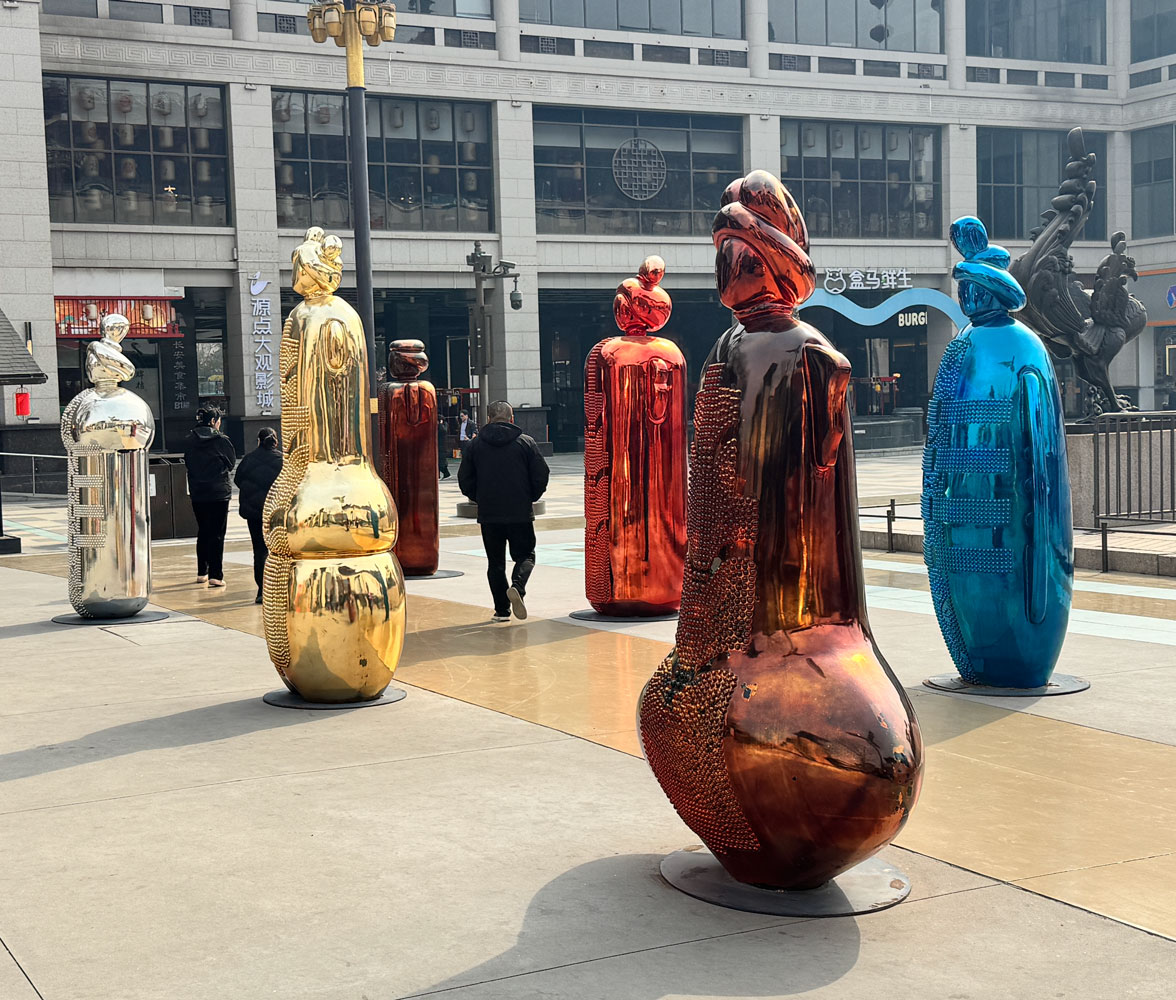
Eventually, we came to a shopping mall - the restaurant is in the shopping mall. It's a "Hot Pot" restaurant.
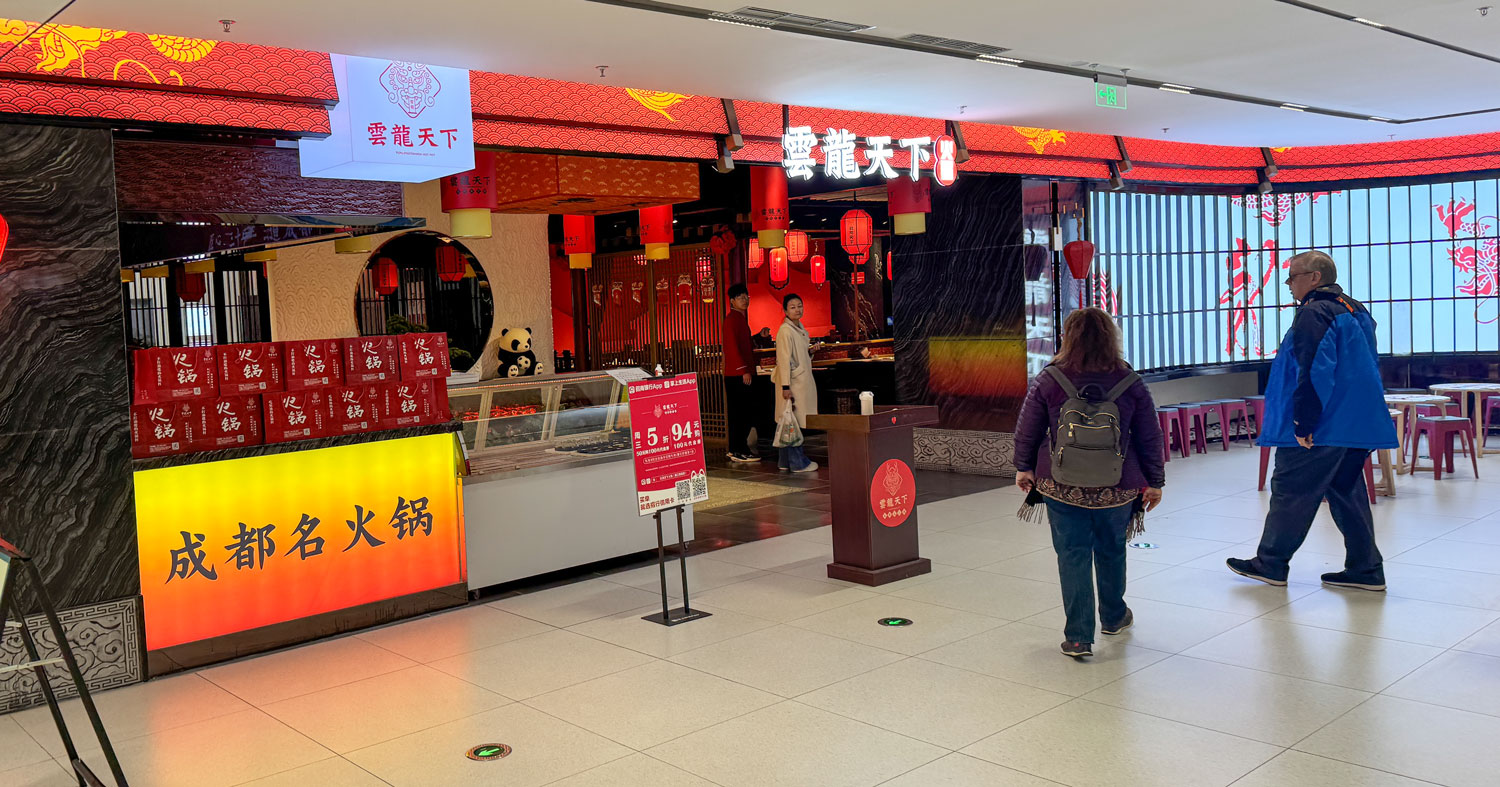
Inside the restaurant we were seated at two tables, each of which had a large dish (or pot) of a hot water-based broth with various seasonings in it. There was a heater under each pot to keep the liquid boiling. We were given a wide variety of meats and vegetables which we picked up with chopsticks and held in the liquid to cook.
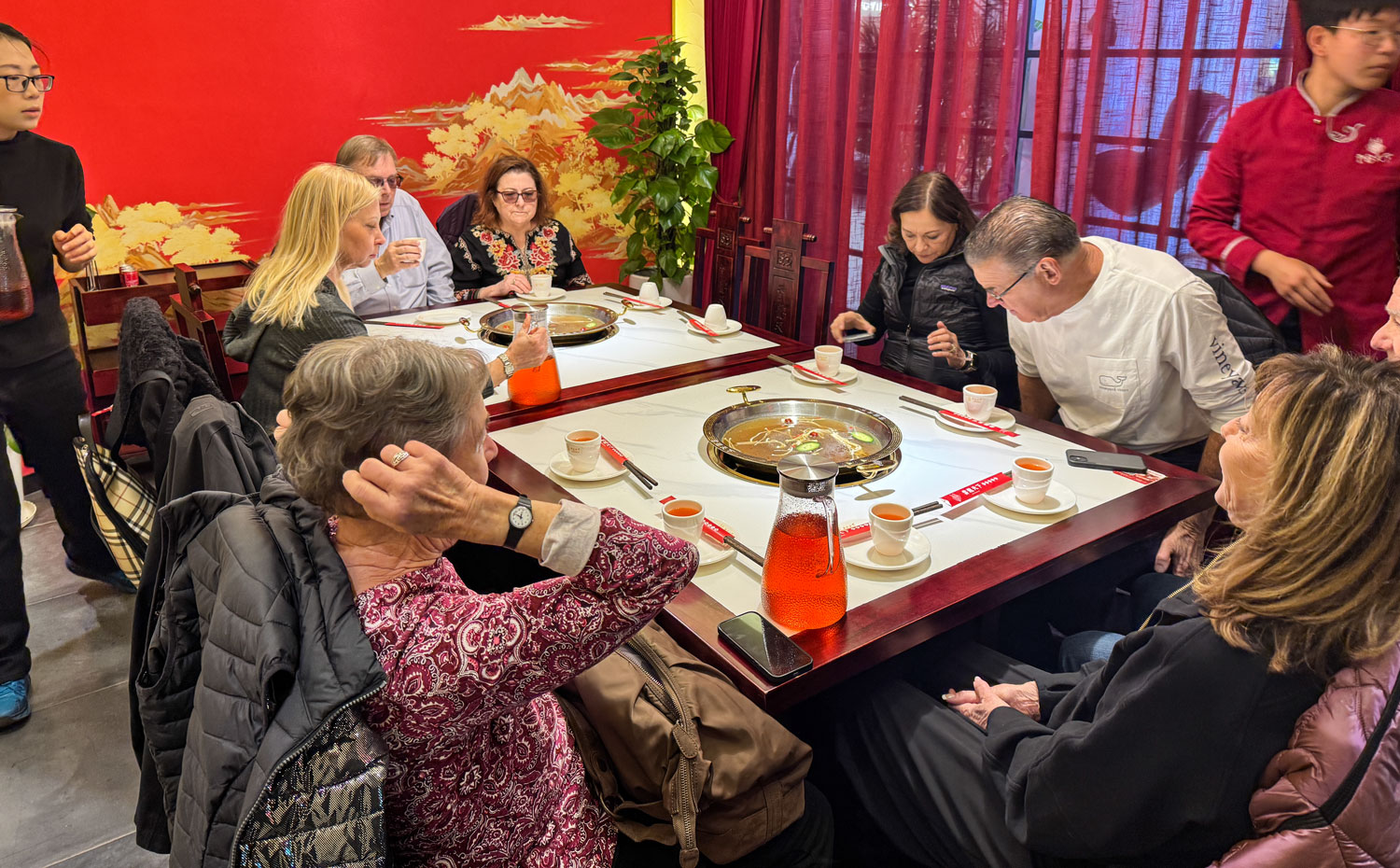
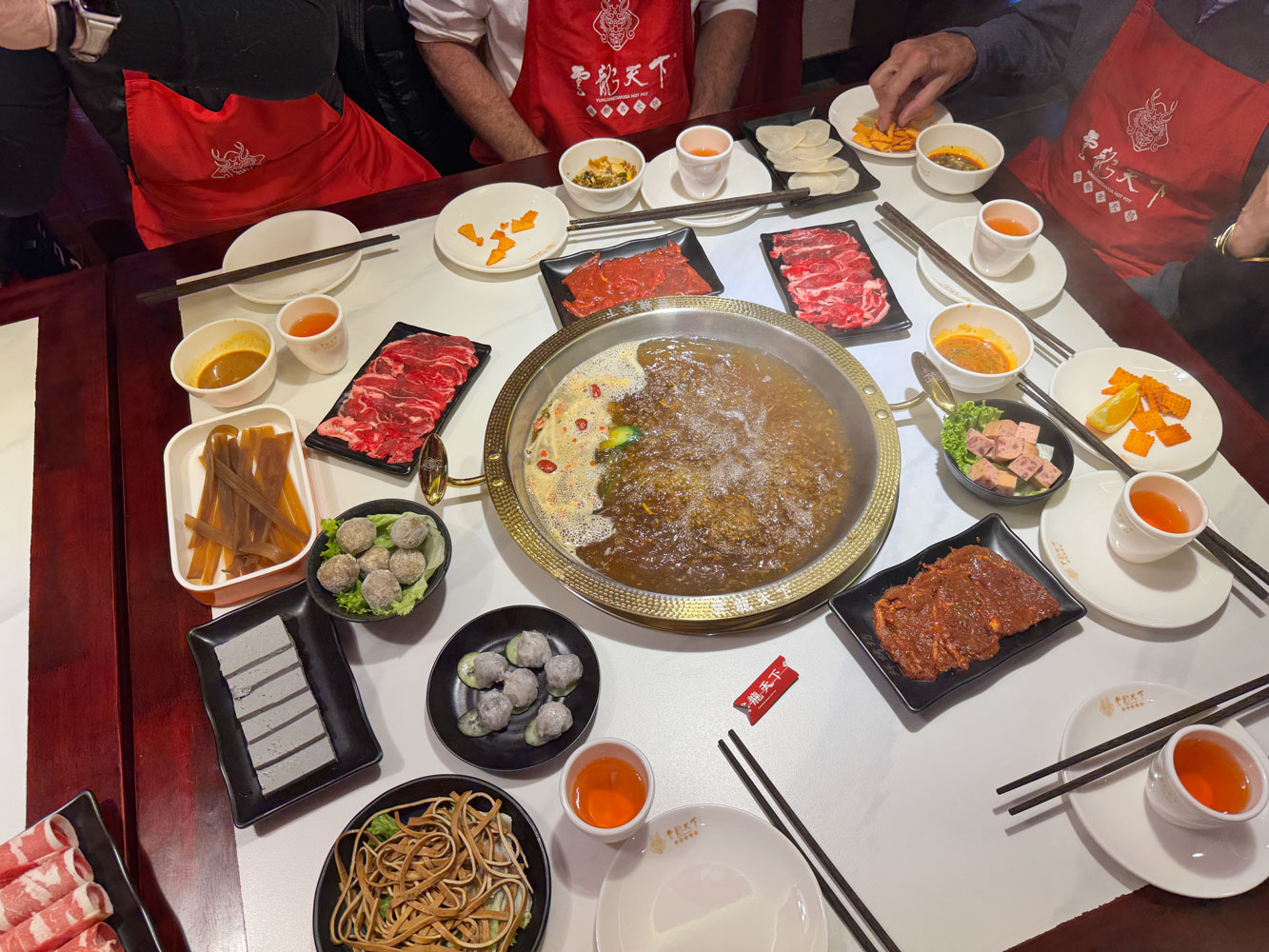
Bob, Sara, Ivy-1 and Sonia at lunch.
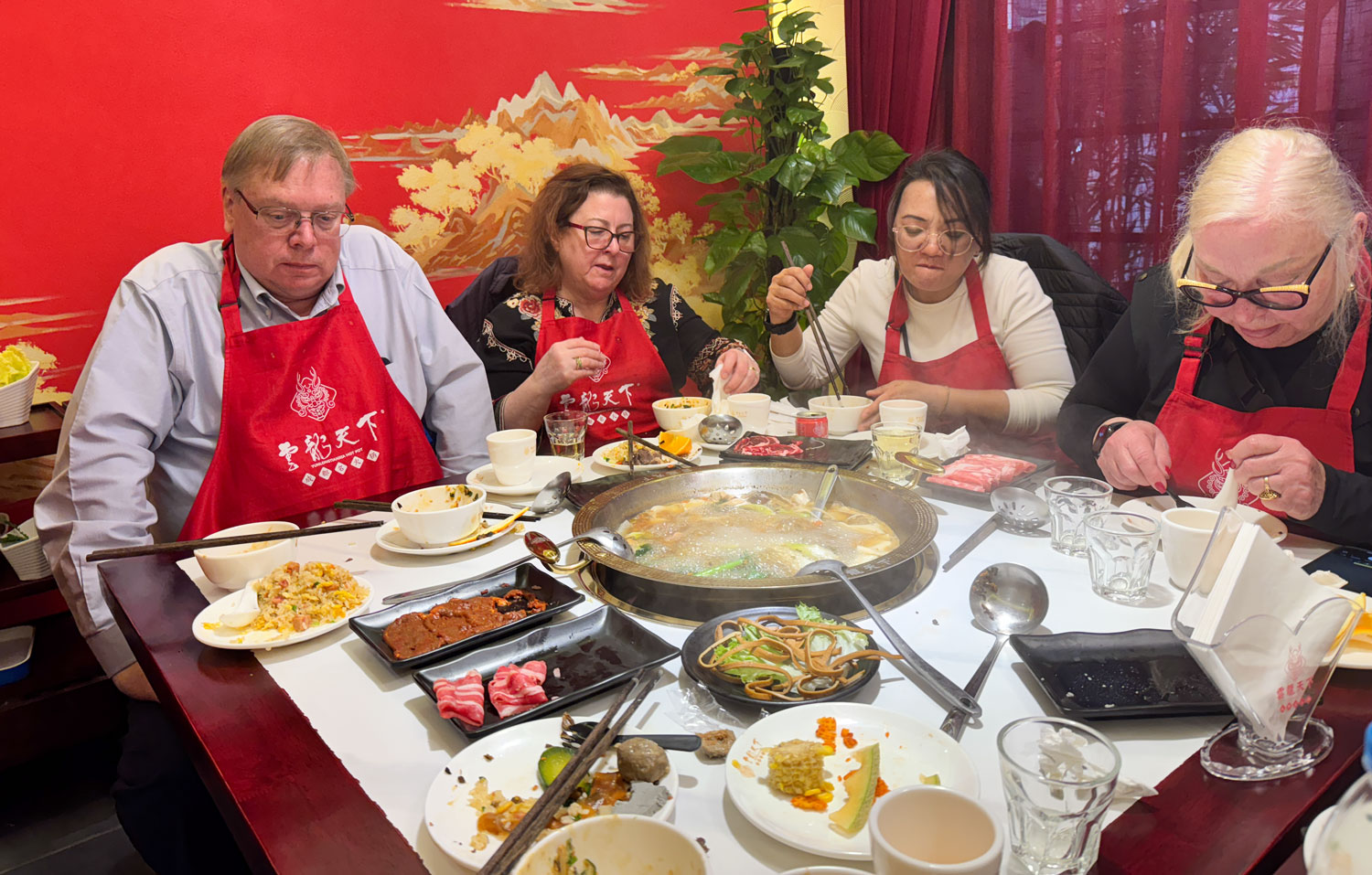
It was not my favorite meal. I didn't find the taste of the food to be very good and it was difficult and messy to "cook" each piece.
I'm glad I had a chance to experience it, but I won't rush back to a Hot Pot restaurant.
After lunch, we drove to the airport. The Xi'an airport is a fairly large airport, 9th largest in China. There are four terminals, T1, T2, T3, and T5. Four is an unlucky number in China so they skipped it in numbering the terminals.
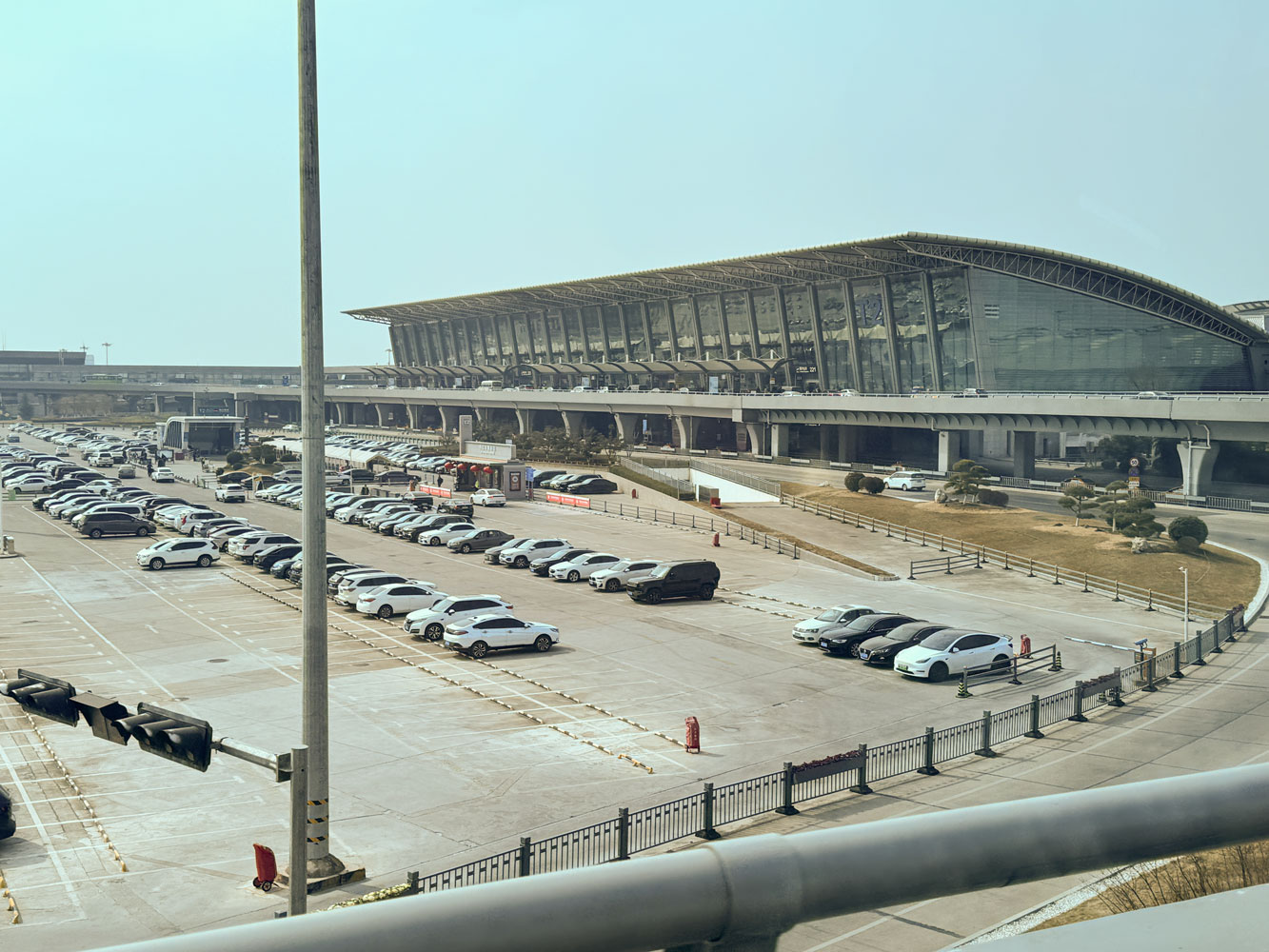
We checked in and got through security without problems, and boarded on time. This time we're on an Airbus A330-300 which has a 2-4-2 layout in economy. Judy and I have two seats on the side, which is nice.
We flew that same curved route back to Hong Kong.
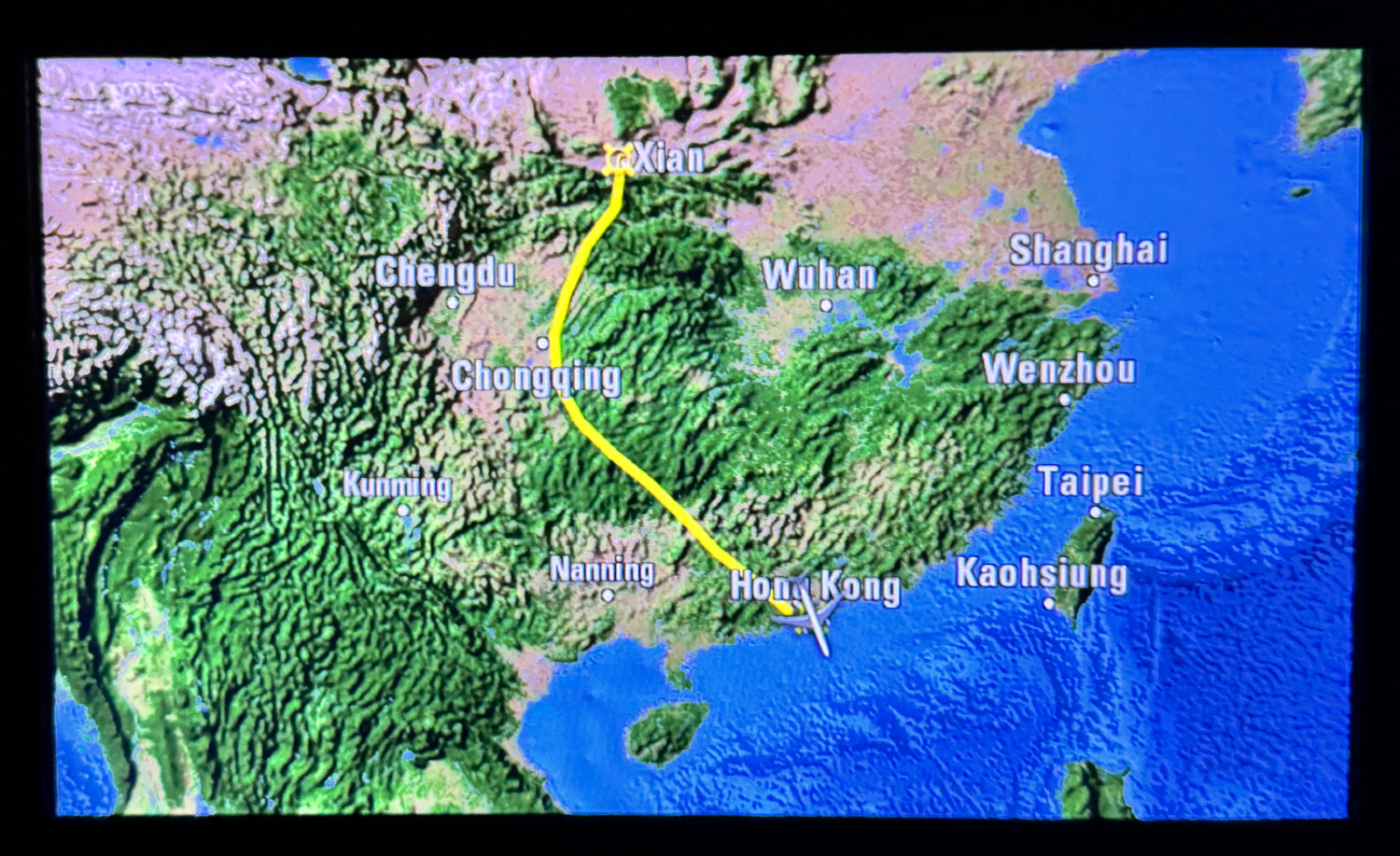
Everything was normal - we picked up our luggage and a bus took us back to the Shangri-La Hotel for the night, arriving about 9pm. We got our room key and that was the end of our day. Tomorrow, we board the Regent Explorer ship. Note that we never had any real tourist time in Hong Kong.
++++++++++++++++++++++++++++++++++++++++++++++++++
2/19/2025 (Wednesday) Today is the official start of the cruise portion of the trip. Everything I described so far was part of the pre-cruise excursion.
We had the morning free. The ship arrived in Hong Kong last night and they have to disembark all the passengers and set up the ship to receive a new group of guests. We gathered in the lobby about noon and will be bused to the port.
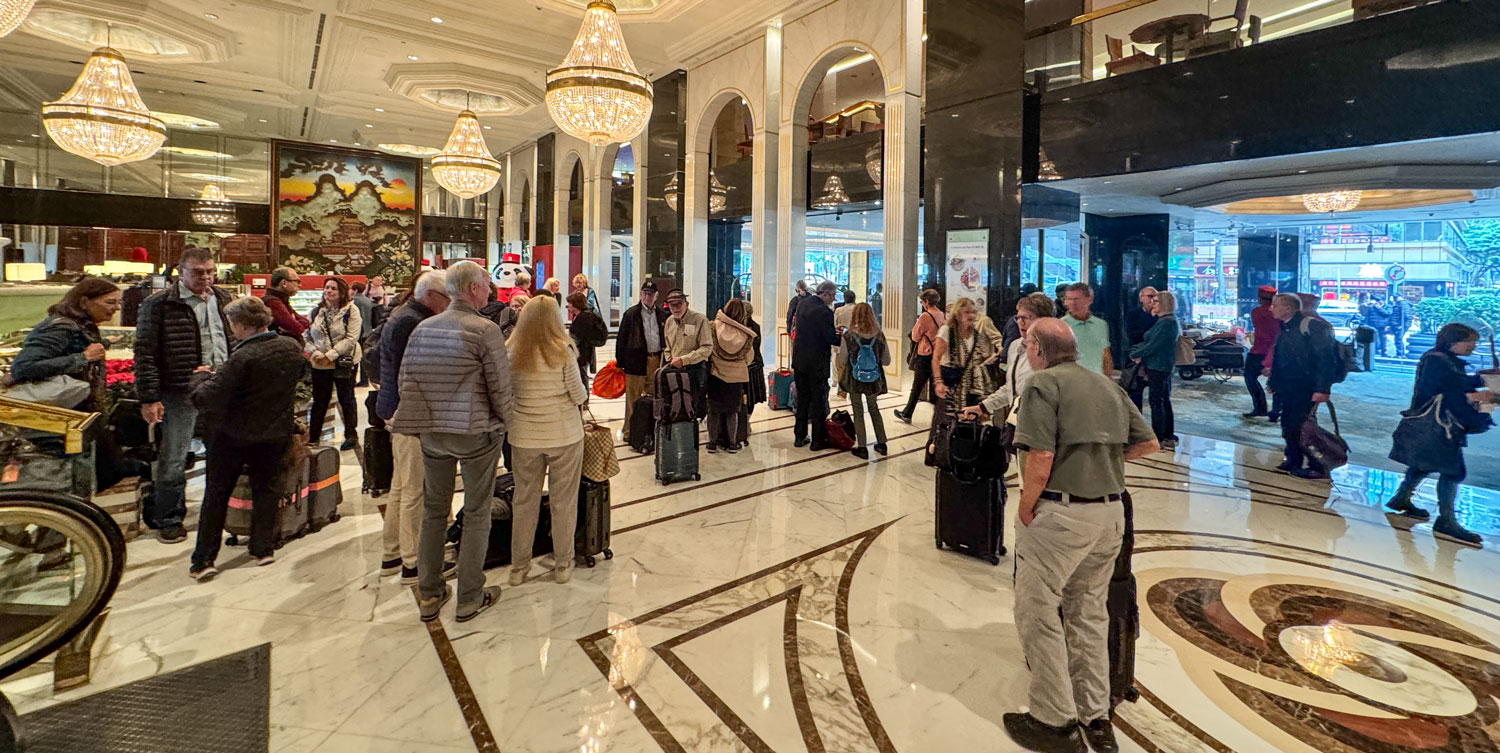
It was a short ride to the port, where we went through a perfunctory security check and then boarded the ship, where we got our cabin keys.
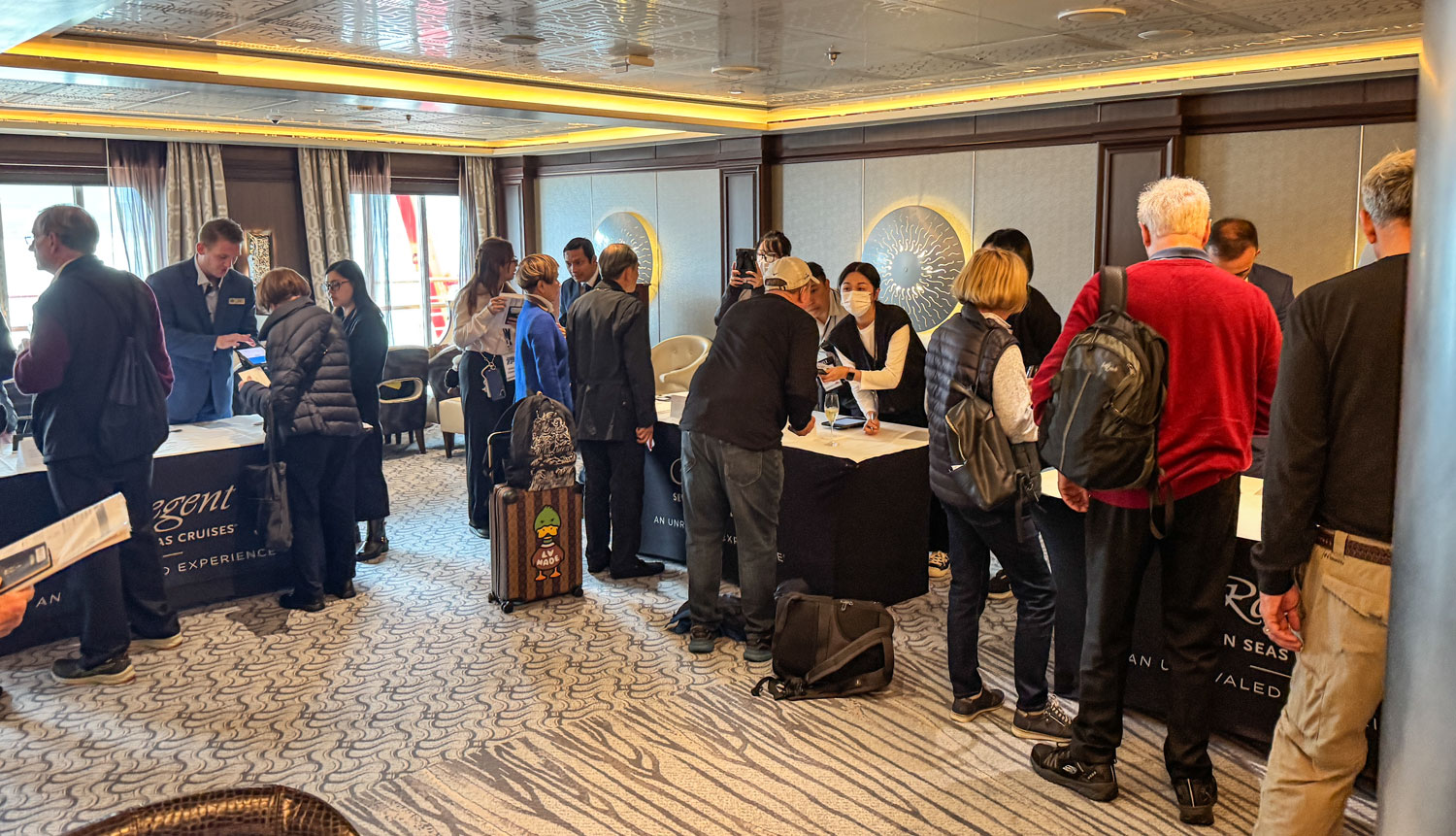
A story about our cabin. We signed up for this cruise very early and chose cabin 1402, a Penthouse Suite. There are only a few cabins on the 14th deck so they go fast.
However, Regent offered an auction for an upgrade. I was very satisfied with 1402 but I put in a minimal bid for an upgrade, and - surprise - we got upgraded to cabin 702, a Seven Seas Suite, which is one level higher than a penthouse suite. However, we were to later find out why that suite was available for upgrade.
Here are a few pictures of cabin 702. The cabin consists of two rooms, a sitting room and a bedroom, plus a fairly large bathroom. Here's the sitting room.
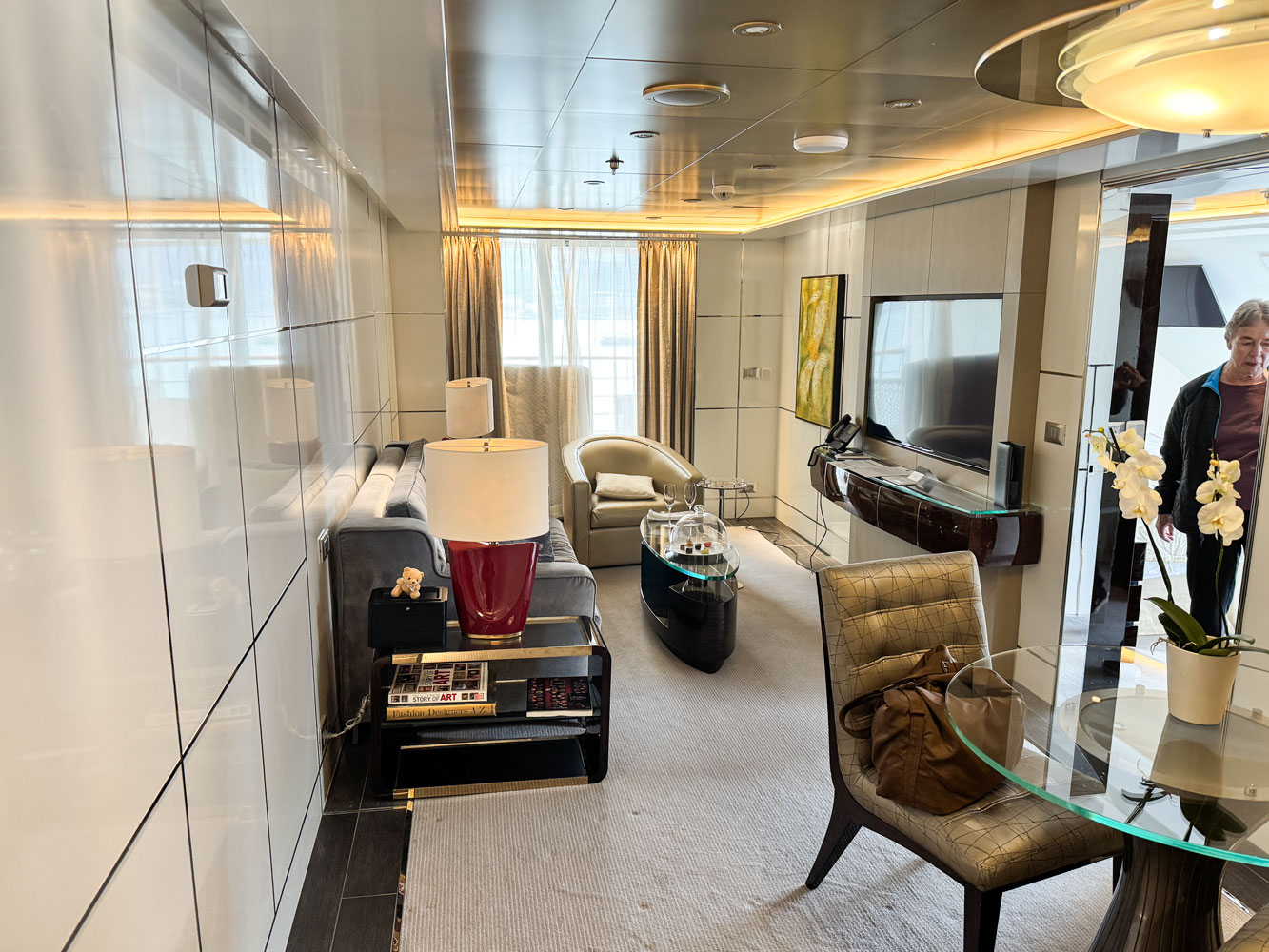
The bedroom. Note the sloping wall. This cabin is facing forward.
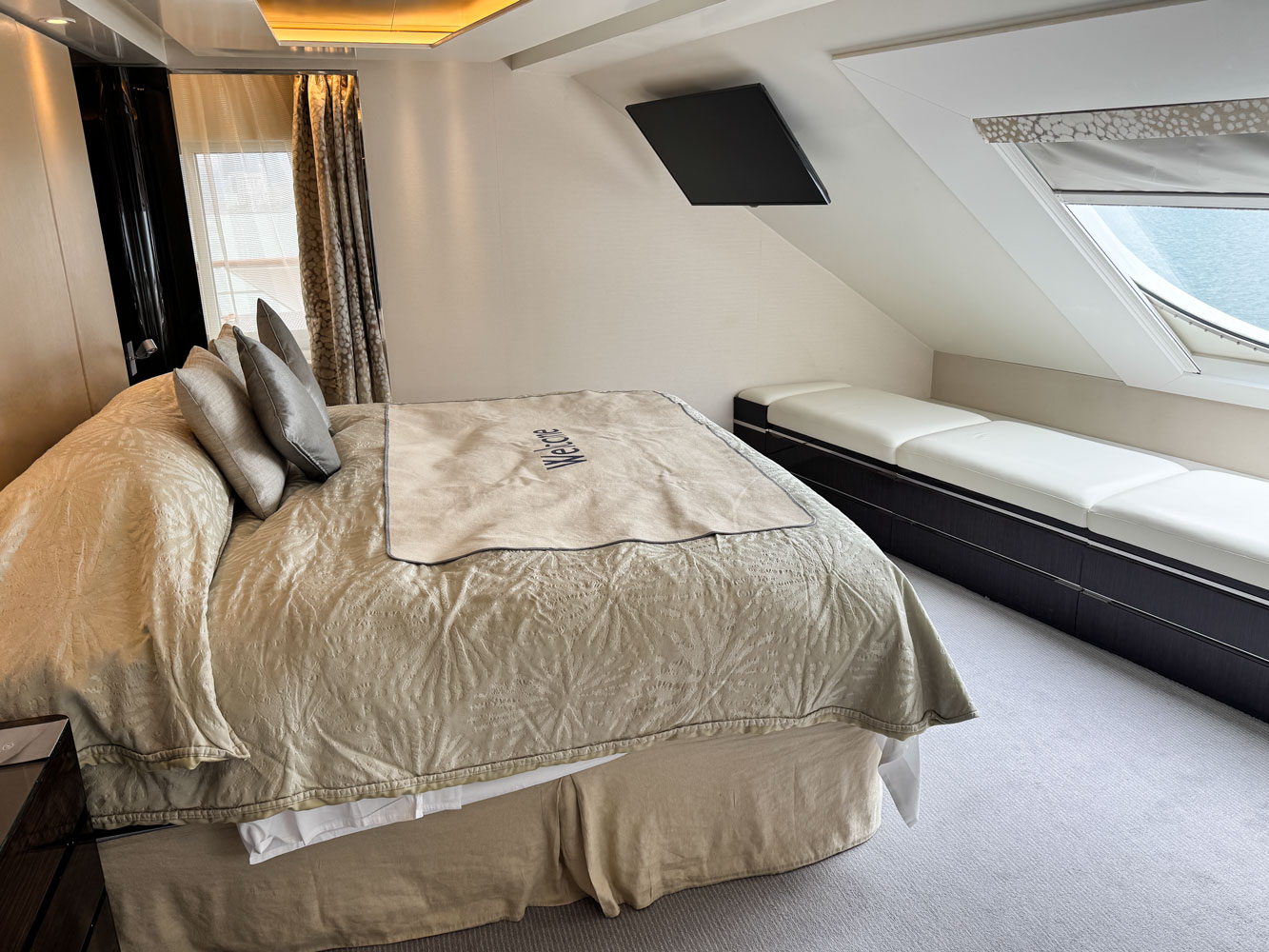
And the bath. There's a shower on the left side of the picture, and the toilet on the right side of the picture. Not shown is a tub along the left side.
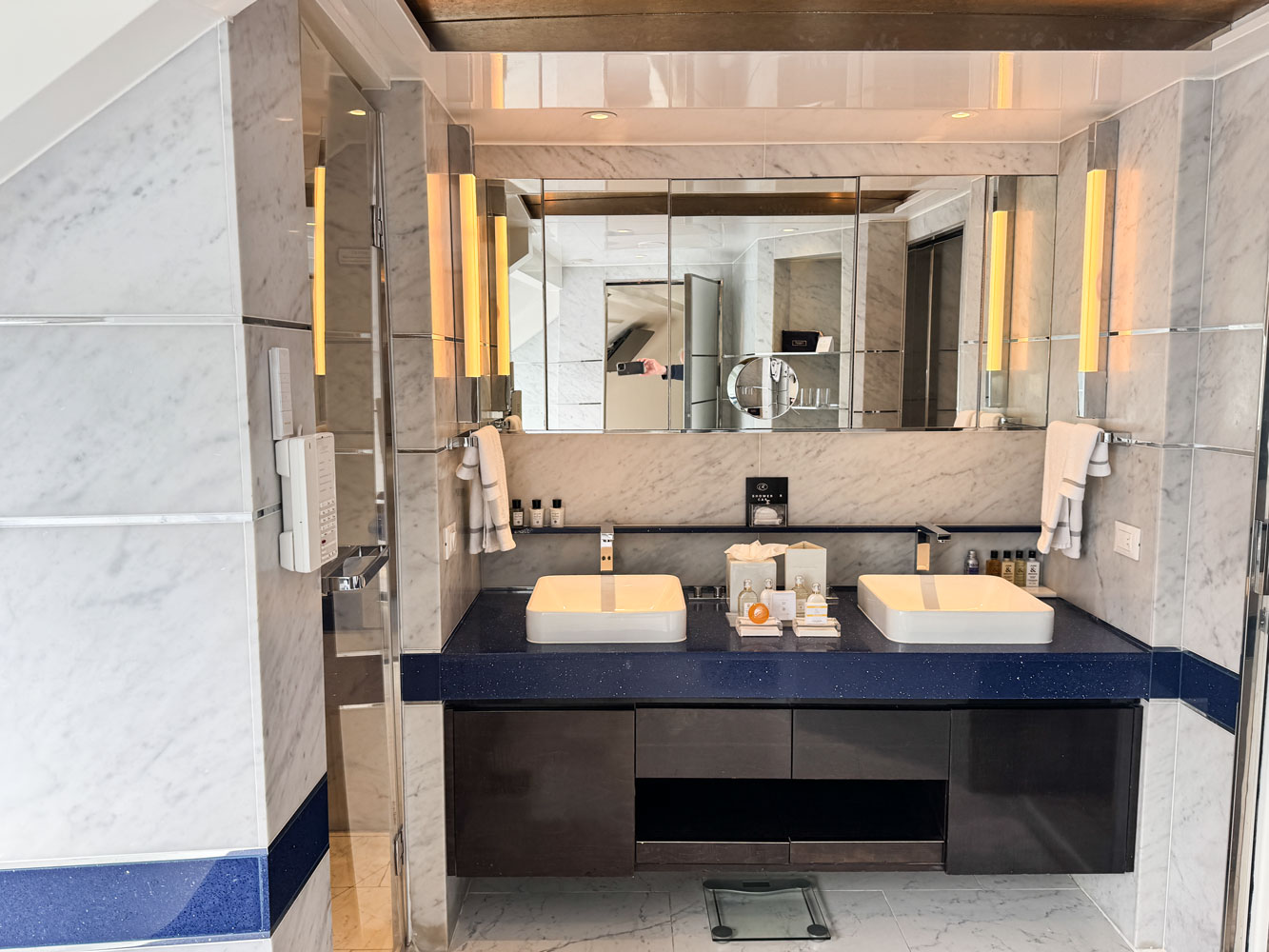
There's also a large balcony which is unusable on this cruise because of the weather.
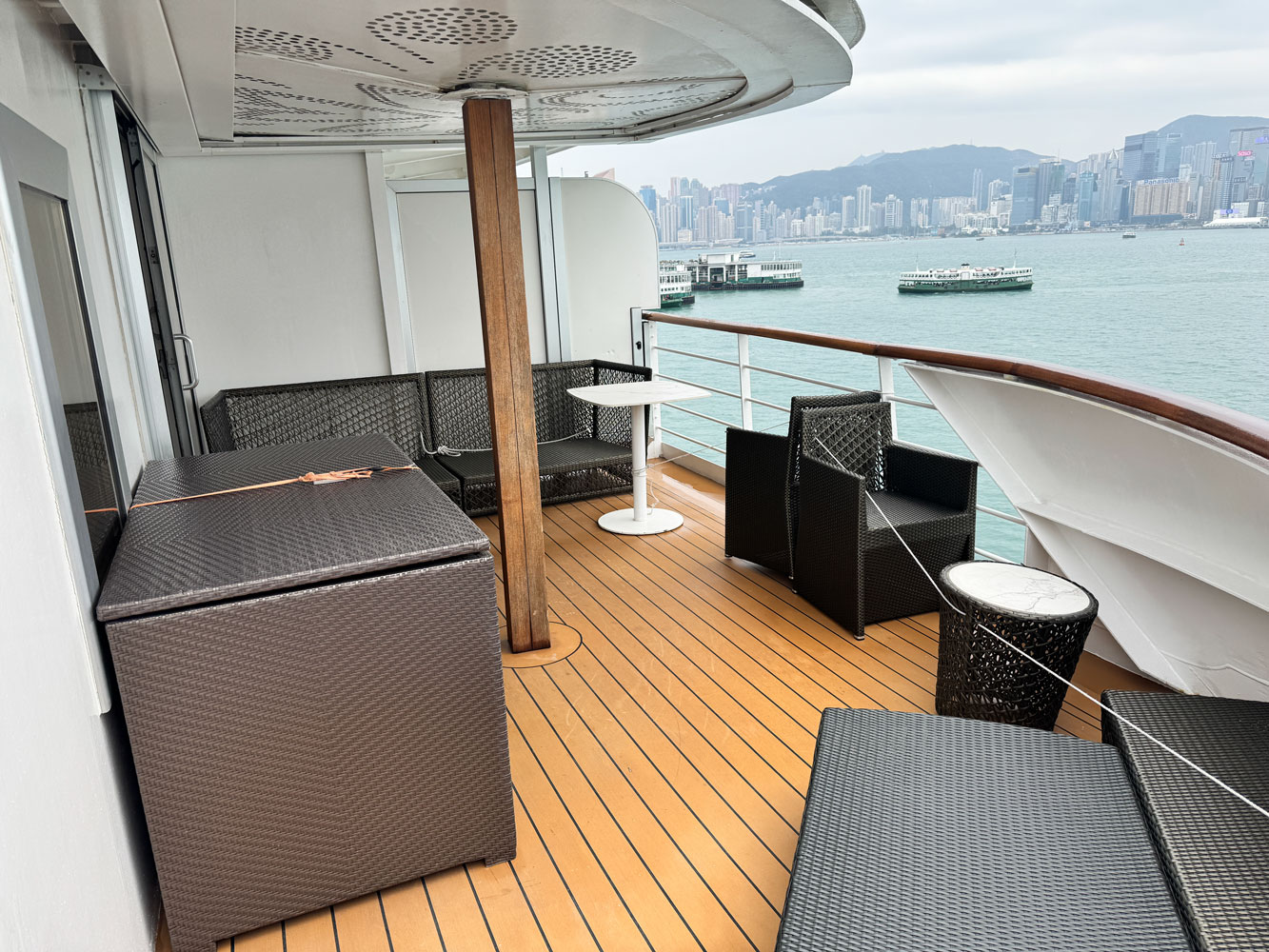
The butler, Aditya, came by to introduce himself. He's from India, and is difficult to understand because of his accent.

He poured some champagne for us.

Our cabin attendant, Maricel, came by a bit later to introduce herself.
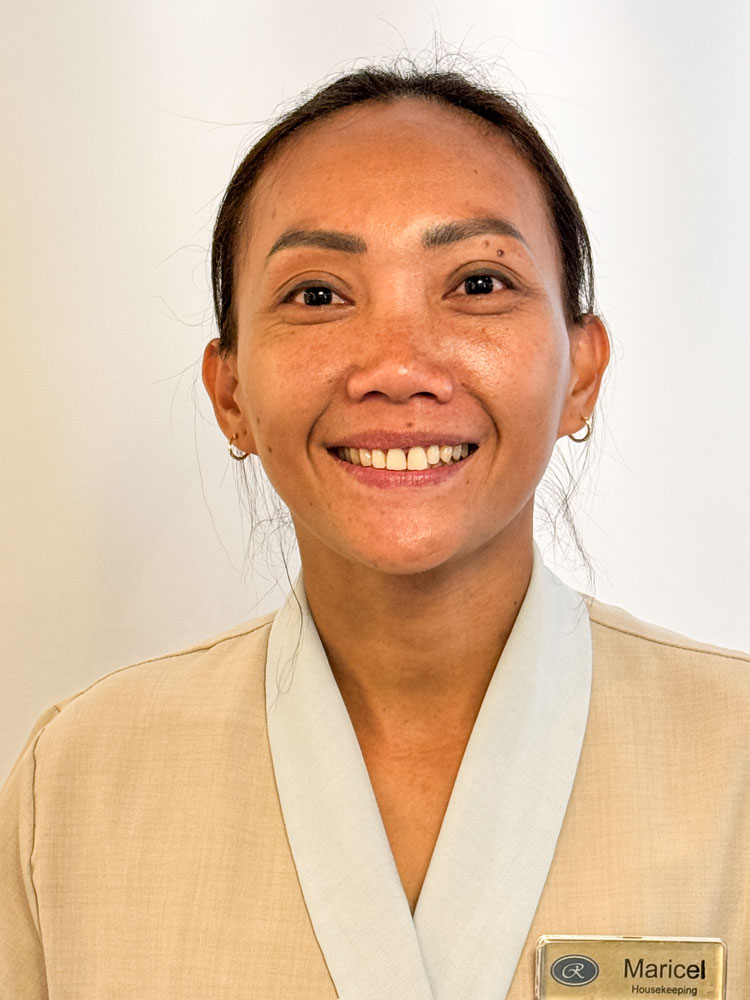
There wasn't anything more scheduled for that day, except dinner. The ship departed about 7pm, and that's when the trouble started.
After the ship departed Hong Kong and entered the open sea, there was a "banging" outside our cabin that was quite loud. The sound was not coming from inside the ship, but from the outside, and it occurred about every 20 seconds, or whenever the ship met a wave head-on. The seas were heavy, and we spent the night sailing into the waves. Each impact created a loud crash, sounding like a wrecking ball, with reverberation. The cabin shook.
Especially for Judy, it was impossible to sleep. I'm hearing impaired so I was able to get some sleep.
+++++++++++++++++++++++++++++++++++++++++++++++++++++++
2/20/2025 (Thursday - a sea day) About 6am I went down to reception and reported the problem. I expected they would respond something like, "I'm sorry you encountered this problem. I don't know yet what we can do, but I'll work the issue and get back to you."
The response I received was, "The ship is full. There's nothing I can do." They just wanted me to go away.
Judy and I went back to reception later and reported the problem again and received the same response. So we went to the General Manager and Judy really lit into him, describing the sound, and reminding him that we were repeat Regent customers, with over 100 nights on their ships, and one thing we expected was to be able to sleep. But he didn't respond in any positive way. It seemed like he also just wanted us to go away and not bother him.
During the day, we continued to check in with the staff to see if they could offer any solution, but their attitude was always, "Not my area of responsibility. See someone else."
I left hand written notes for the General Manager asking for a status update but never received any response.
We were very upset by the "Go away" attitude of the staff. No one would talk with us about the problem or even say that the issue was being worked on. I'm convinced that if we hadn't continued to push on them nothing would have been done.
Finally, at 4pm we met with the Executive Concierge, Thay, who offered us another cabin (764) to sleep in. We gladly accepted. Here's a picture of Thay. I promised I wouldn't put his picture on the wall of shame:-)
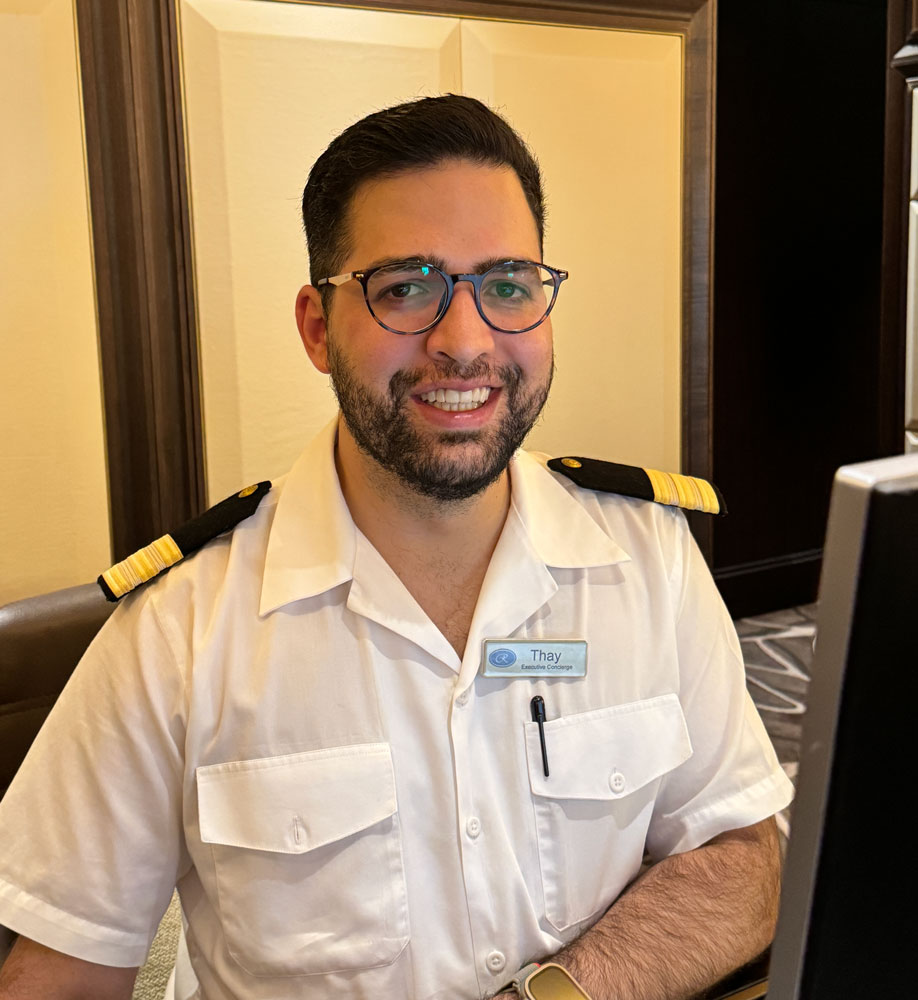
The offer of another cabin was a real relief to us. We didn't understand why three previous pleas had been answered with "nothing else is available".
A side note: The Explorer is not a new ship - it was launched in 2016. The ship has obviously sailed in rough seas before and I'm sure the forward cabins have experienced the same noise as we did. Perhaps the best solution was not to sell those forward cabins if there's a probability of high seas, or at least make a mention of the possibility of noise, but I suppose that's too much to ask.
Alternatively, the staff should be prepared to address the guests' complaints when the noise occurs. They should have a Standard Operating Procedure (SOP) for the reception people to use when this occurs.
For us, lesson learned. Don't ever get a cabin forward again - stay in the middle of the ship.
[Update 2/24/2025 Regent does a mid-cruise survey and we complained about the noise. Today, we got a call from the Executive Concierge, and they are giving us a credit of $1,500 per person ($3,000 total) on a future Regent cruise. We have a Regent cruise to Norway scheduled for this fall, so we'll apply it to that cruise. I thought that was very nice of Regent.]
After this was settled, our next event was the Captain's Reception at 6pm, where we met the captain and he introduced us to his staff.
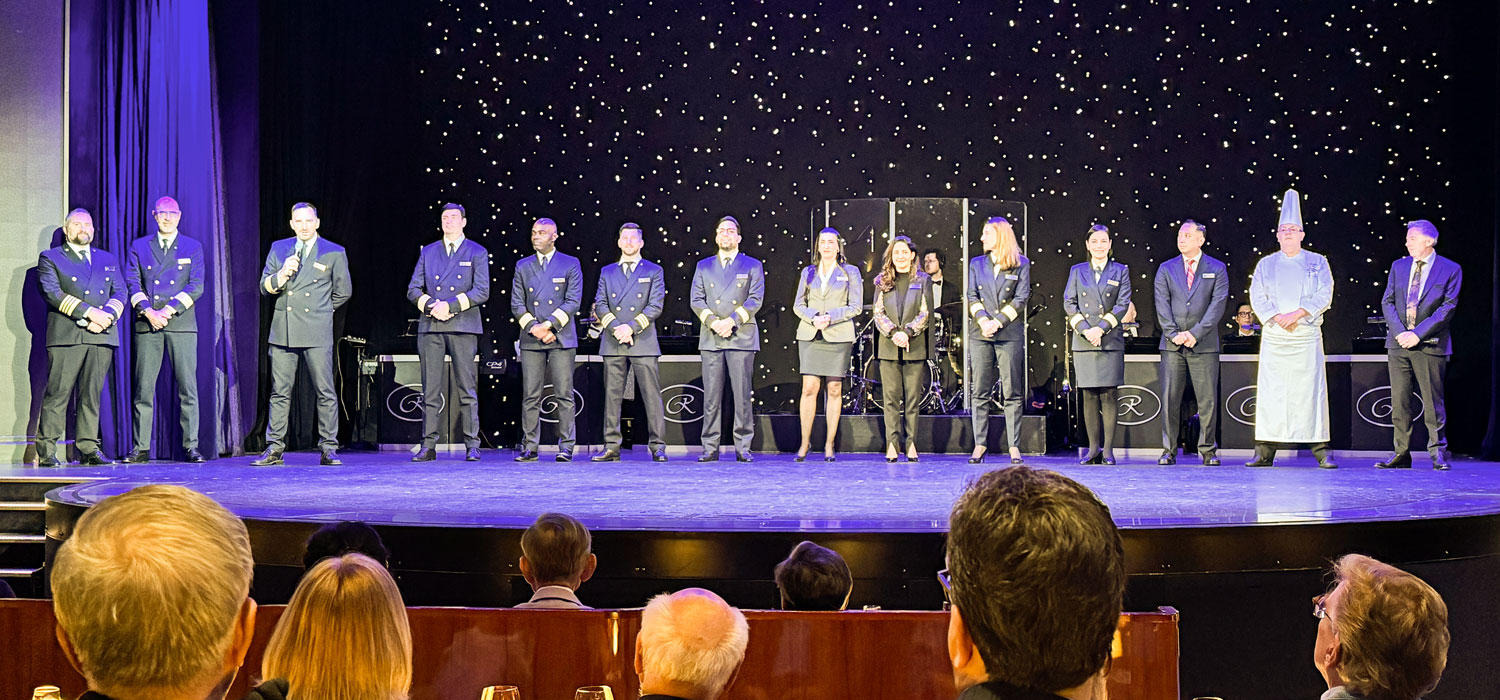
After that, we had dinner in the Chartreuse restaurant, then it was to bed in Cabin 764 where we welcomed a good night's sleep.
+++++++++++++++++++++++++++++++++++++++++++++++++++++++
2/21/2025 (Friday) We arrived in Taipei this morning. Judy and I are taking an "Highlights of Taipei" excursion.
After breakfast we met in the theater at 9am to check in for our tour, and then went to the bus.
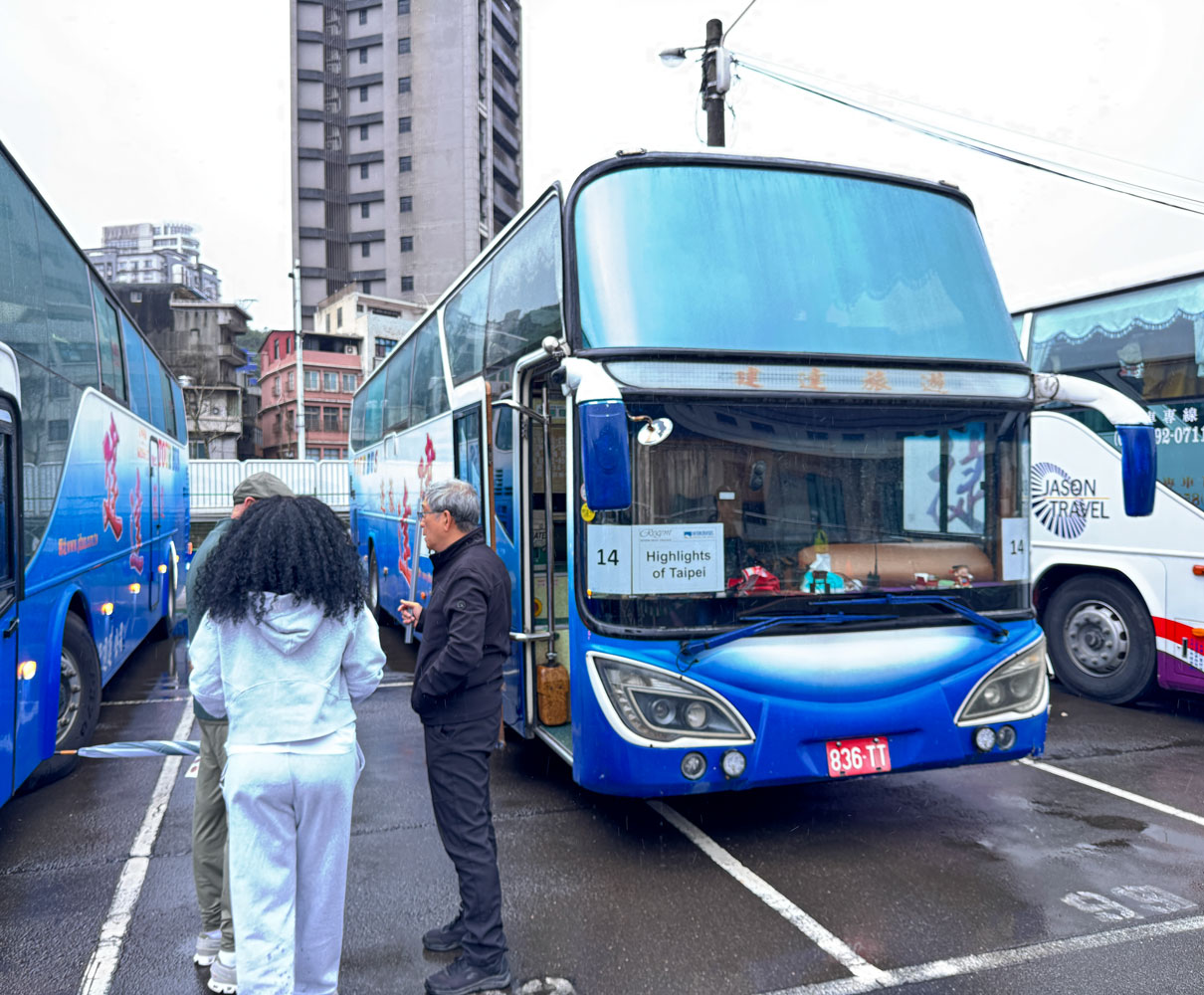
We're going to the National Palace Museum first. The museum was first established in the Forbidden City in Beijing in 1925. The items in the museum consisted of valuables of the former Imperial family. The last emperor, Puyi, was overthrown in 1924.
[Bernardo Bertolucci made the 1987 film, "The Last Emperor" about Puyi. It wasn't that good of a film but can give you some history of that time period in China.]
In 1931, Japan attacked China. The Chinese did not want the valuables to fall into the hands of the Japanese so, in 1933, they moved about 20,000 crates of objects to Shanghai. In 1936, in response to advances by the Japanese army, the crates were moved to Nanjing. There was some other movement but I won't try to describe it all.
After WWII, the China Civil War began. The Nationalists had control of the collection and in 1948, as the war turned against them, they shipped 2,972 crates of the best and most important items of the collection to Taiwan, only about 22% of the items originally sent to Shanghai.
A portion of those items are what we'll see at the museum.
As we drove to the museum, I was struck by the difference in Taipei compared to Hong Kong and Xi'an. It's obvious that Taipei is not as wealthy as those two cities in China.
However, Taiwan is the home of Taiwan Semiconductor Manufacturing Company (always referred to as TSMC). TSMC manufactures semiconductors (known as a foundry) for essentially all the major semiconductor product companies in the west. Some of the companies are AMD, Apple, ARM, Broadcom, Qualcomm and NVidia. TSMC has about a 65% market share in the semiconductor foundry business.
If anything happened to TSMC, such as if Taiwan was blockaded by China in an attempt to take over the island, it would have disastrous consequences for western economies. TSMC is building semiconductor fabrication plants (known as fabs) in other countries now to mitigate that possibility. One is in Phoenix, and another is in Japan. There may be others.
Here's a picture of the National Palace Museum, taken from the web.
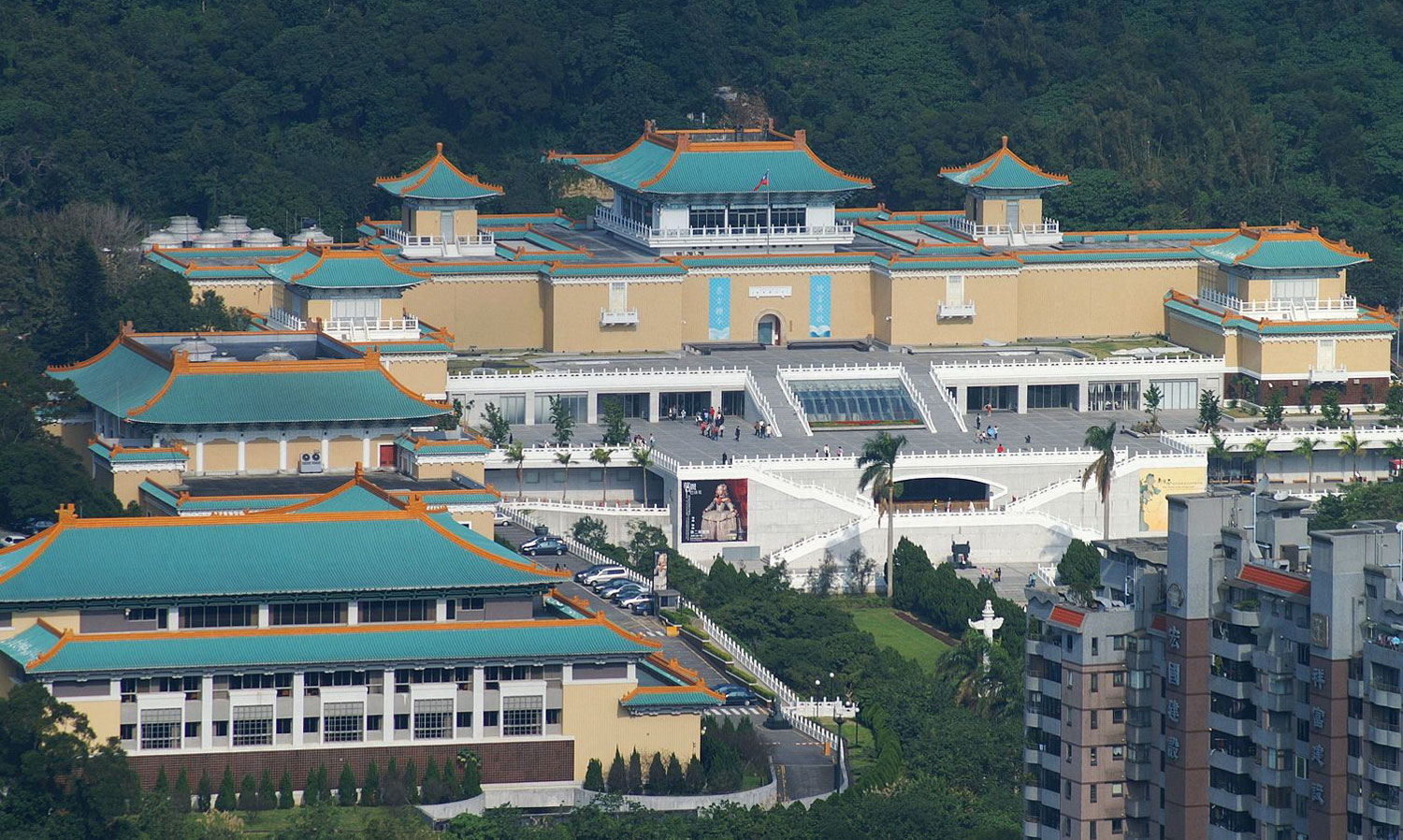
When a group enters the museum, they are "parked" in separate areas. Then a museum employee comes and provides tour guide devices that allow guests to hear the tour guide.
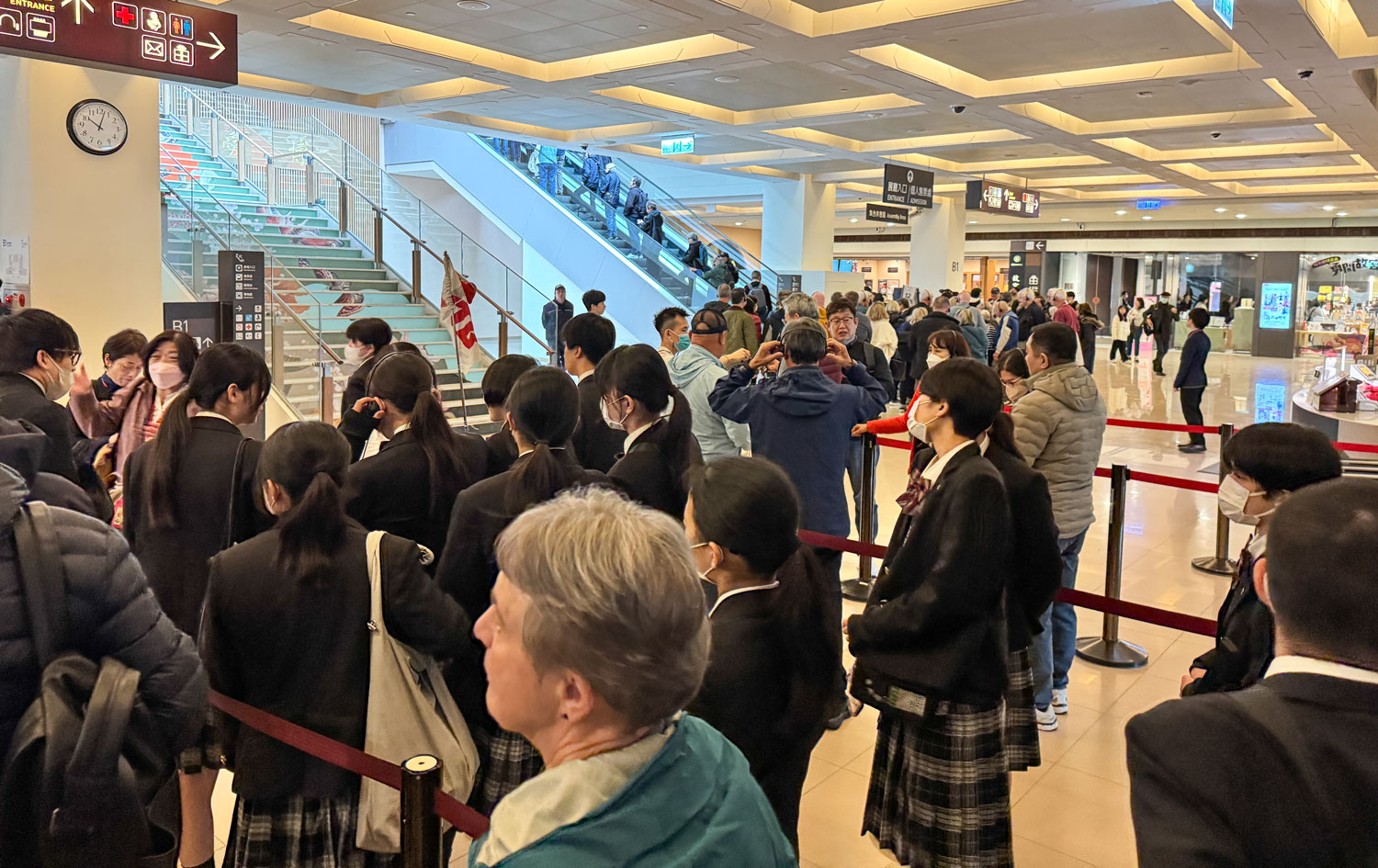
There's a statue of Sun Yat-sen in the lobby. Sun Yat-sen is viewed as the founder of the Republic of China (ROC) and it's first political party, the Kuomintang.

As we first entered the museum, we came to the place where the Jadeite Cabbage is normally displayed. But it was on loan to another museum in southern Taiwan, so all they had were pictures. Here are a few pictures of a reproduction piece. The original was produced some time before 1889 by an unknown sculptor.
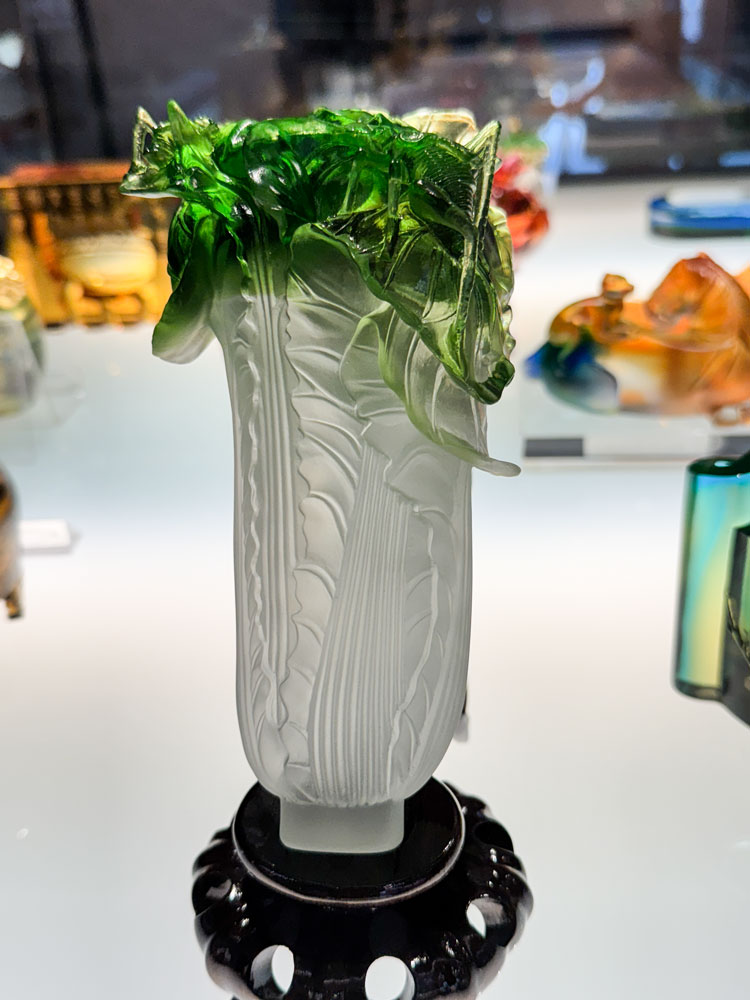
There is a locust and a katydid on the cabbage, but they are difficult to see in pictures.
Here they are. Can you see them?
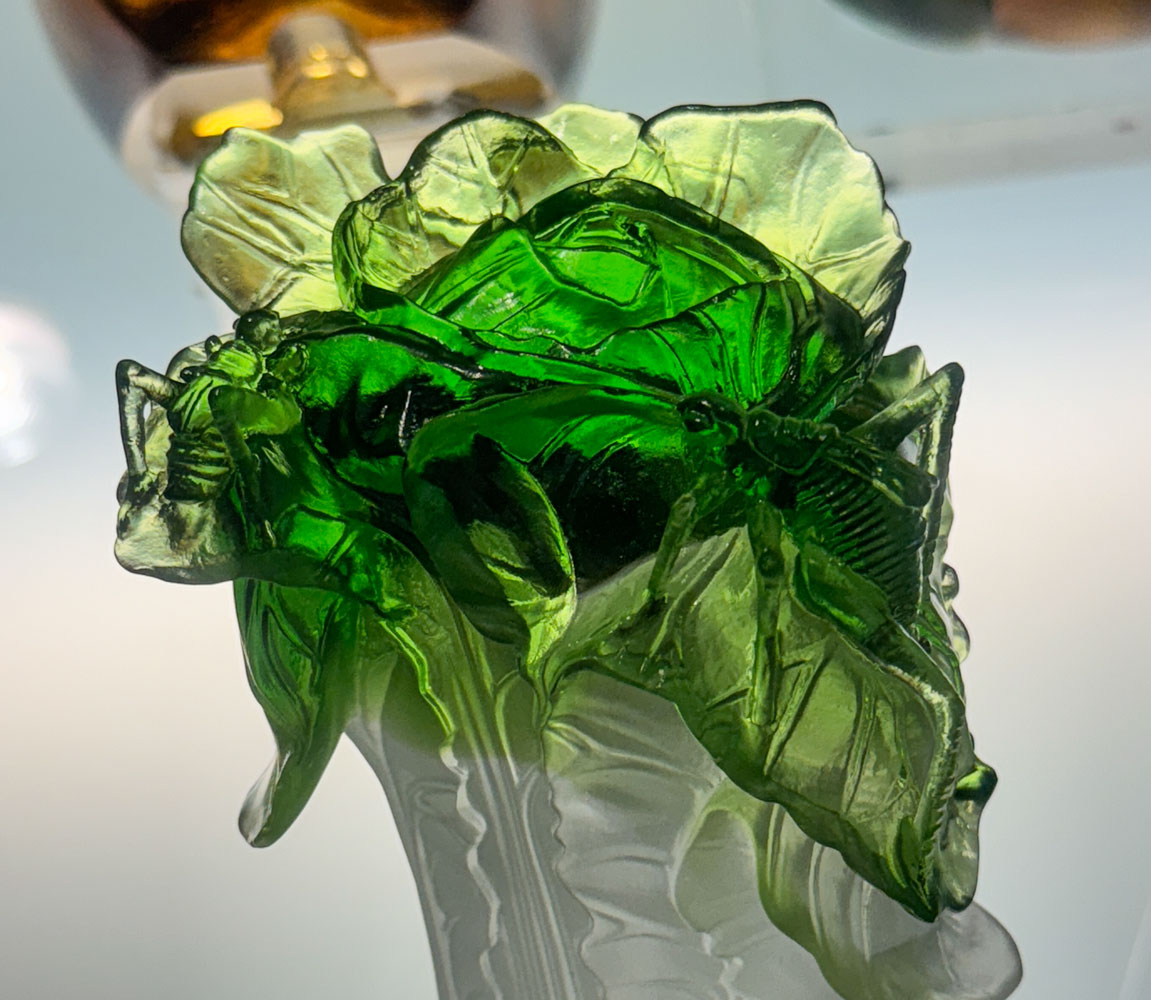
Close up of the locust, on the right.
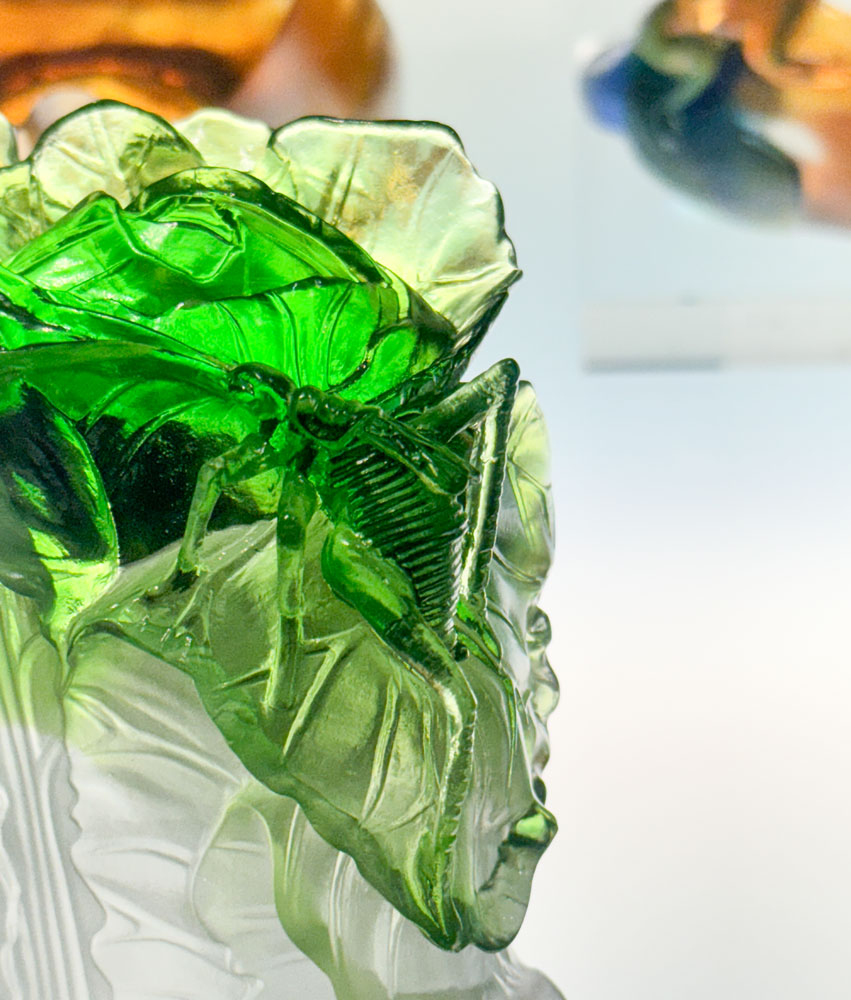
And the katydid on the left.
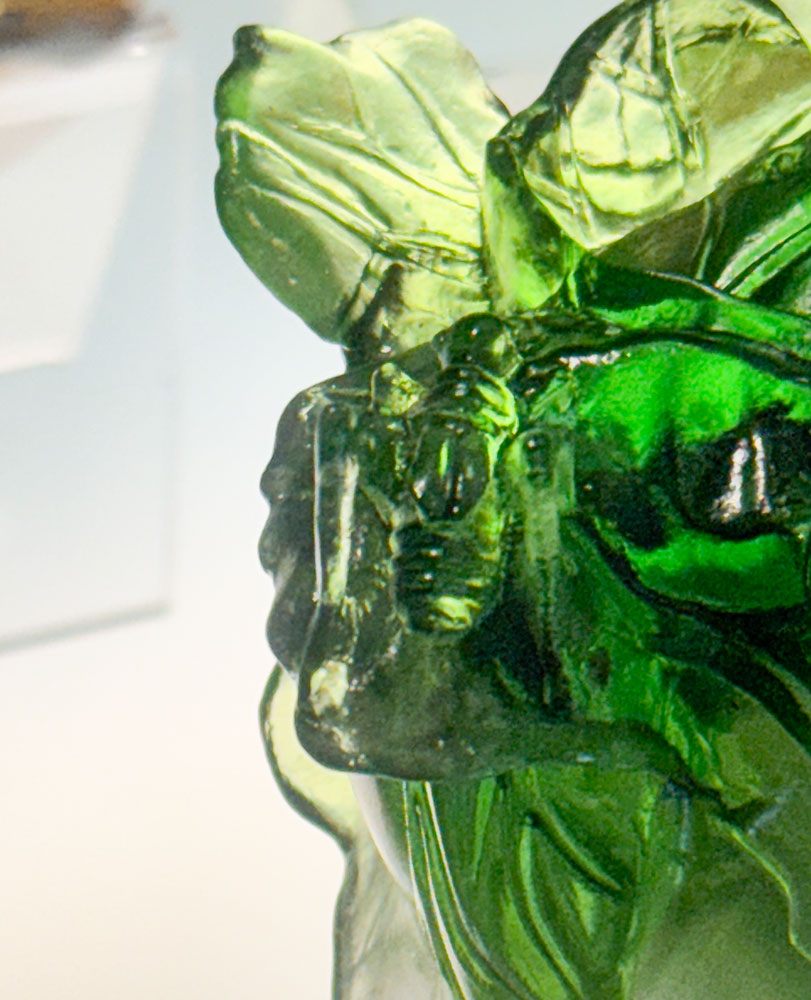
They are fairly easy to see in person.
Another item in the same exhibit area was the Meat Shaped Stone. I'm told that it looks like pork prepared as Dongpo Pork, a popular way of preparing pork belly. The stone was voted by the public as the most important item in the museum's collection. I suppose it has more meaning to someone of the local culture.
The sculptor is unknown. It was produced during the Qing Dynasty but the actual date is unknown.
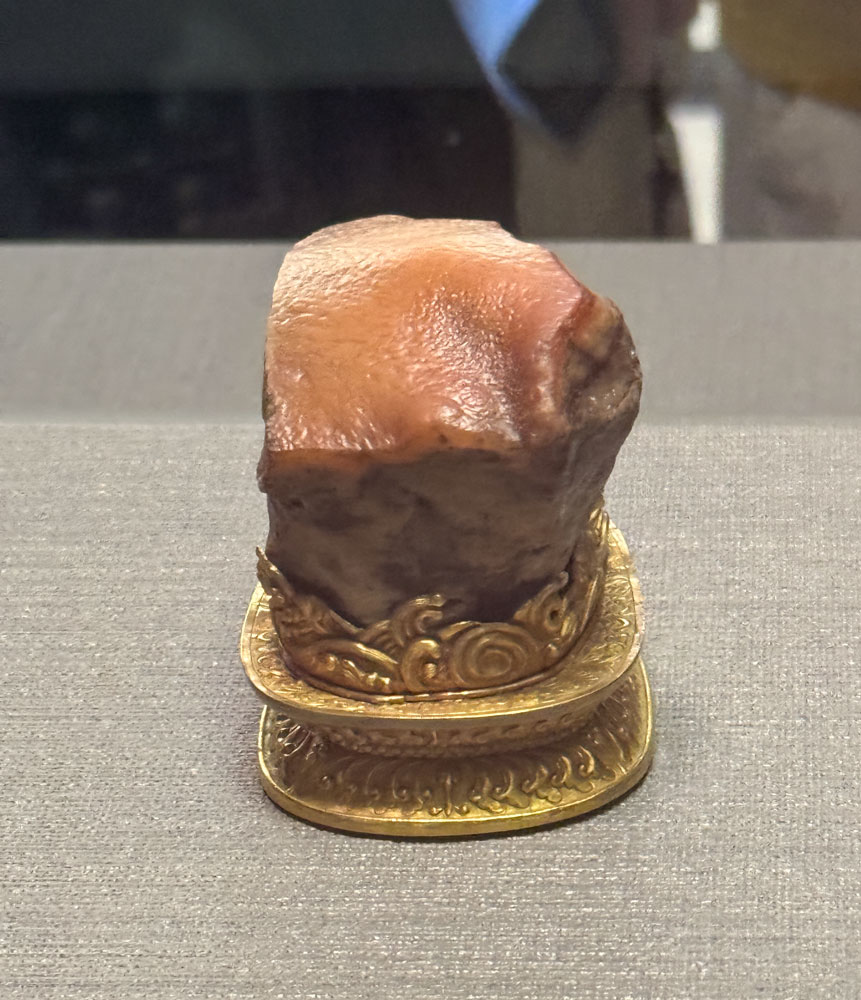
Here's a better picture of it, taken from the web.
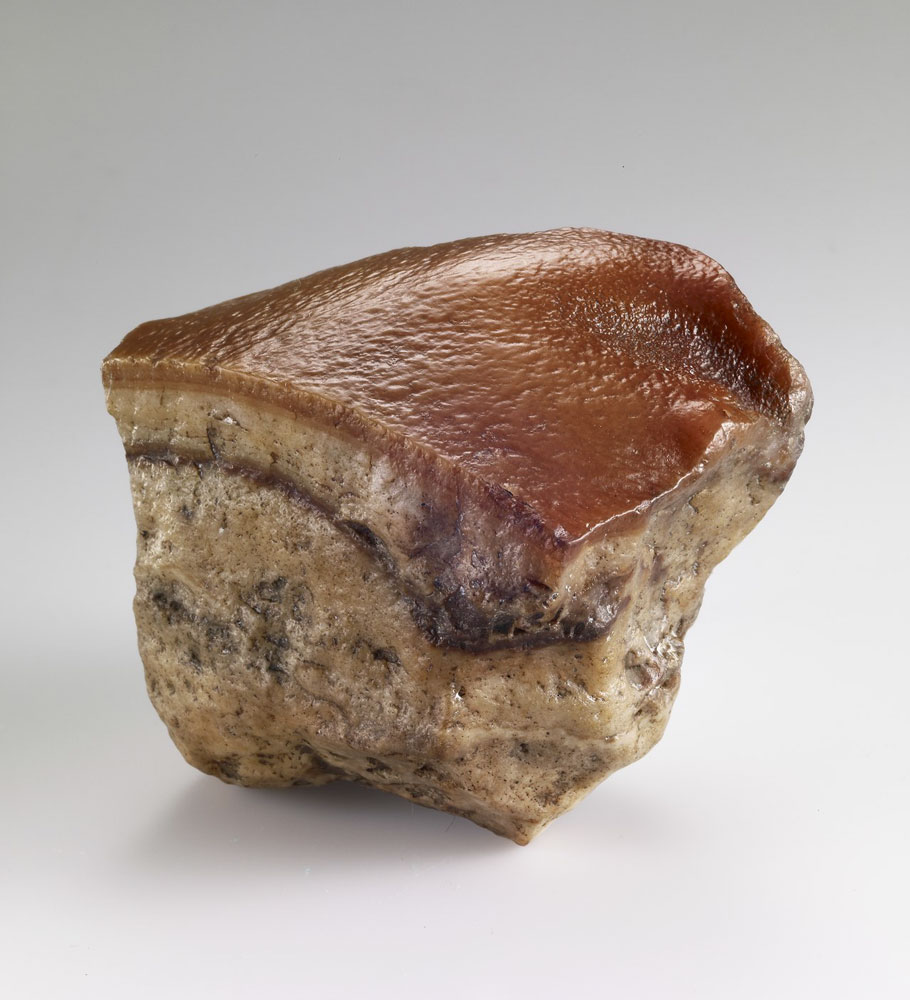
Here's what Dongpo pork looks like. It's pork belly cooked a certain way. The dish obviously goes back many, many years in Chinese cuisine.
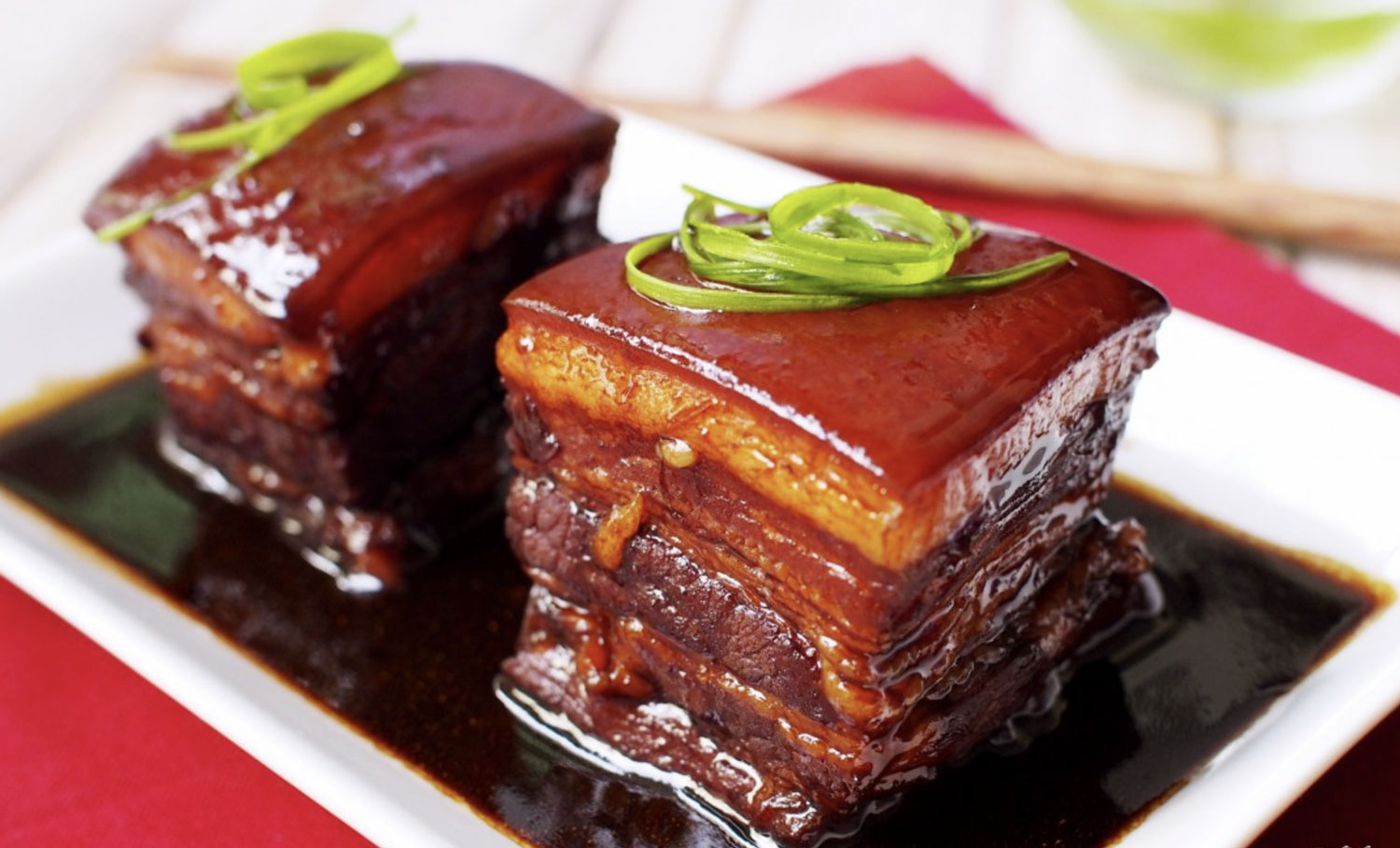
These two items are part of the Three Treasures of the National Palace Museum. The third "treasure" is the Mao Gong ding, a bronze pot that dates back to Western Zhou dynasty (1045 - 772 BC). The importance of the pot is that it contains 500 Chinese characters arranged in 32 lines - one of the earliest inscriptions of Chinese characters.
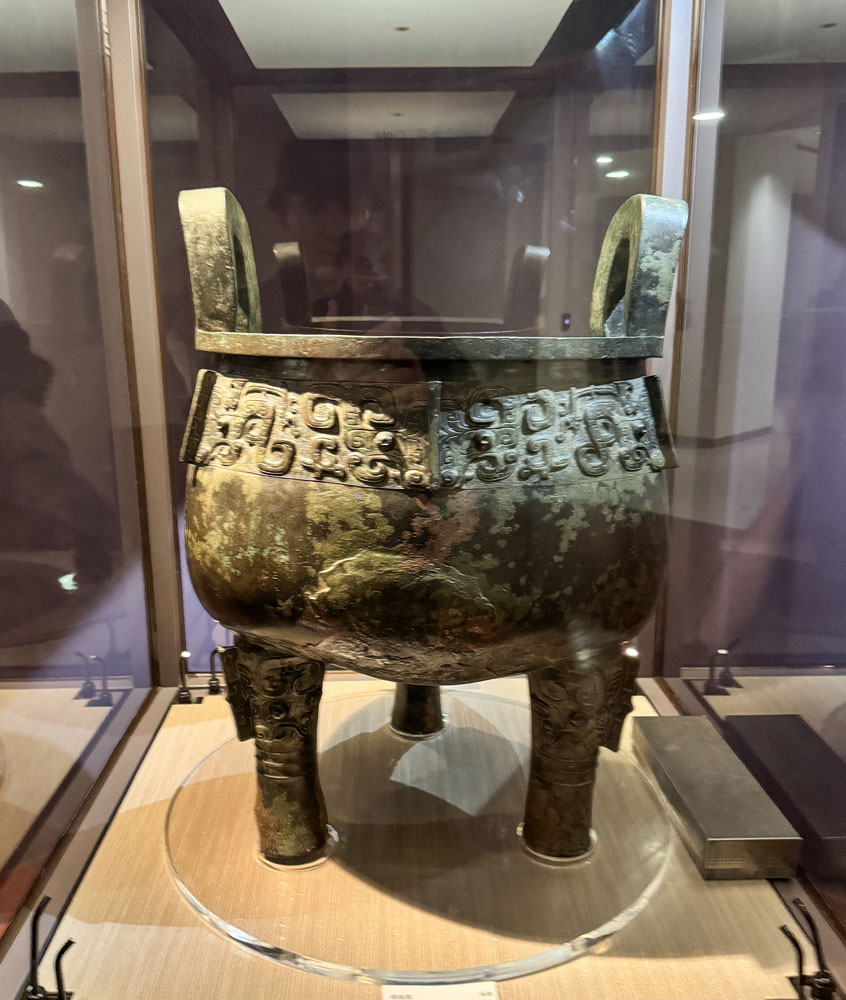
Here's a better picture, from Wikipedia. The inscription is in the inside of the pot. You can just barely see it in this picture.

We saw many other exhibits, and I'll put pictures of a few here.
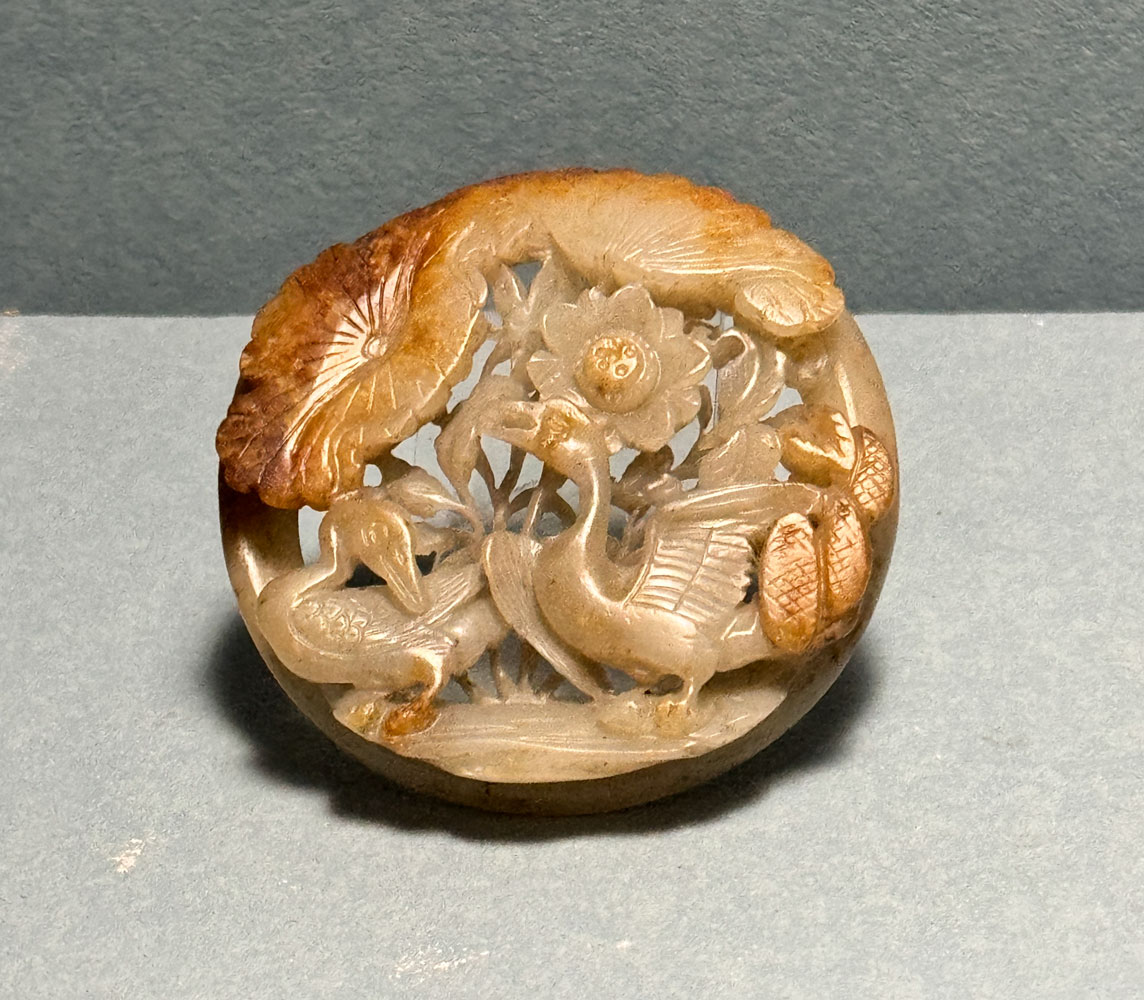
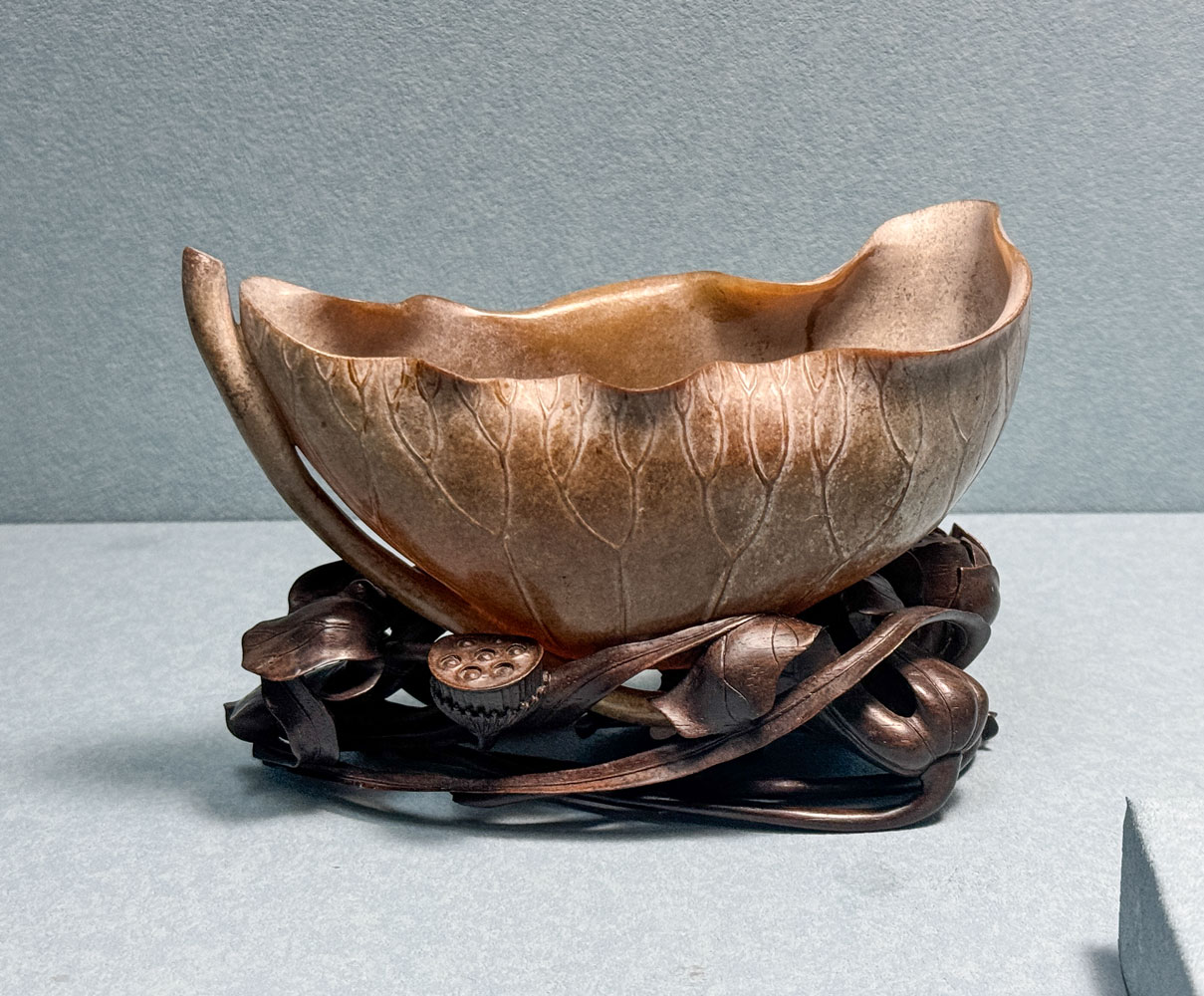
A jade and wood screen. It was behind glass and there are reflections in the glass. This screen was taken by Japan during Japan's occupation of China, but was returned recently.
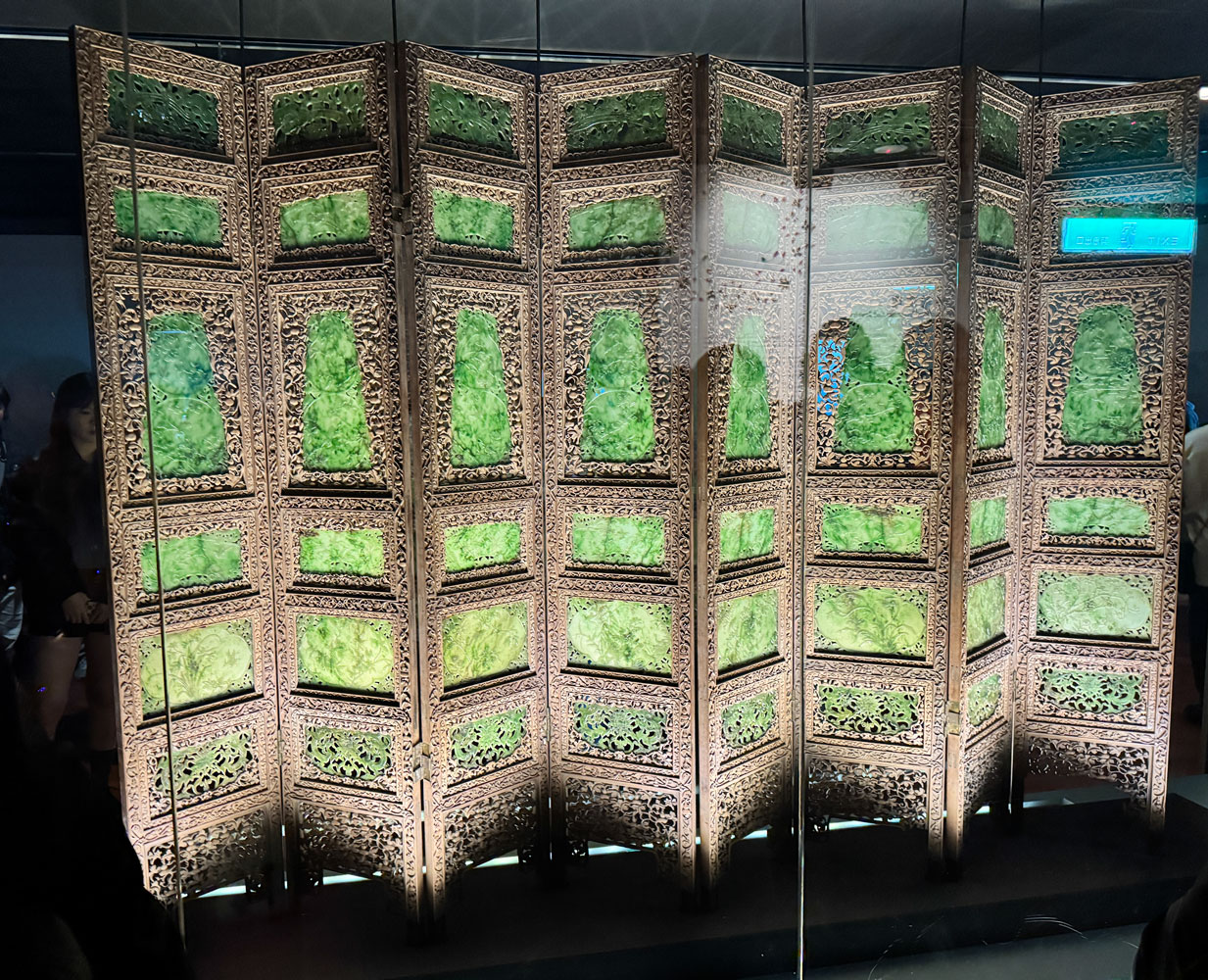
Another early pot with Chinese characters inscribed in the inside of the pot.
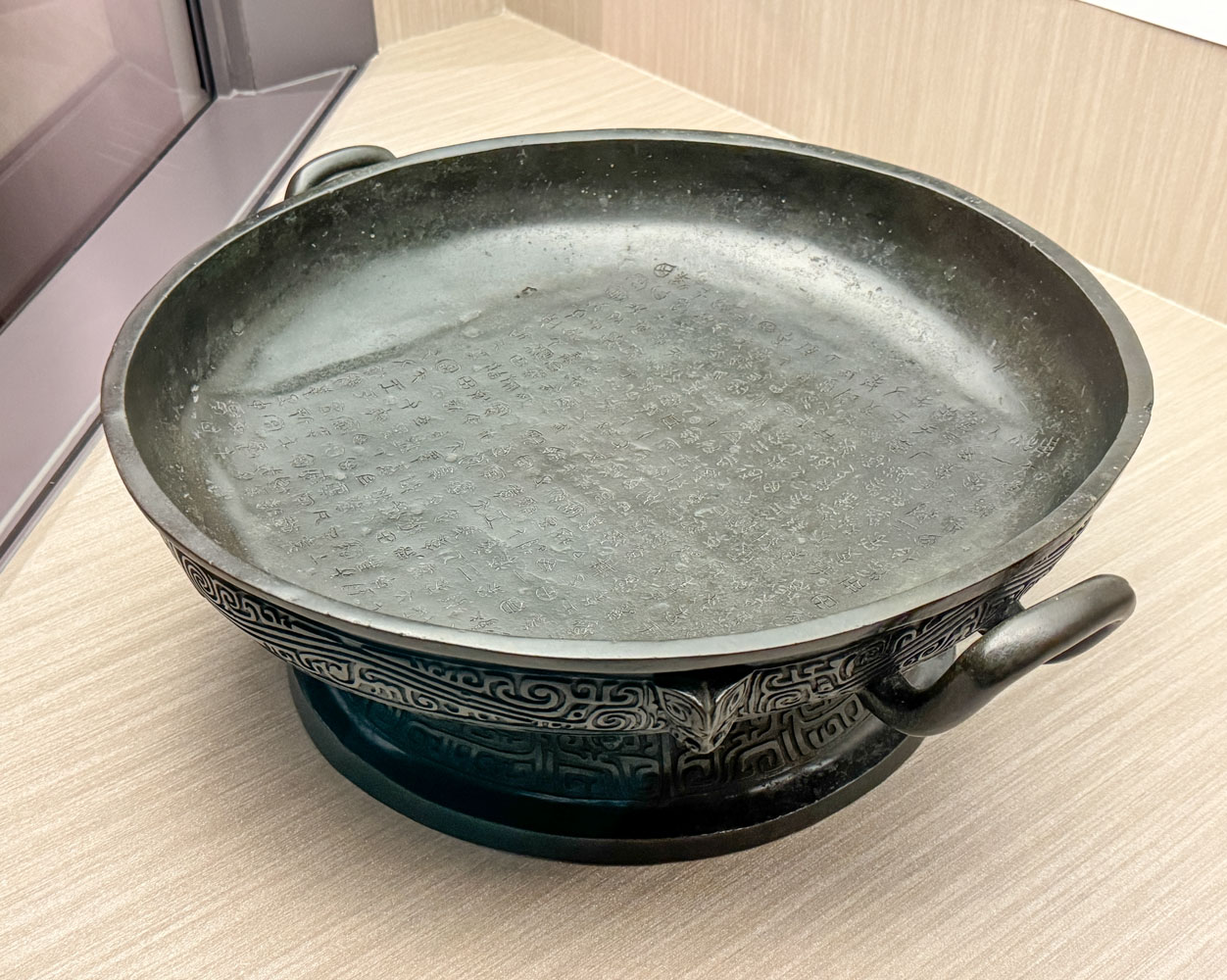
A bronze bell.

These statues of pigs were made during the Western Han period (206 BC to 9 AD) and have been studied by biologists for hints to the evolution of pigs.
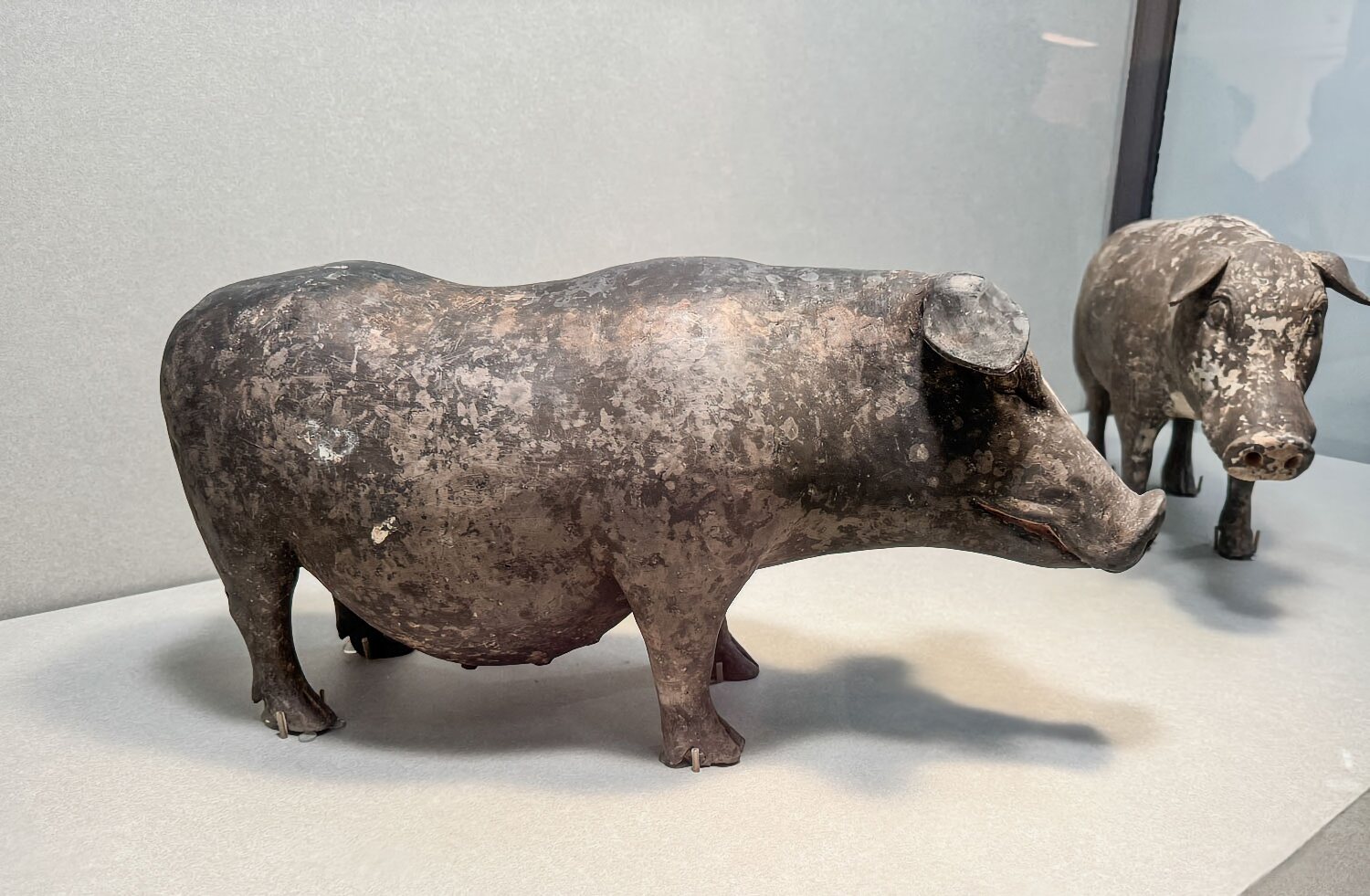
This dog statue has also been studied for the same reason.
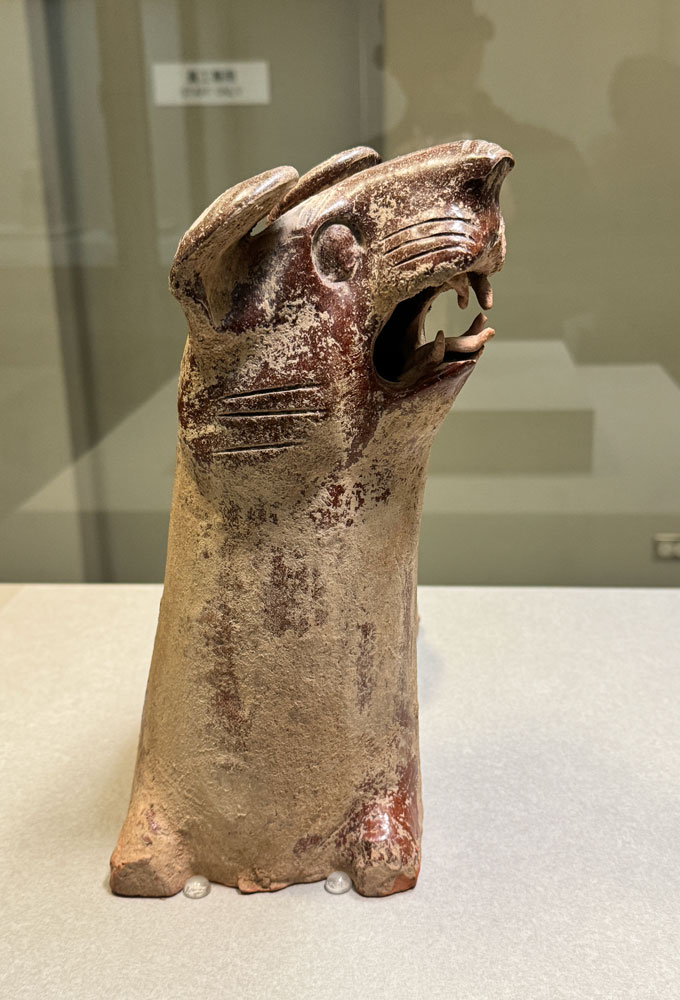
I'm told that this is a Lokapola.

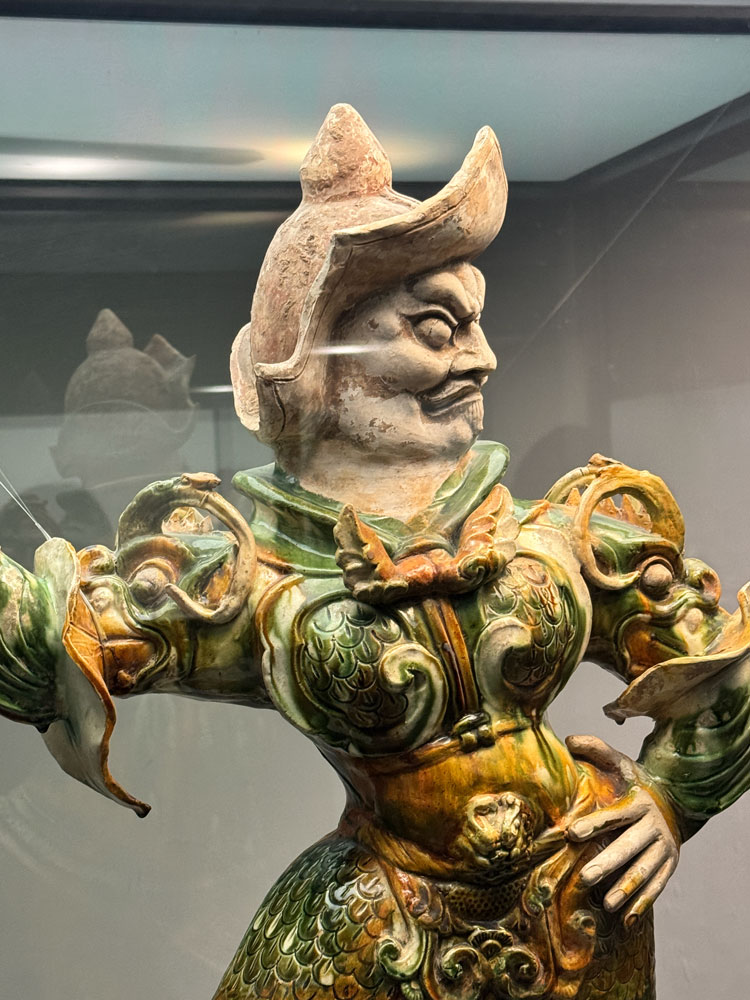

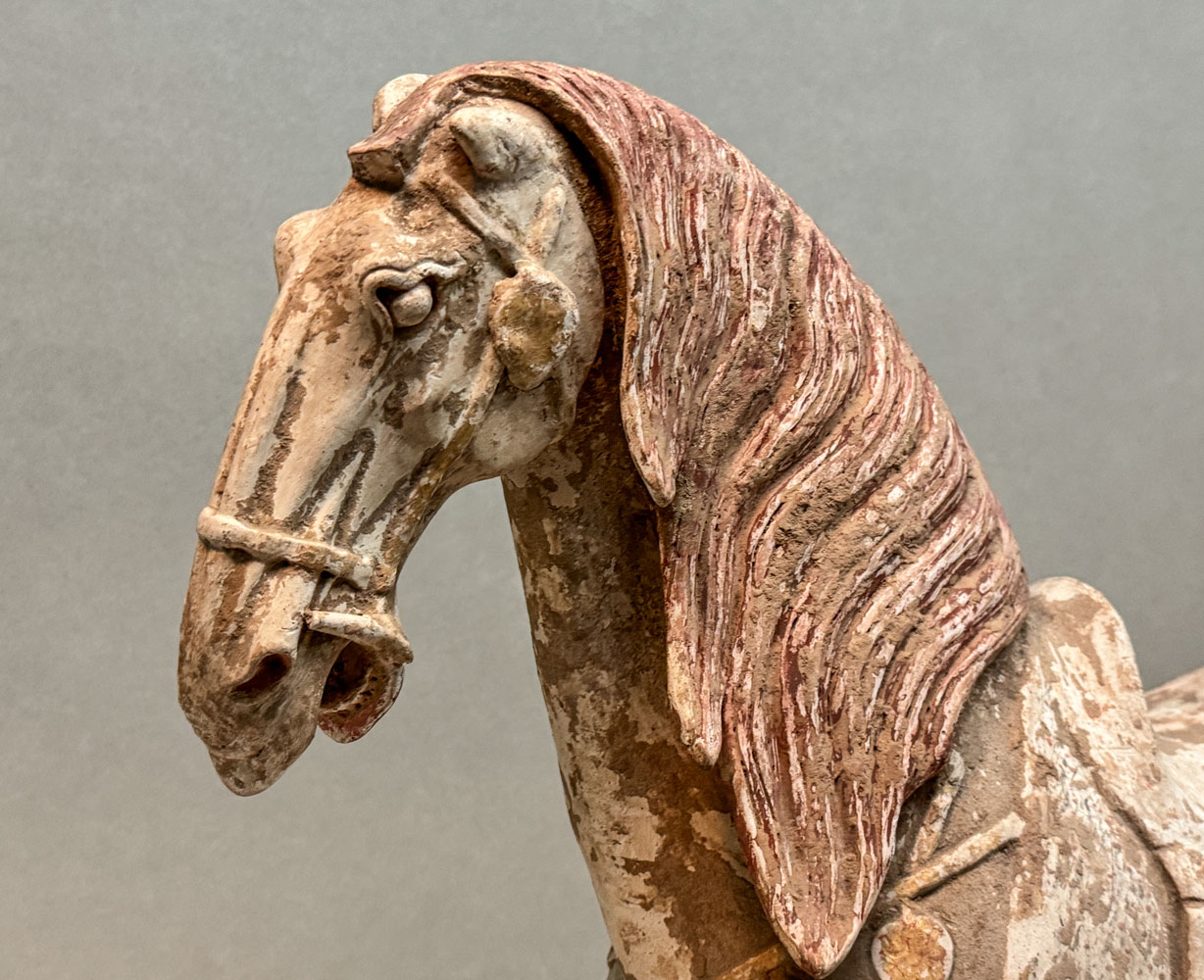
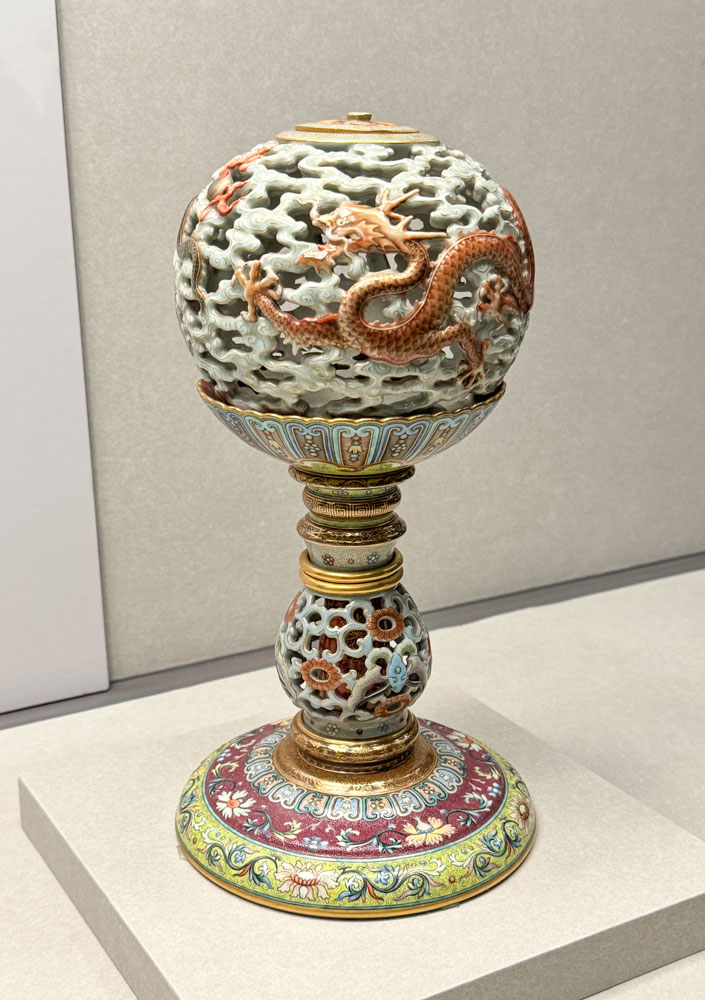
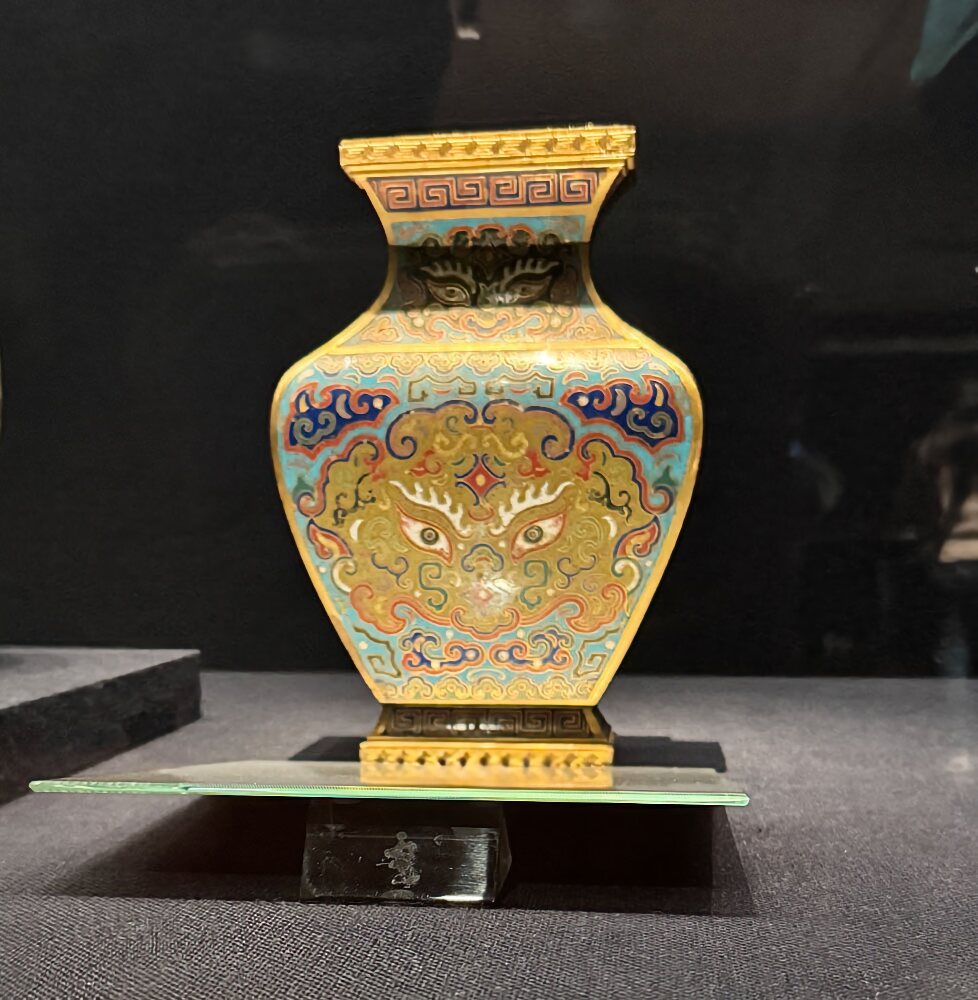
There were, of course, many, many more exhibits in the museum but you'll have to visit the museum to see them yourself. Judy visited this museum about 40 years ago, and has always remembered it as one of the most interesting museums she has ever seen.
We left the museum about noon and went to the Chiang Kai-Shek Memorial Hall. The memorial hall is actually the structure in the distance, seen through the arch of the entrance gate.
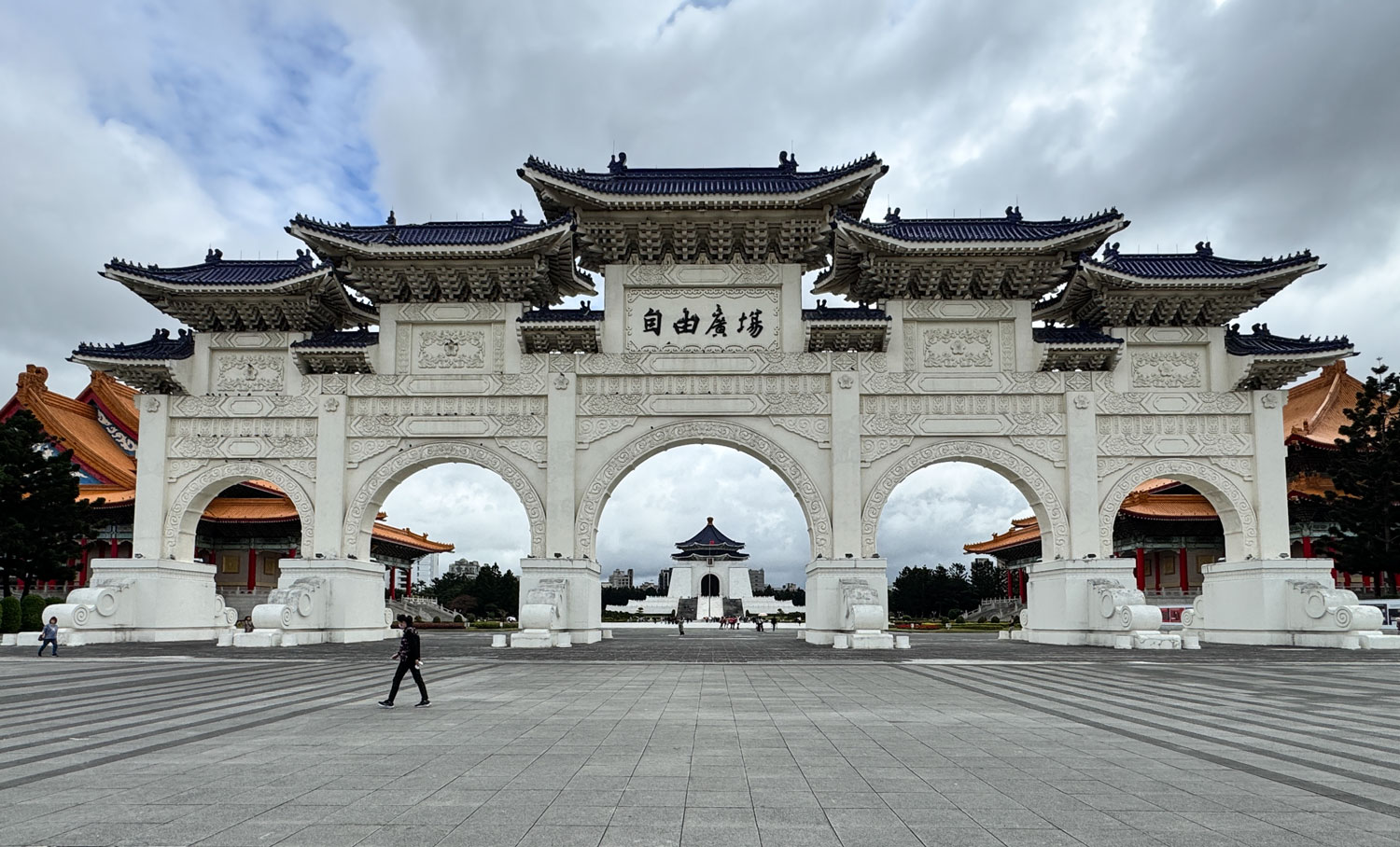
Here's a closer view through the arch of the entrance gate.
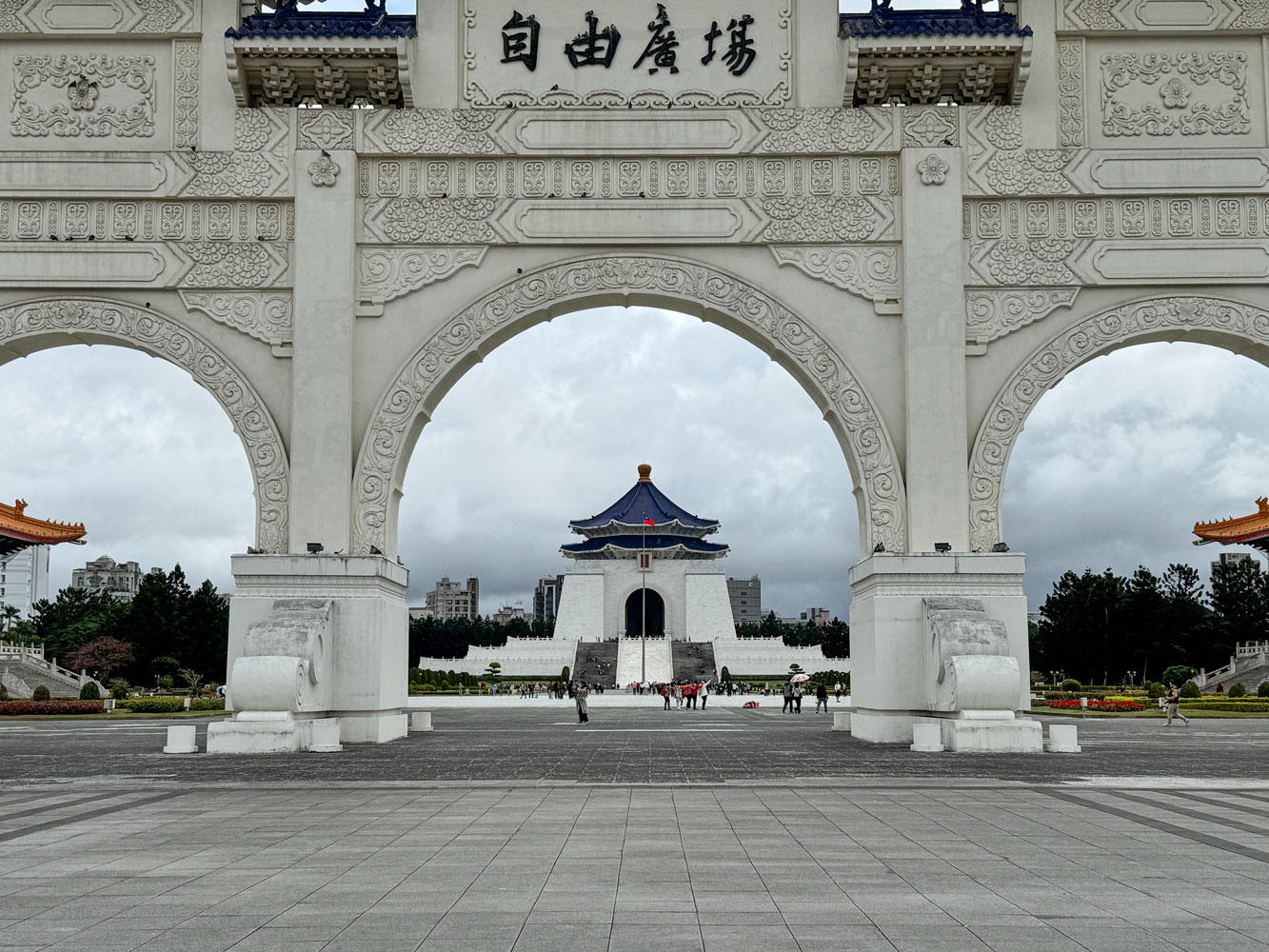
Beyond the gate is a large courtyard, with the National Theater on one side and the National Concert Hall on the other. Here's the National Theater.
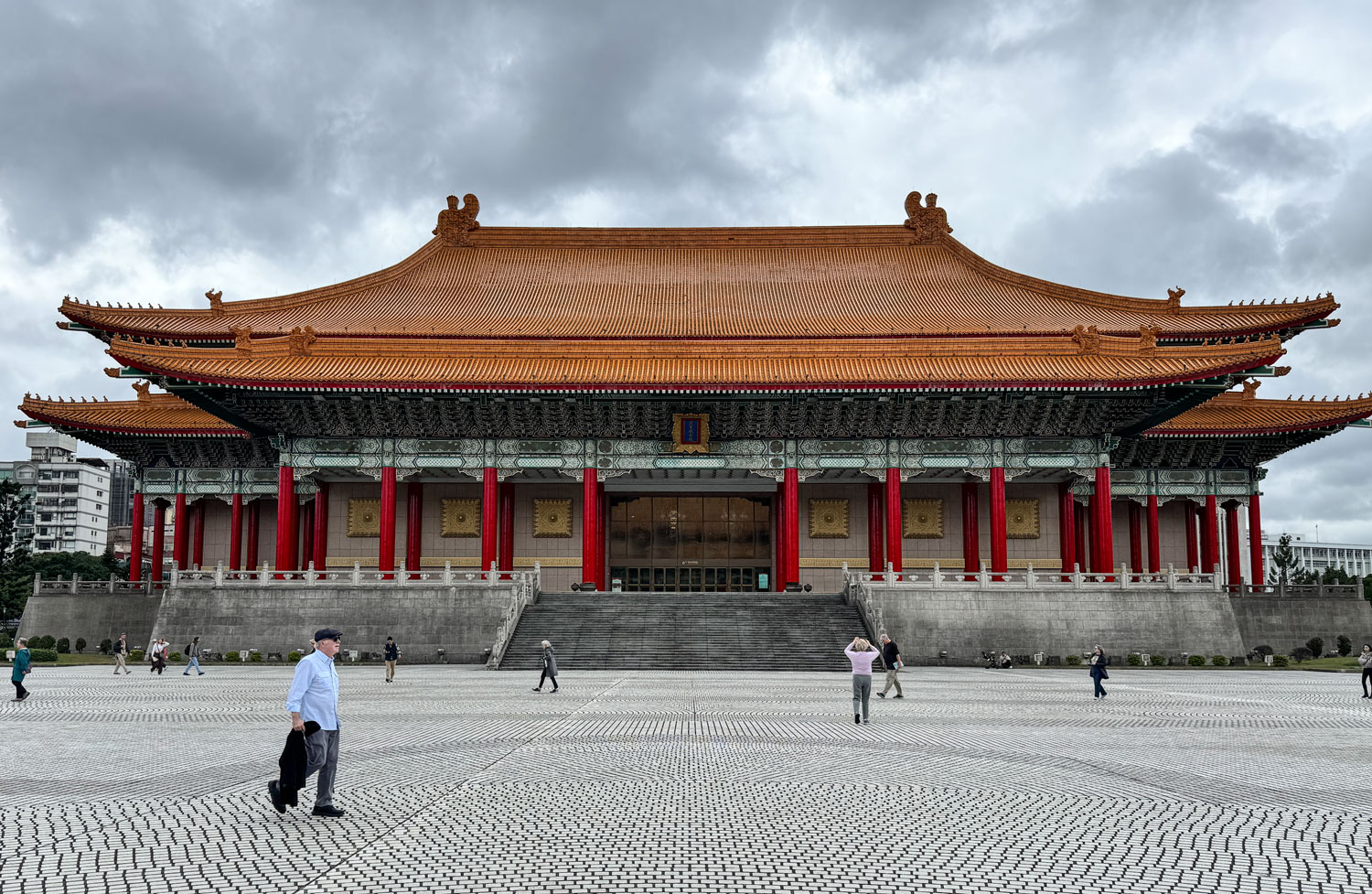
And the Concert Hall.

The Memorial Hall, as we approached it.

We arrived just in time for a military show. Six soldiers marched in, three from each side. Each group had one officer and two soldiers carrying rifles.
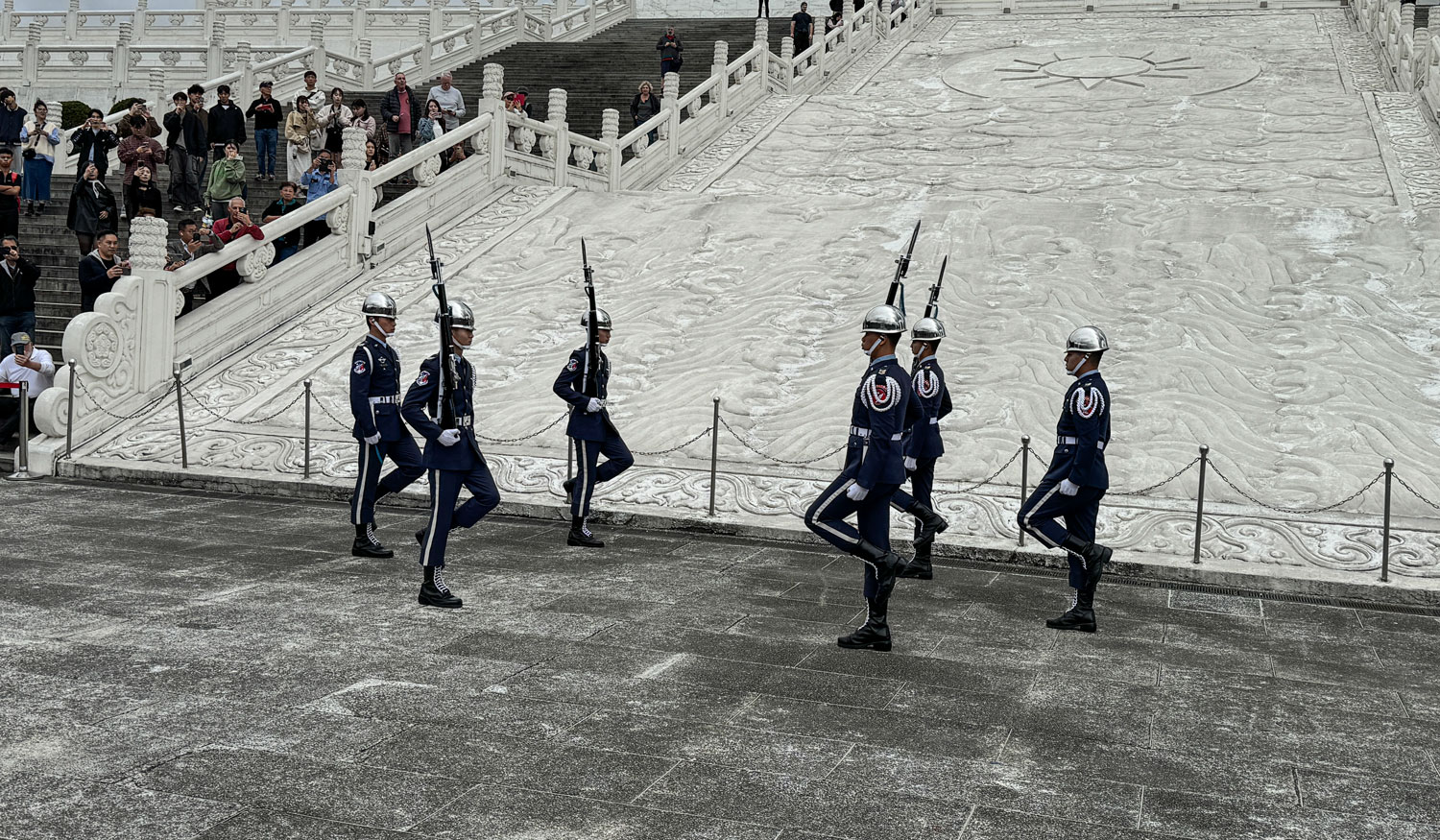
After a marching demonstration, three positioned themselves on each side of the platform.
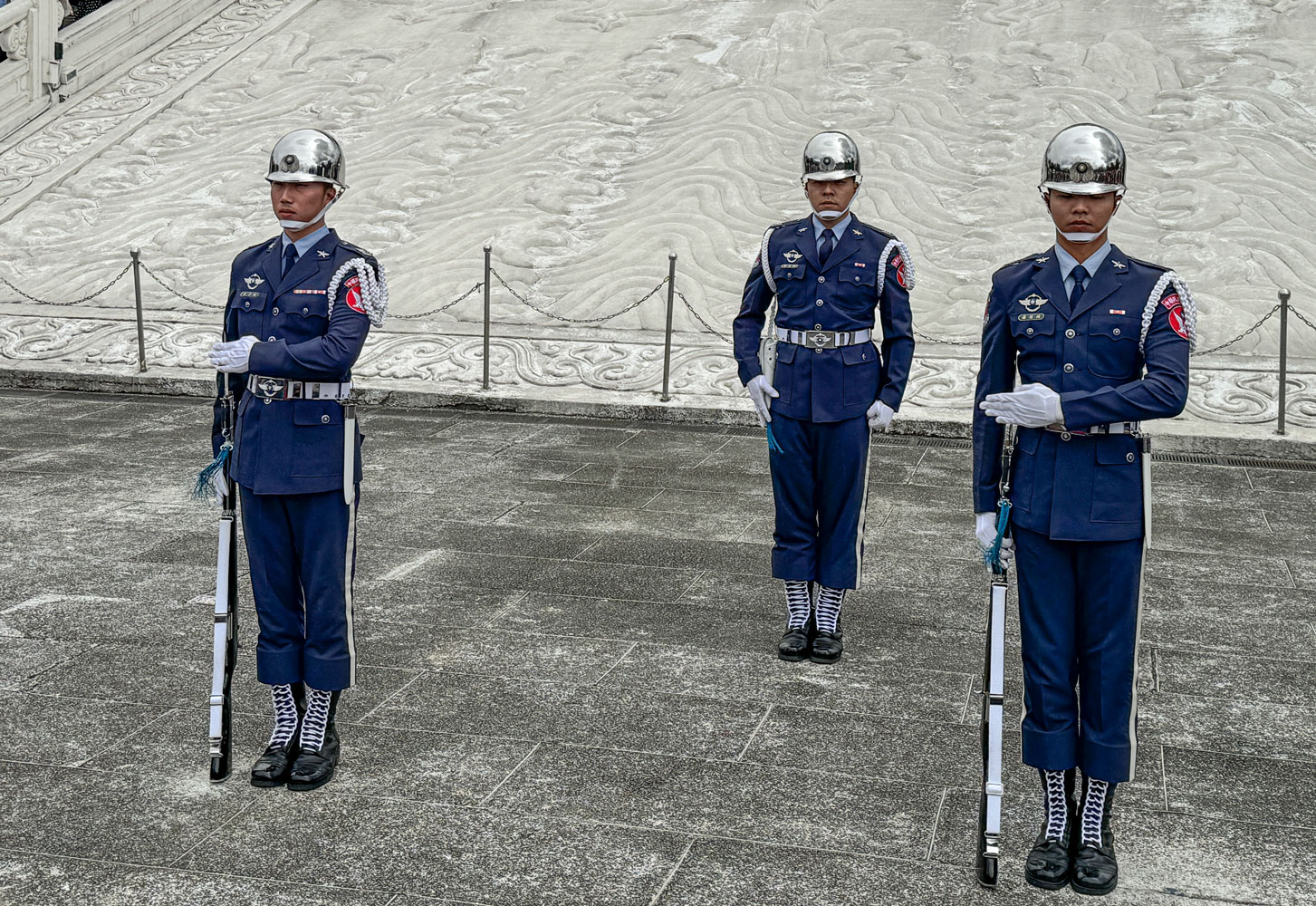
The did some fancy things with their rifles, such as spinning them around.
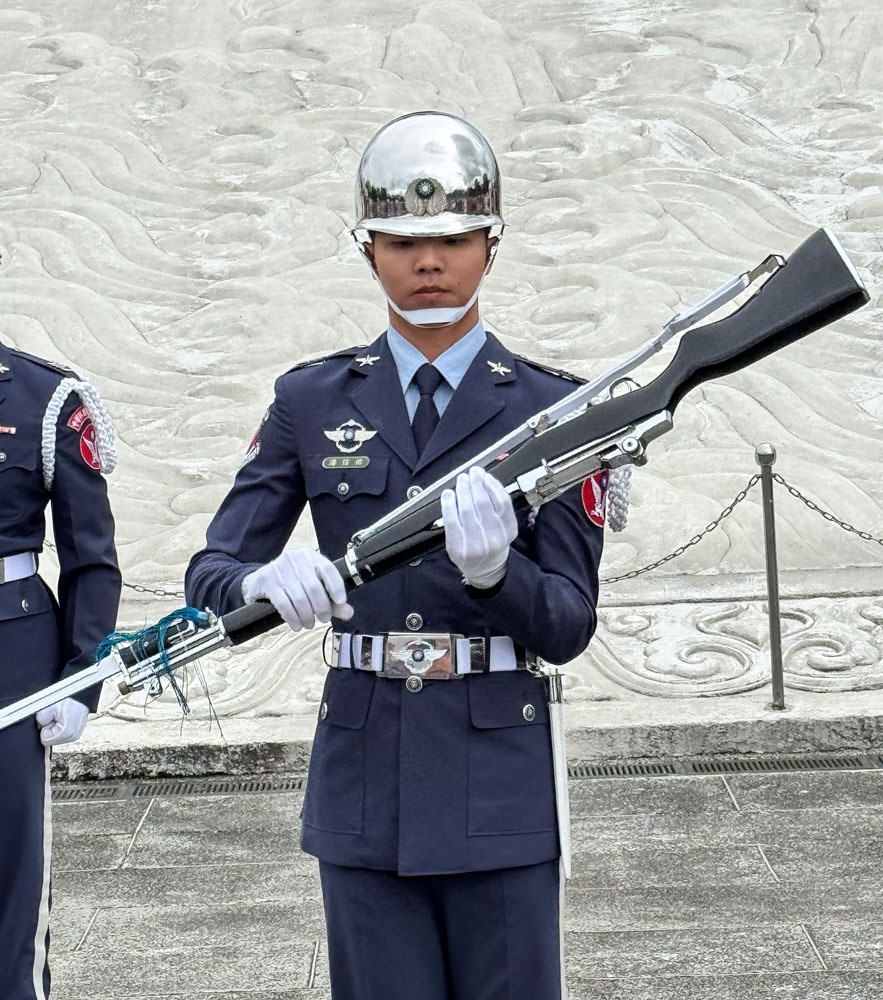
They presented quite a show, then marched off the way they came in.
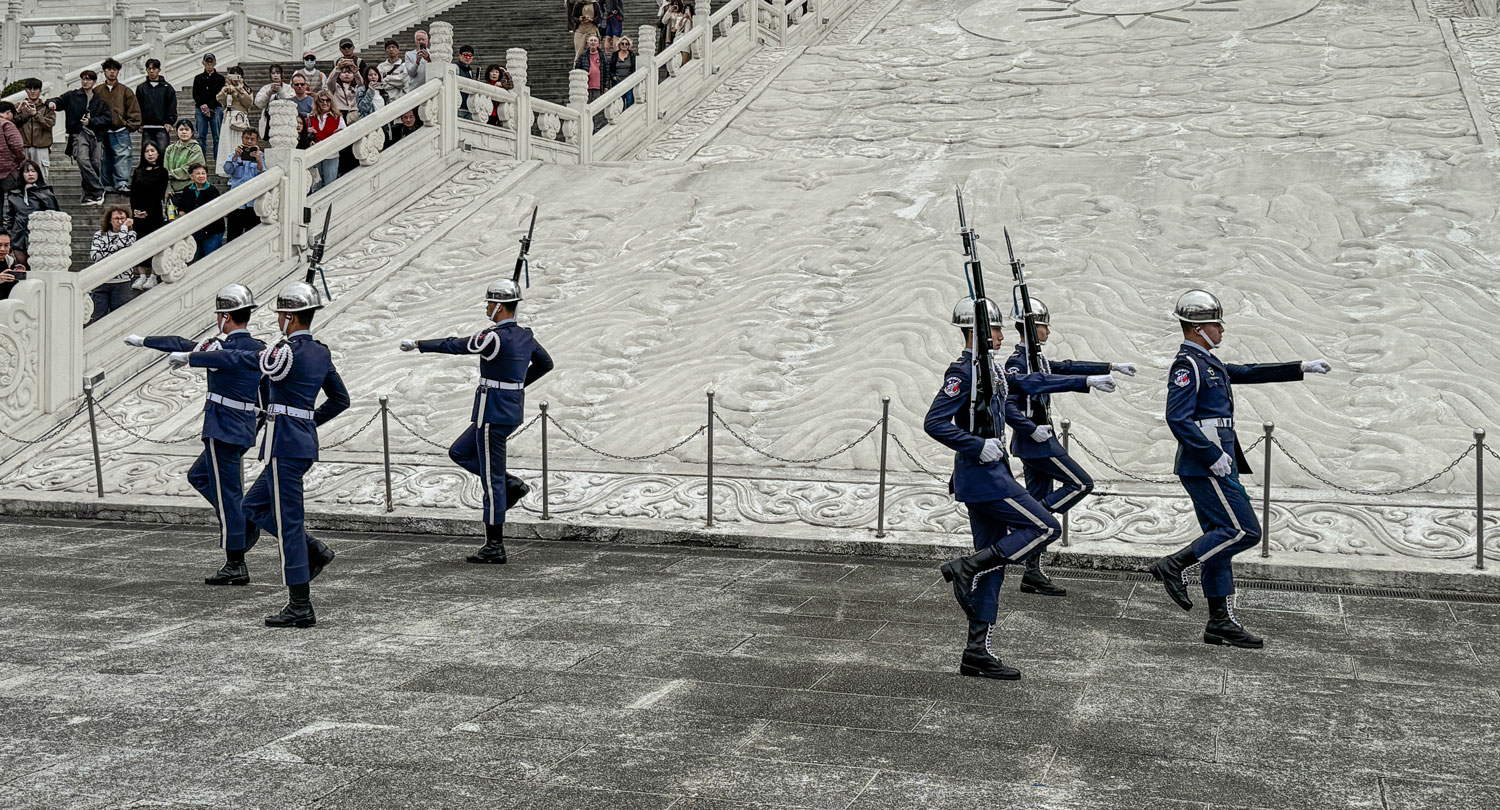
We only had about 10 more minutes at the hall, but I ran up the stairs and took this picture from the upper platform.

Then went into the hall.

The statue of Chiang Kai-Shek.

A view up to the ceiling.
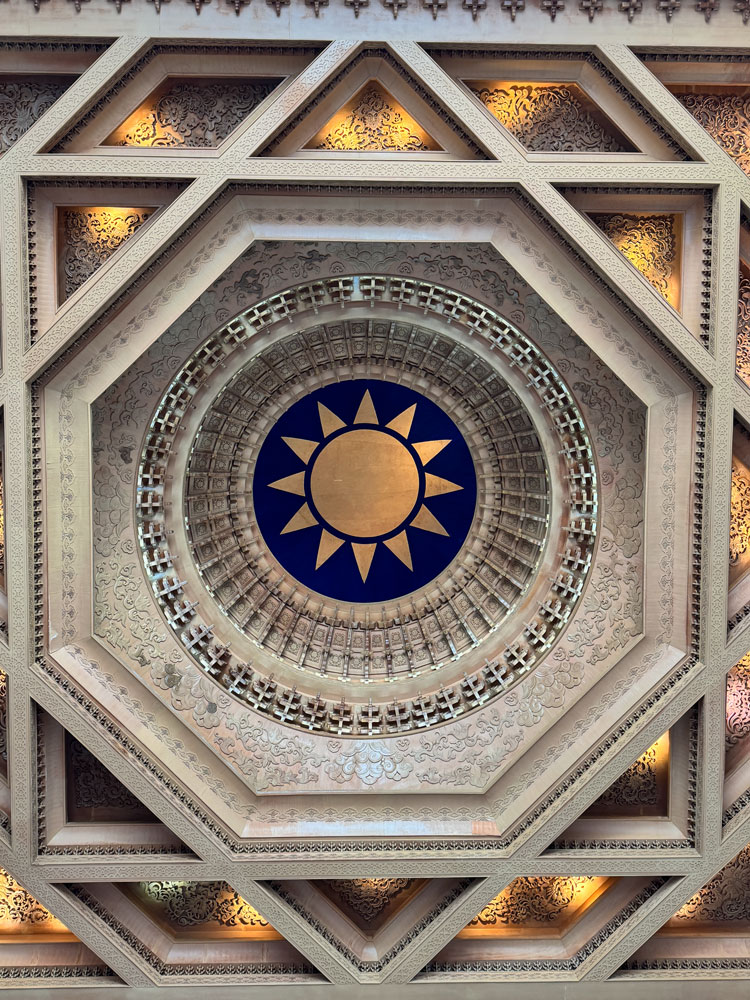
As we were walking out, I took this last picture of the hall.
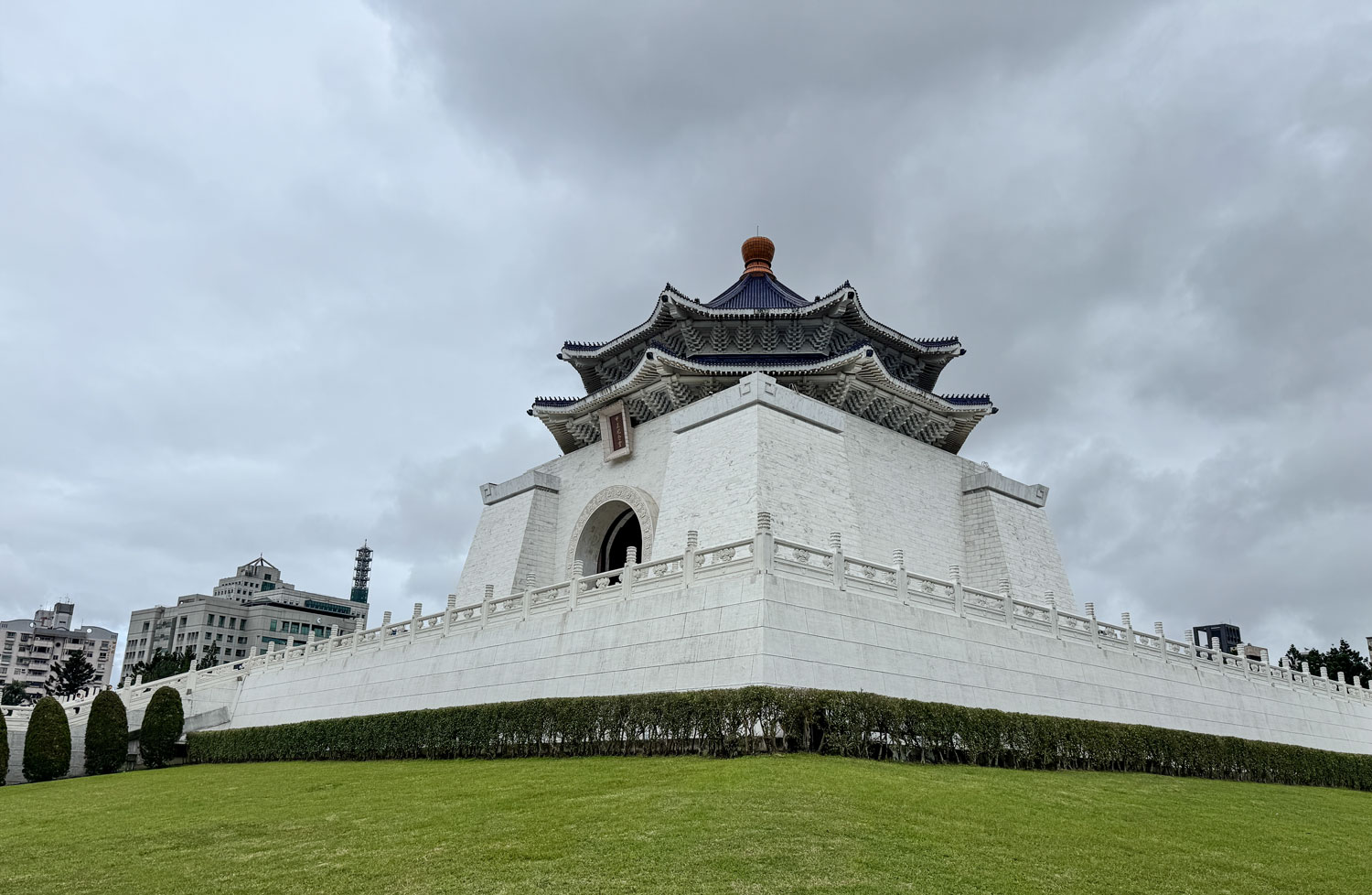
That ended our tour in Taipei. We got back to the ship about 2:30 and took it easy for the rest of the day - except that we participated in the Trivia game at 4:30. The ship departed Taipei about 5pm, heading for Ishigaki (Sakishima Islands) in Japan
After dinner it was to bed.
+++++++++++++++++++++++++++++++++++++++++++++++++++++
2/22/2025 (Saturday) We set our clocks ahead one hour last night so we were up early, body-time. But Judy and I don't depart the ship until 9:30 this morning so it didn't affect us too much.
Ishigaki is south-west of Okinawa about 260 miles. We're taking the Panoramic Ishigaki tour. We boarded the bus a bit after 9:30.
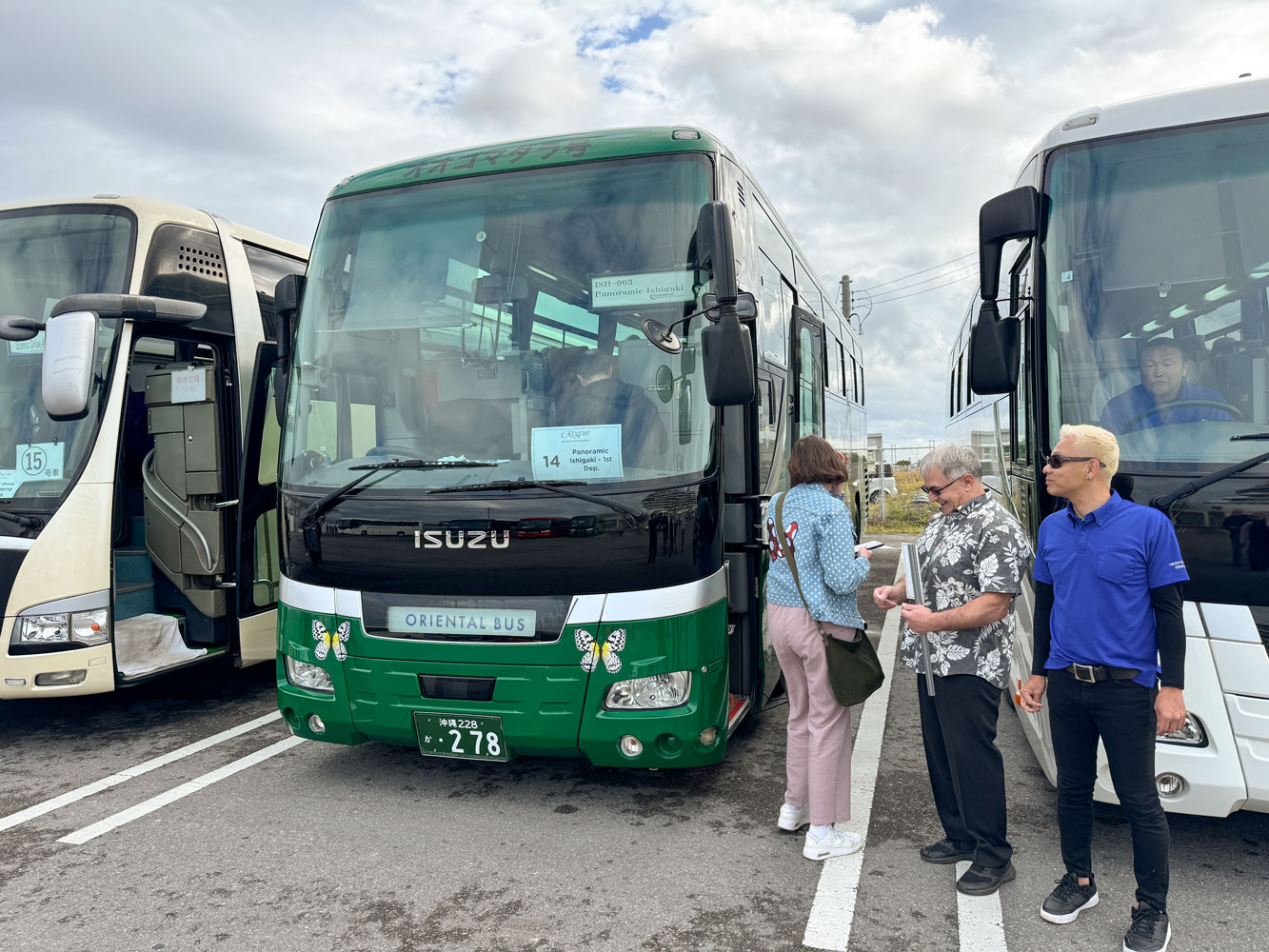
[Side note: Okinawa was the site of one of the largest battles in the Pacific war. Ishigaki was too small and insignificant to be invaded during the war. Our guide indicated that the city was bombed, however.]
Ishigaki is a small island, only about 85 square miles. After we left the city of Ishigaki (shown at the bottom of the map) they took us to a view site, as shown on the map, next.
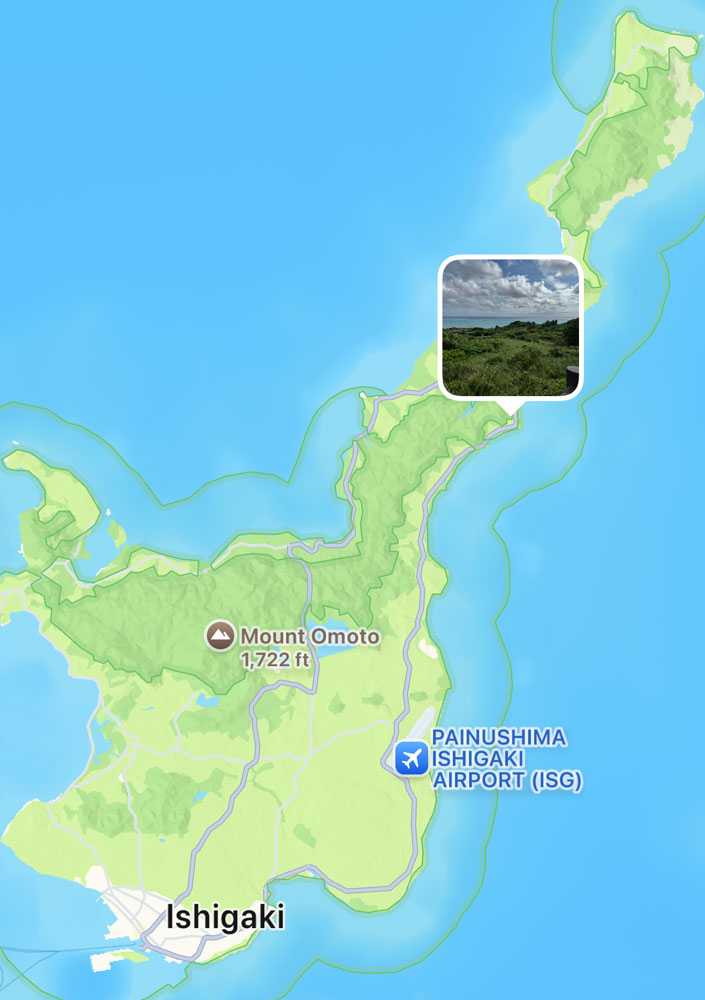
There really wasn't much there. Just a lookout point to see the beach area.
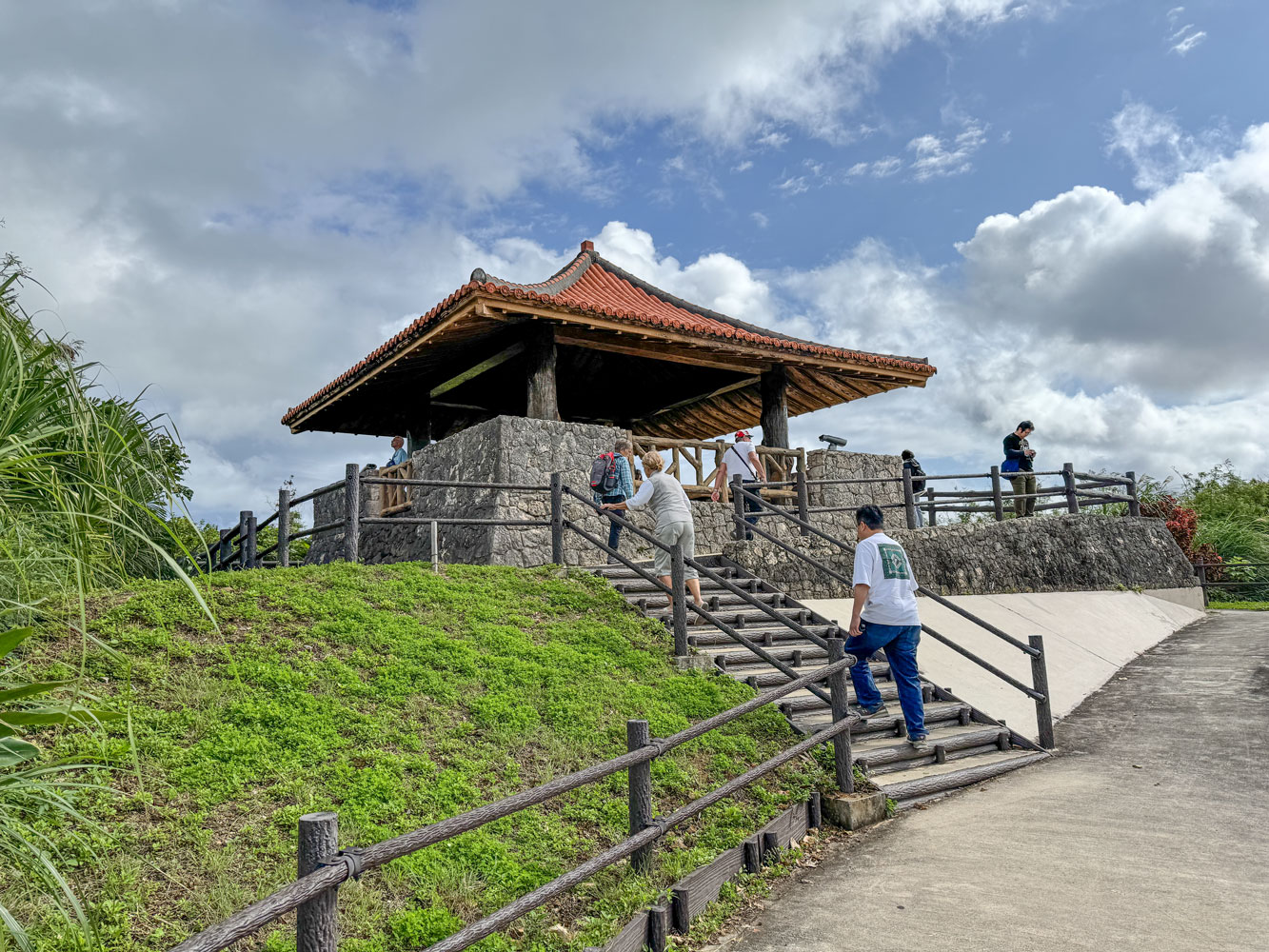
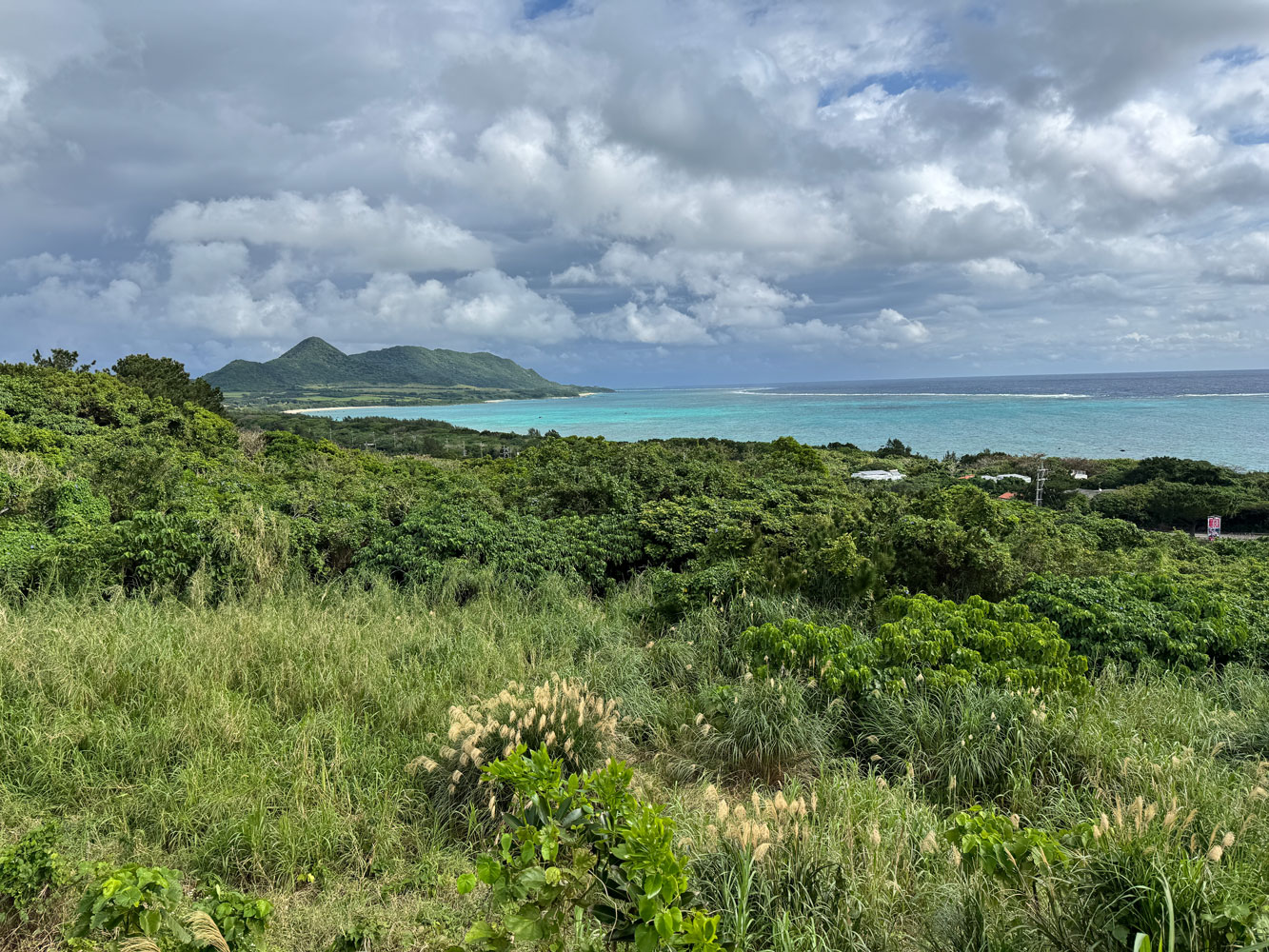
I took a picture of Judy with the beach in the background.

That was about all there was to see. The bus drove us to another part of the island to show us another beach, noted for its white sand.
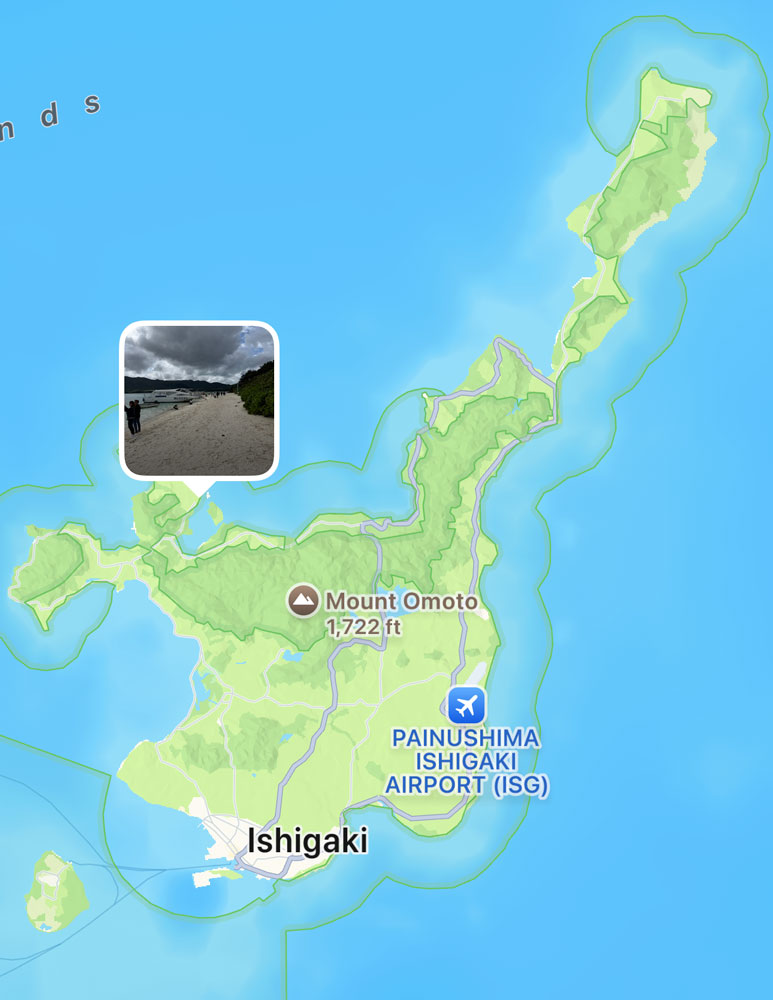
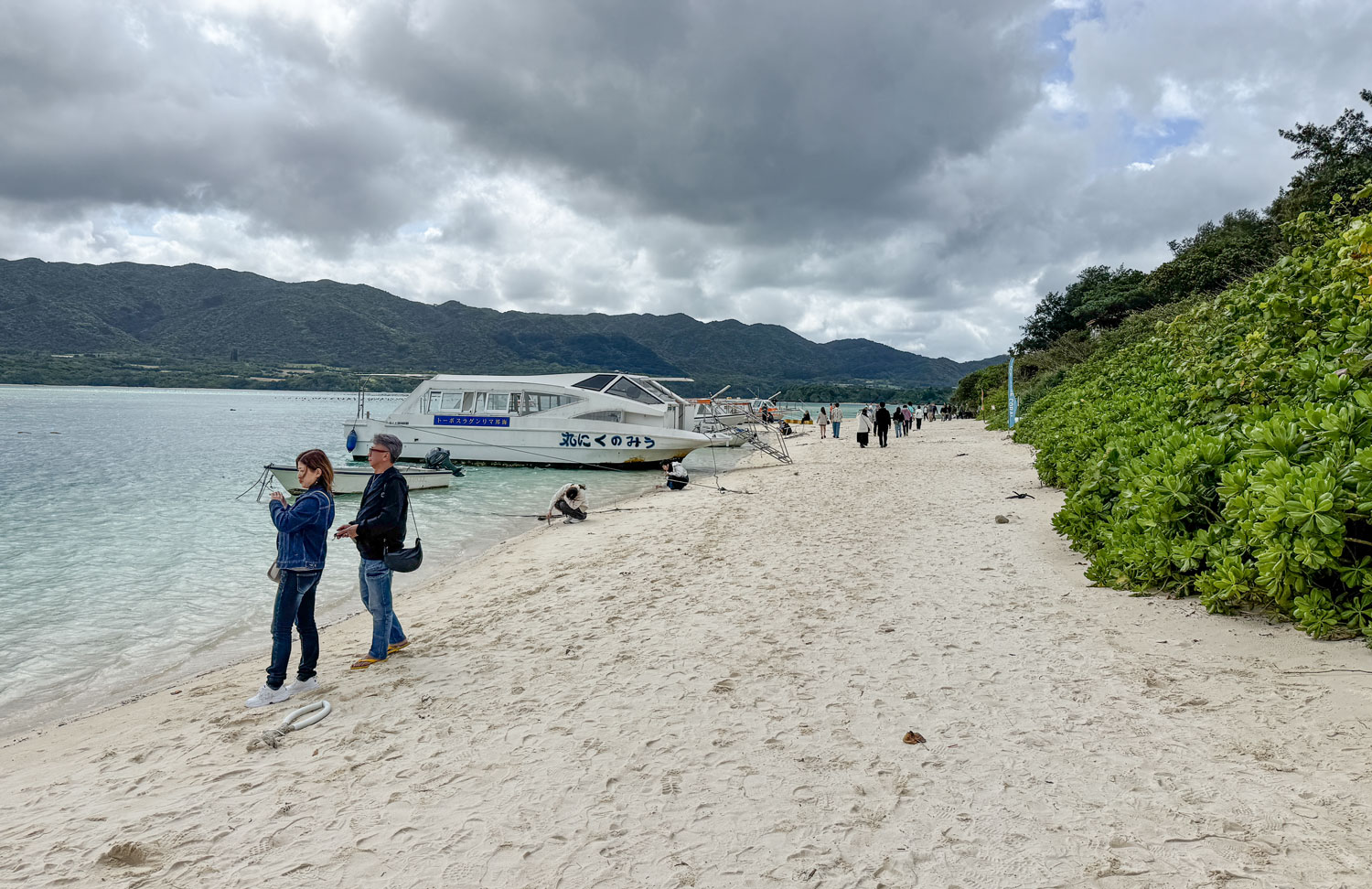
Judy and I didn't find it all that interesting so we didn't spend much time on the beach. Soon, the group left and we headed back to the ship, arriving at the dock a bit after noon.
Returning to the dock, I took this picture of the ship.
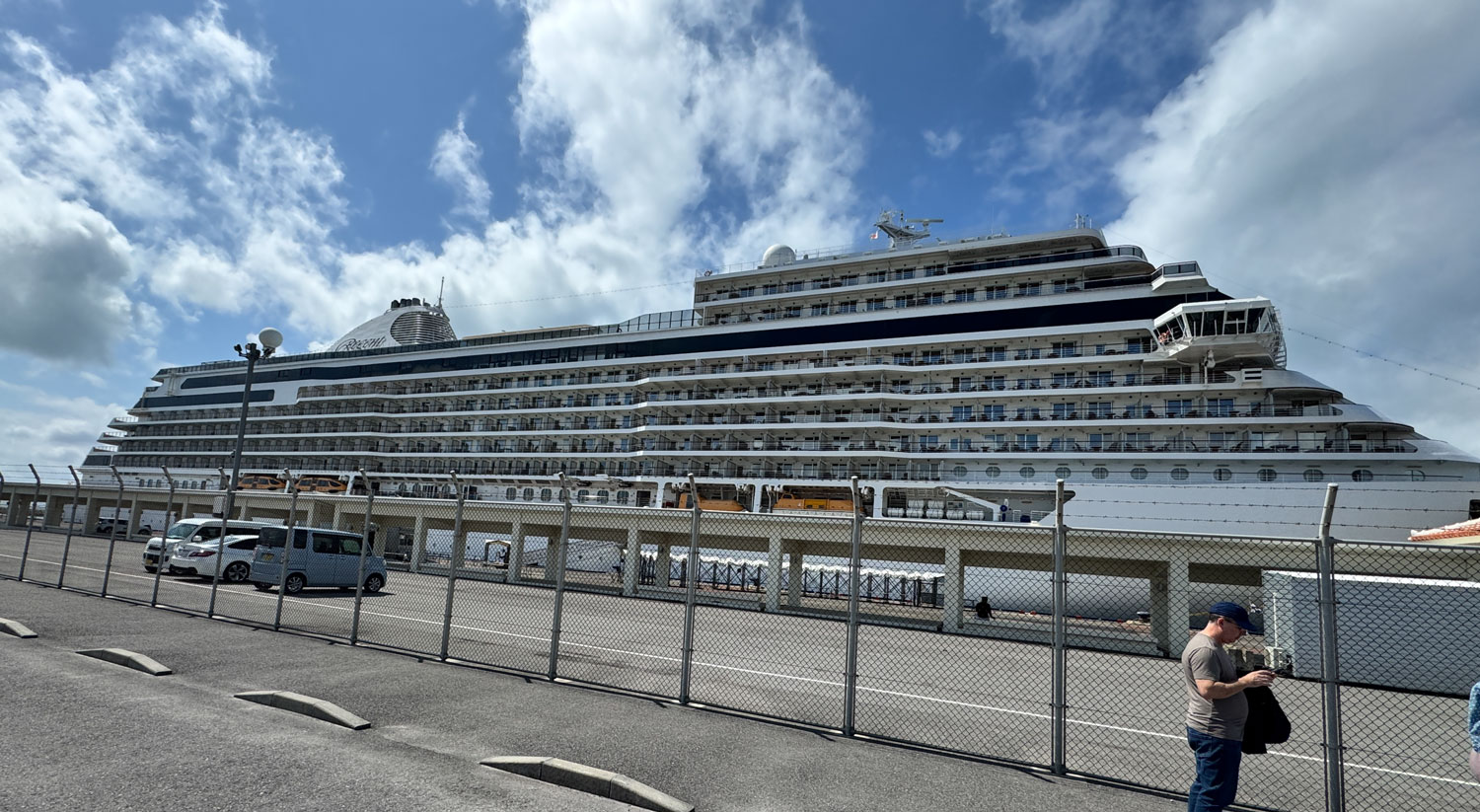
I don't know why they took us to Ishigaki. There's really nothing much to see here. I think divers and surfers would be more interested in the island than a ship load of old people.
For dinner, the greeter at the restaurant asked us if we'd like to join another couple, which we did. They were a very interesting couple and dinner was especially enjoyable.
Then it was to bed. We'll be sailing all night and all day tomorrow. The seas are a bit rough but it's just your normal rock and roll. We didn't need to go to the cabin down the hall to get a good night's sleep.
Tomorrow is a sea-day. We set our clocks back one hour this evening.
+++++++++++++++++++++++++++++++++++++++++++++++++++++
2/23/2025 (Sunday) The seas are a bit rough but we don't have that banging like we did earlier. We felt better.
Judy had a massage in the spa and I worked to catch up with this blog. Otherwise, a quiet day.
We played Trivia and won three points each. I made a math mistake on the Mensa quiz so we lost two possible points there.
That evening, Regent had their "Block Party". We all go out into the hallway and meet the people in cabins near us. One of the cabin attendants provides drinks.
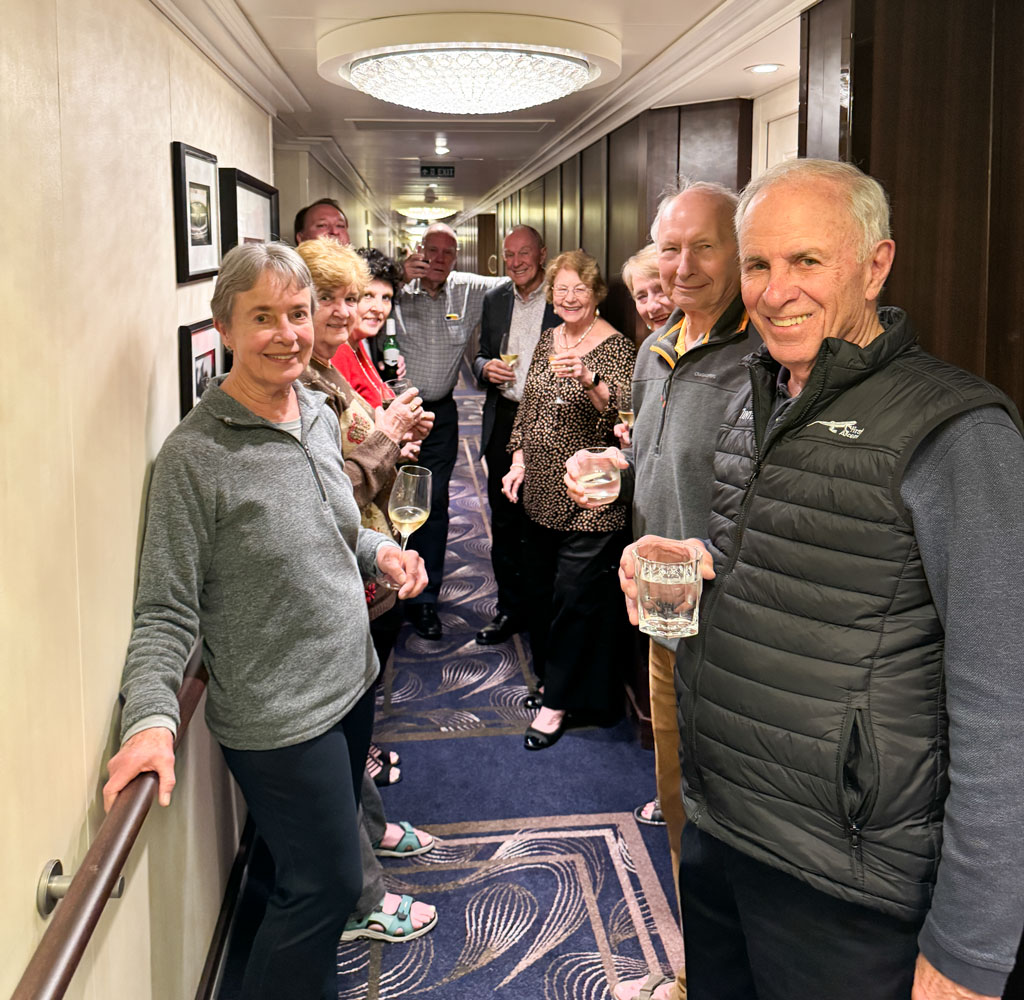
Then it was dinner and to bed.
+++++++++++++++++++++++++++++++++++++++++++++++++++++
2/24/2025 (Monday) We arrive in Shanghai today.
Shanghai is the largest city in China, with a population of almost 25 million people. Beijing is second, with 21.5 million. It is the world's busiest container port.
Shanghai was originally settled about 6,000 years ago, and developed into a major trading port.
China traded with the west, but the west wanted the high value goods from China, such as silk, dishes, pottery, etc. China did not want or need much of high value from the west. And when I say "west" it was the British East India Company who did most of the trading with China.
The East India Company needed something of value to ship to China and they hit upon the idea of Opium. Opium poppies were grown in India, processed at two Indian government factories, and then shipped to China. Like all good drug dealers, the East India Company sold the opium cheap in the beginning but as more and more Chinese became addicted to opium, the price went up.
But drug addiction was causing serious societal problems in China. Addicts would do anything to get their opium, leading to crime and destruction of families as the addict spent all of their money on opium.
In 1839, Lin Zexu, governor-general of Guangdong, launched an anti-opium campaign, burning over 1,150,000 kg of opium publically on the beach of Humen, Guangdong.
Britain demanded compensation for the destruction of the opium and China refused. This led to the First Opium War (1839-1842). China was defeated in that war and the Treaty of Nanking led to Britain being given rights to a district in Shanghai. It also ceded Hong Kong in perpetuity to Britain as a colony.
Later, France and the United States negotiated treaties with China granting them each a district in Shanghai. The inhabitants of those districts, including Britain's, were given extraterritorial privileges, so they were not subject to the laws of China.
Here's a good article about the growth of the use of opium in China. The following chart is taken from that article. You can see how the imports skyrocketed after the First Opium War. Another good article here. Note: tonnes are metric tonnes - 1,000 kg (2,200 pounds).
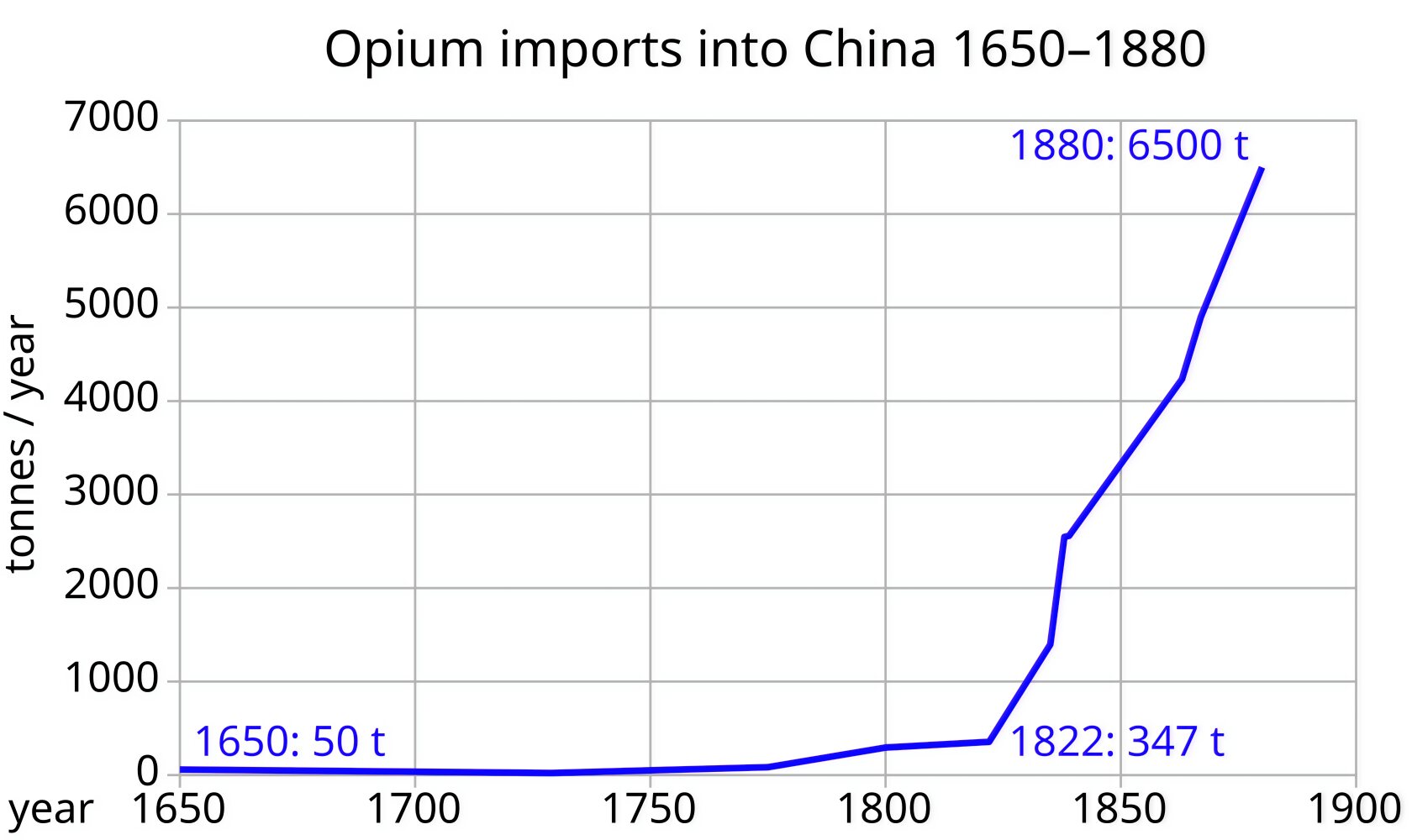
After the Communist's victory in the China Civil War, drug trafficking was brutally suppressed, especially after 1952. Drug dealers were executed and drug addicts were sent to "labor reform" camps.
Now, back to Shanghai history. After the Communist's takeover of China, the port was closed to western countries - trading from the port was mainly to other socialist countries.
In the late 1980's and early 1990's, China instituted economic reforms and opened to western countries. Also, see link and link. This caused significant growth in Shanghai, which continues to today.
We won't dock until about 1:30 pm so Judy and I participated in a game this morning. You had to bounce a ball off a mini-trampoline, and get the ball into a hole in the target area. The holes were worth from 1 to 4 points, depending on the difficulty of hitting the hole. When I was called to play the game, I did well, but didn't stay to see the outcome.
When Judy came back to the room, she had a 3-point card. I had won the game! Surprised the heck out of me.
The ship entered the Yangtze River but quickly turned left into the Huangpu River. There was a fair amount of river traffic on the Huangpu, mostly small cargo barges.
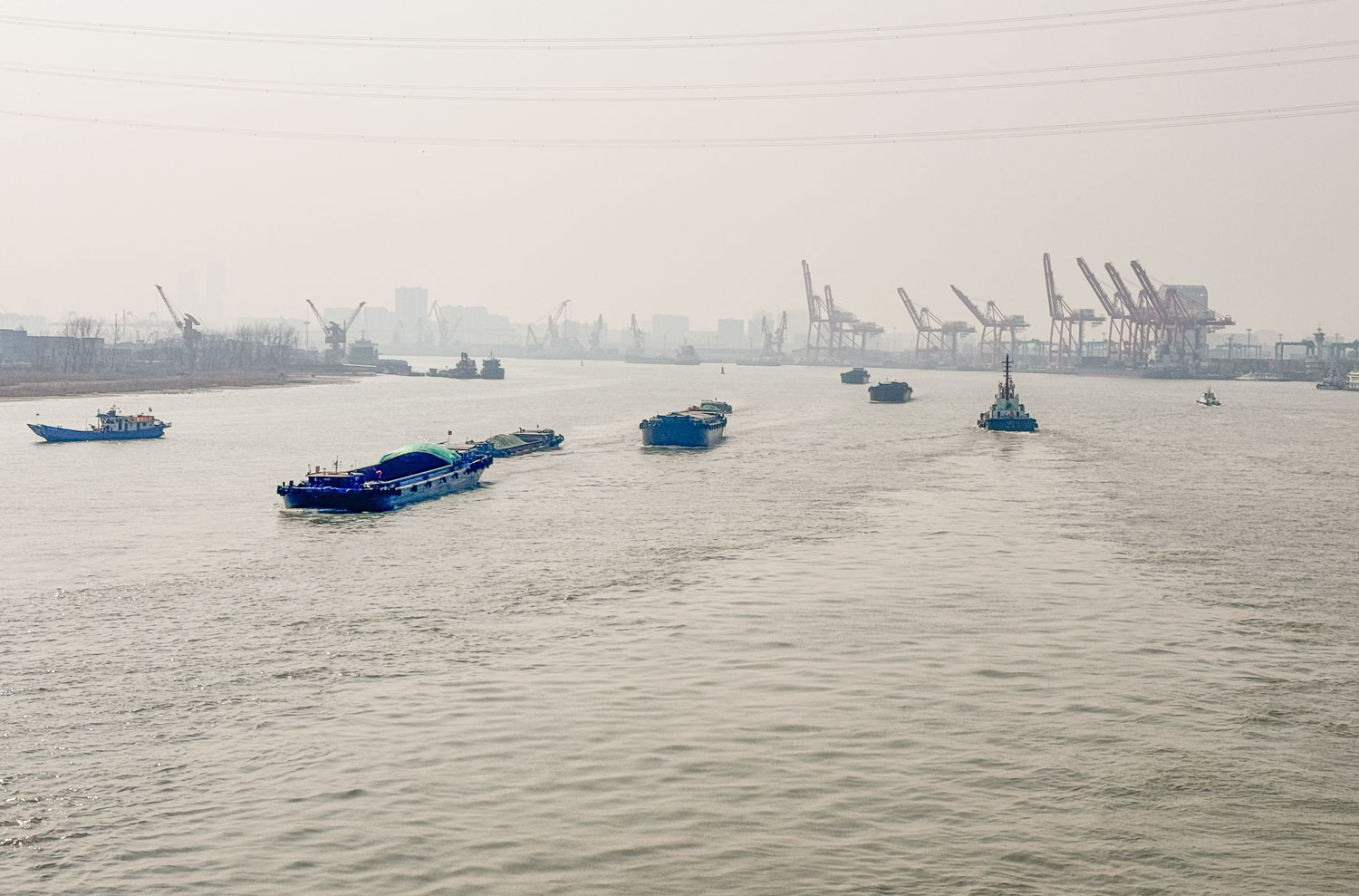
It was fairly cold in Shanghai - in the 40's. We docked across the river from the Oriental Pearl Tower, as shown by the black arrow on the map. The tower was built between 1991 and 1994, and was one of the first major structures built in newer Shanghai.
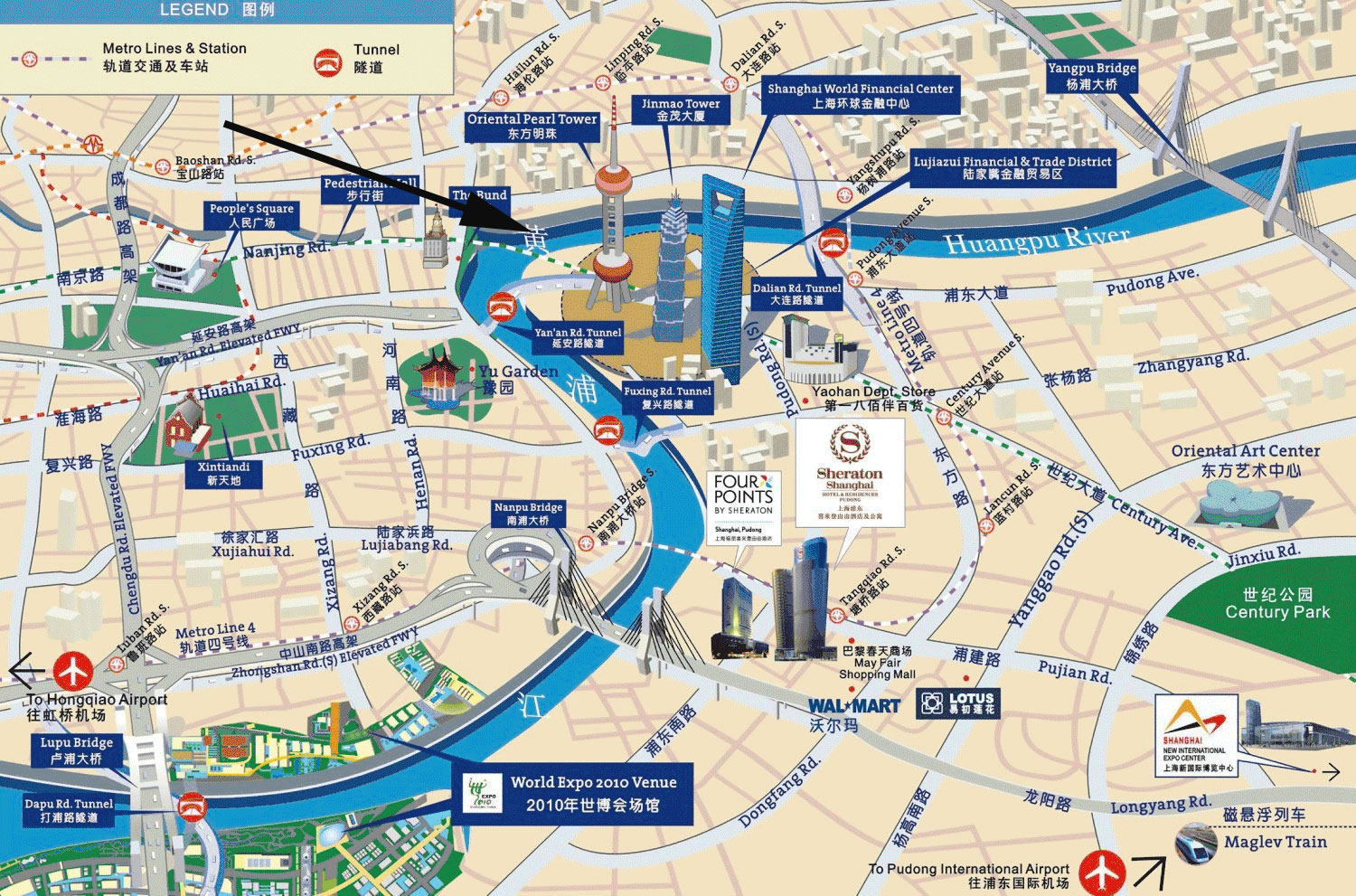
At the bottom of the map is the Nanpu bridge with it's helix access road on the left bank. When I was in Shanghai in 1999, I saw this spiral road and was impressed by the concept. They didn't need the long ramp road to get up to the height of the bridge. To do that probably would have required clearing a lot of existing buildings.
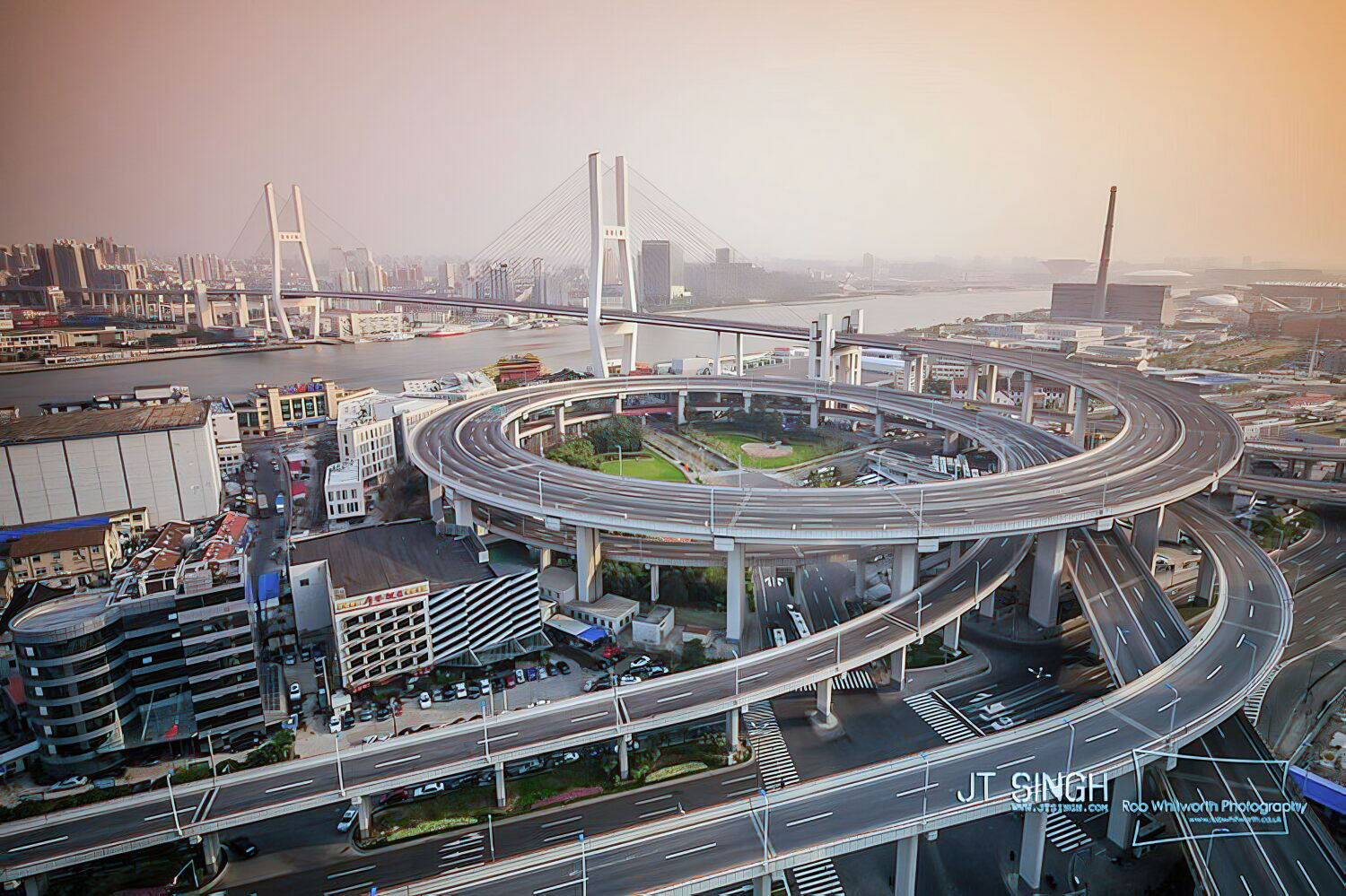
A nice thing about this dockage is that they have an elevated, covered ramp for access between the ship and the terminal, similar to a jetway at an airport. Should we call it a "shipway"? :-)
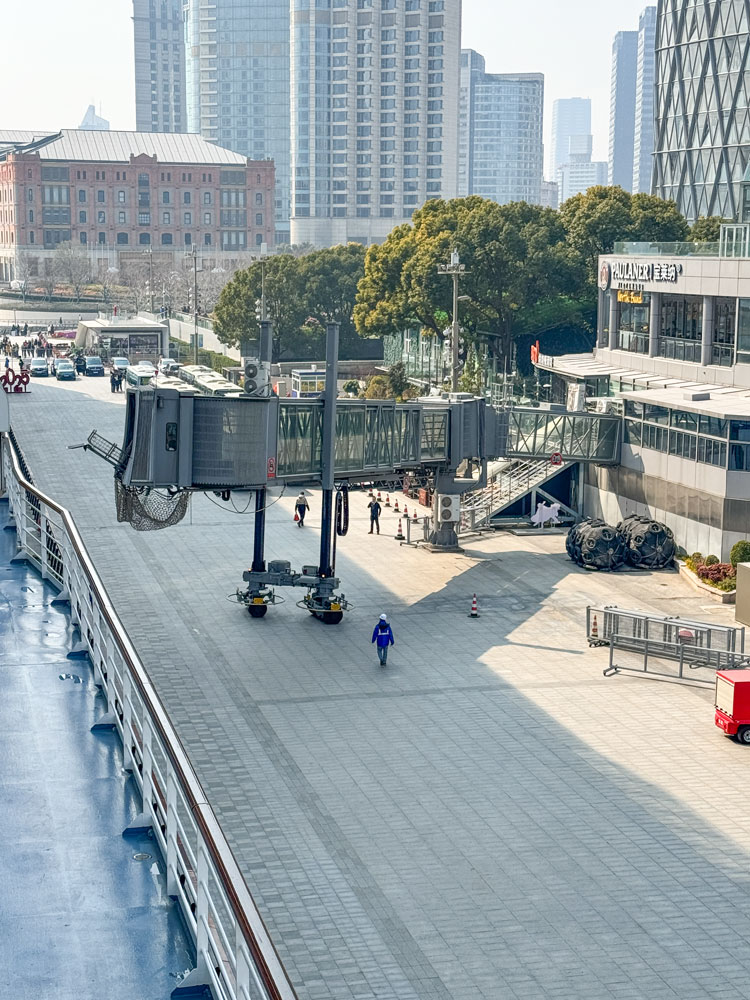
After the ship docked and was cleared by passport and immigration, we boarded the bus about 2:30 pm for our tour.
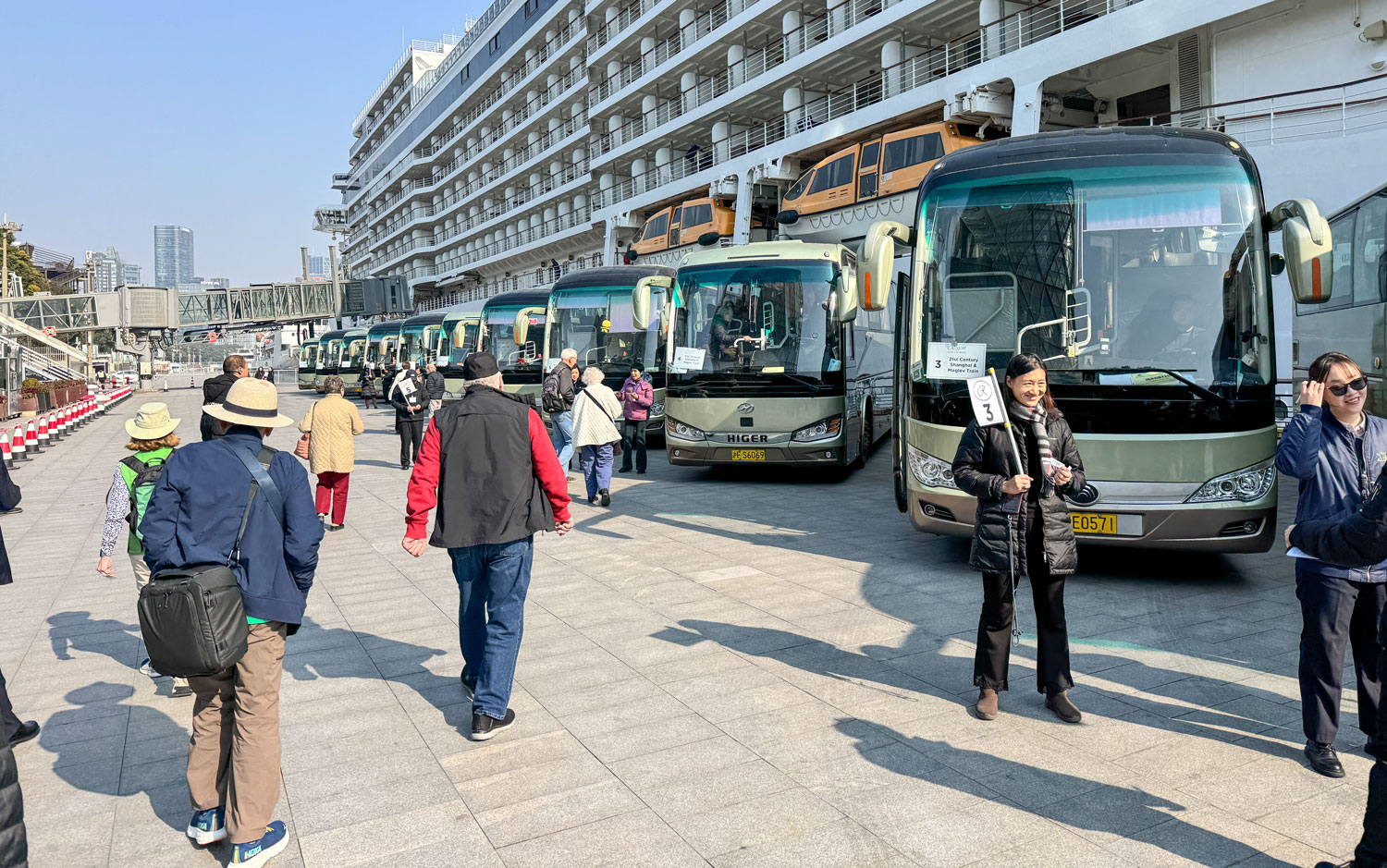
Our tour guide took us to the Jin Mao Tower. It's one of the highest buildings in Shanghai - maybe third highest. The observation deck is on the 88th floor and we're going to ascend to that floor today.
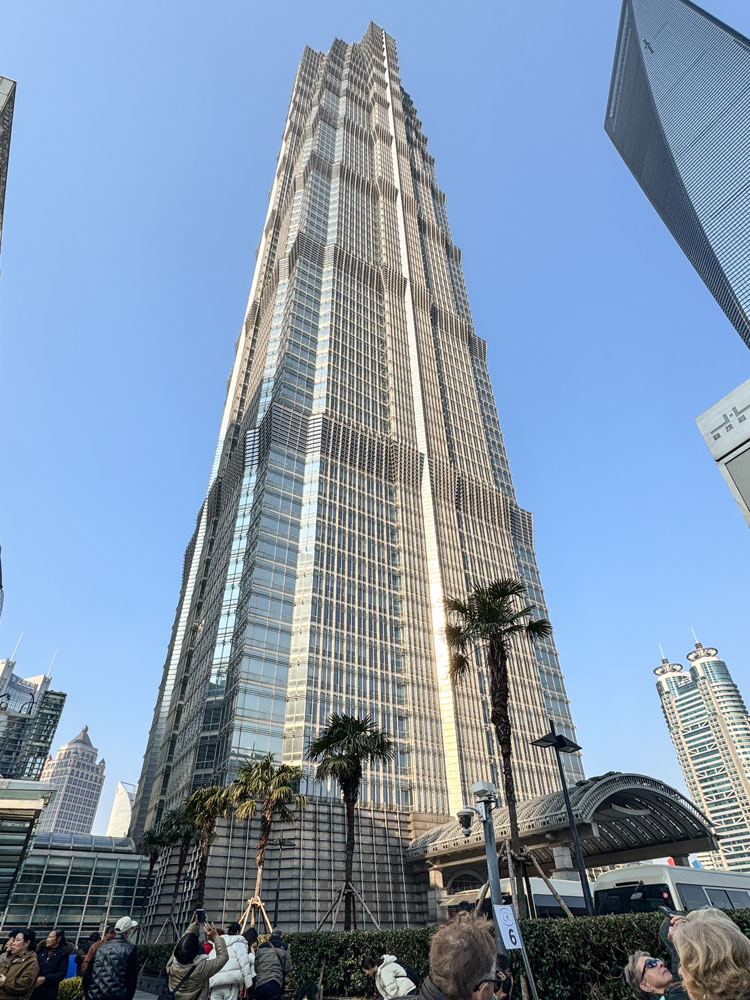
Here's a group entering one of the Mitsubishi elevators. It goes 9.1 meters/second and takes about 45 seconds to get to the top. The 88th floor is 340 meters high.
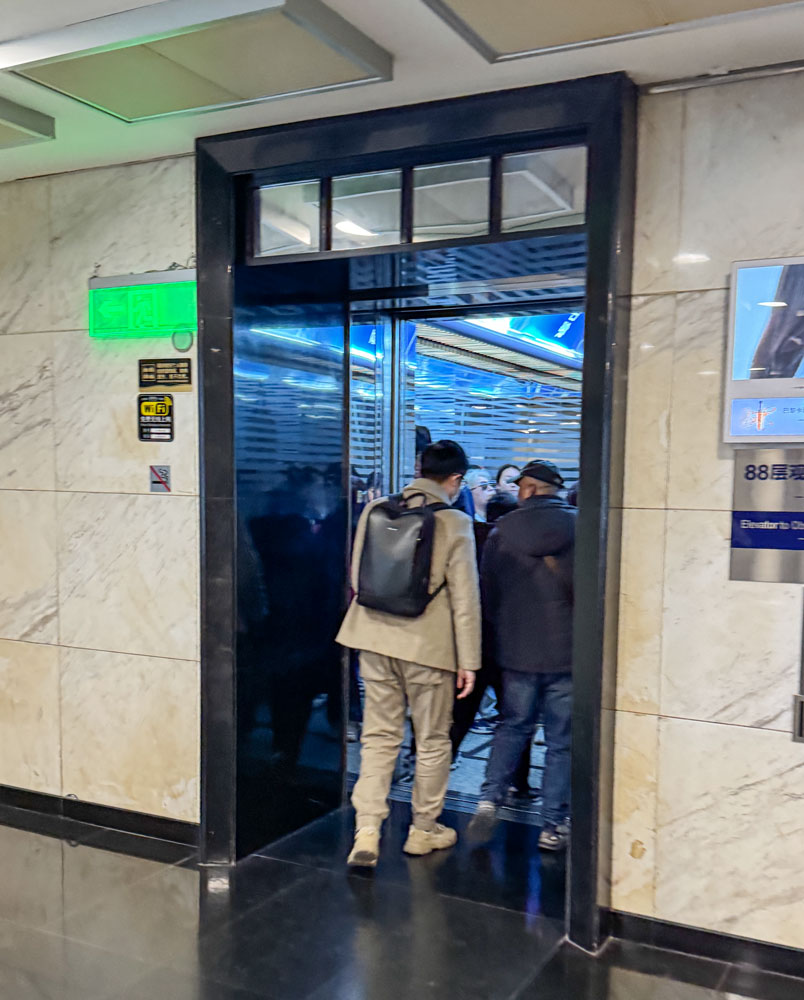
From the top, we had a view of the roofs of Shanghai. Here's the Oriental Pearl Tower.
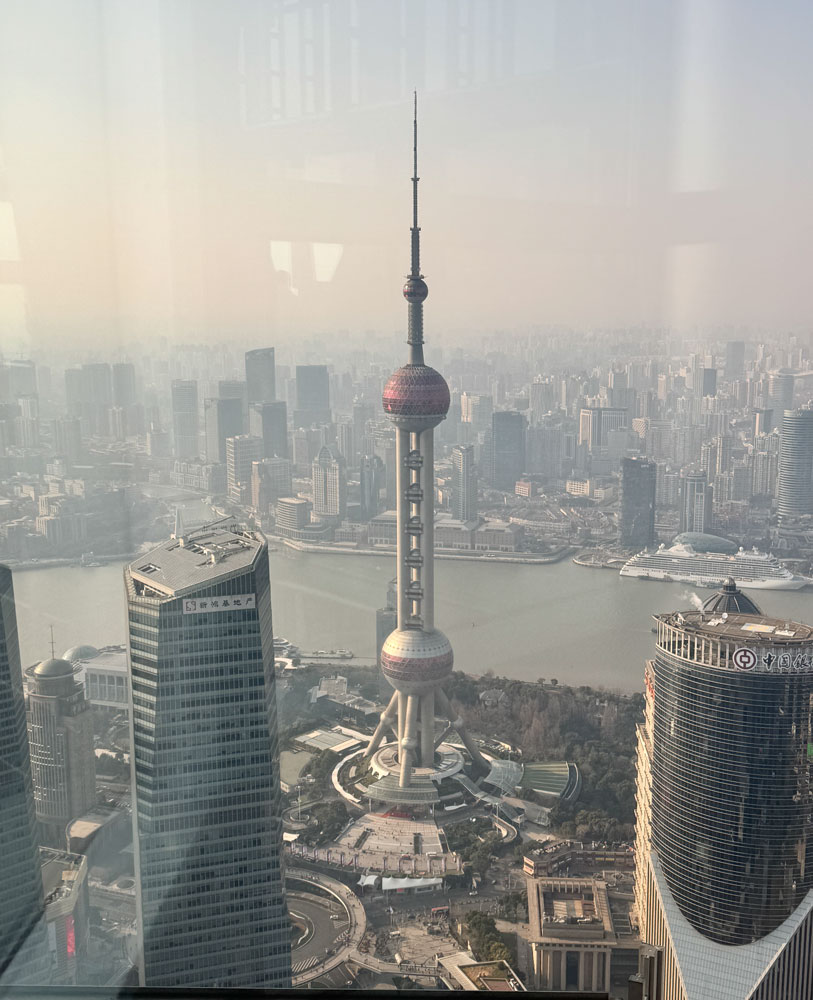
A view in a different direction.

A view in another direction. I don't know whether there was just a lot of moisture in the air, or if that's pollution.
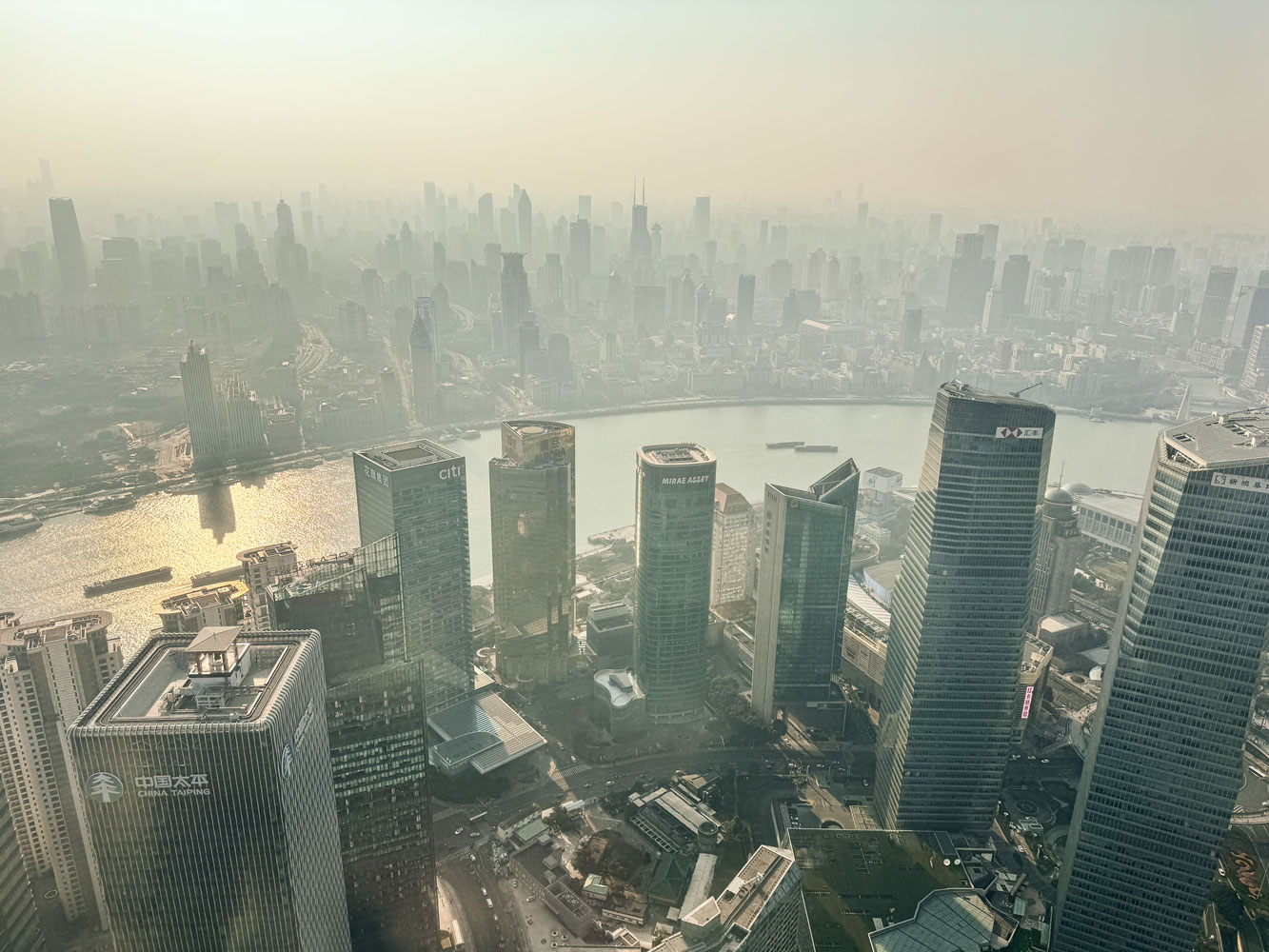
The Regent Explorer was docked across the river.
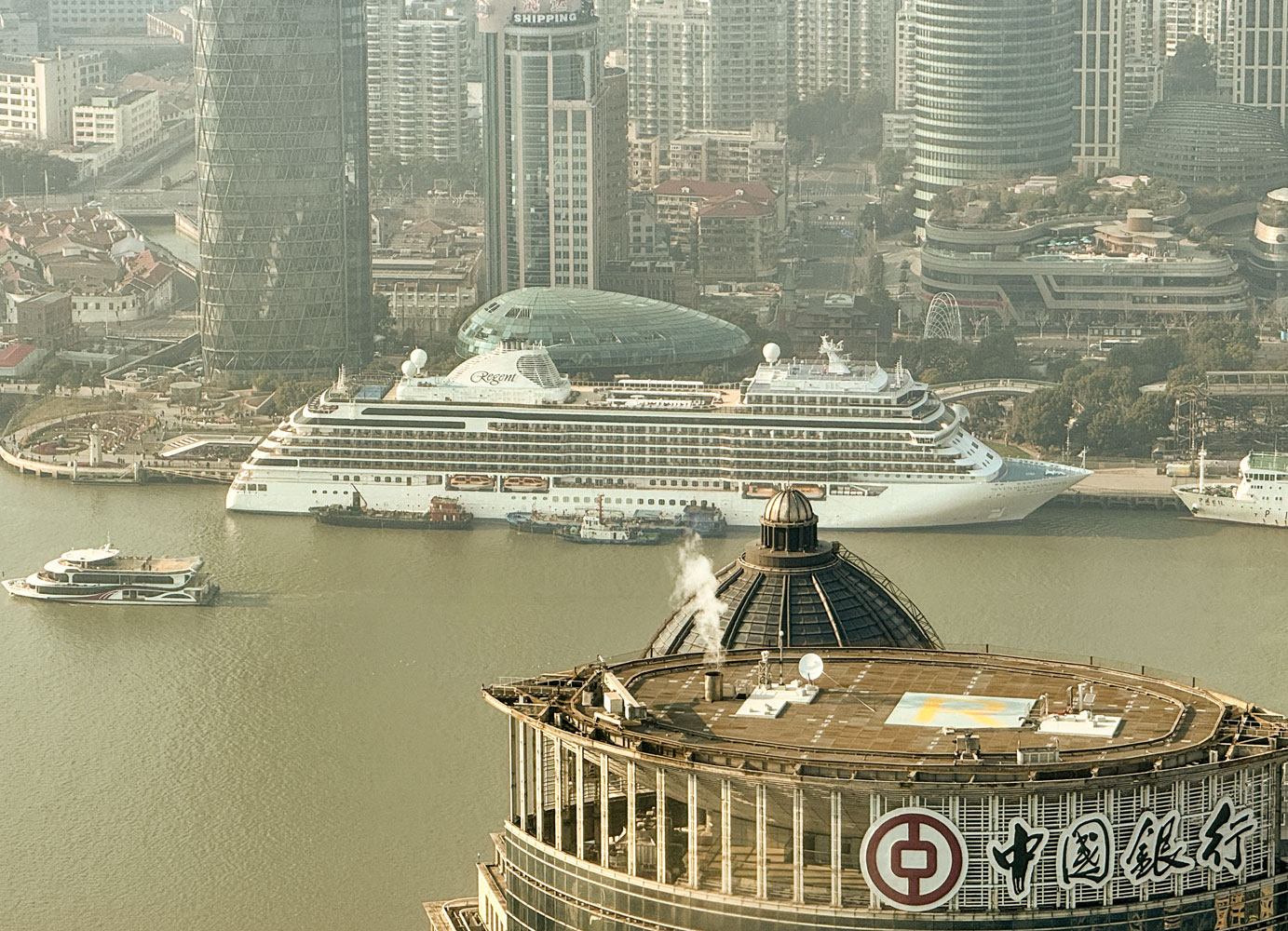
Hyatt has a hotel from floors 53 to 87 - the Grand Hyatt Shanghai. The building is "hollow" between those floors so that the hotel rooms can look inward to the atrium. From the observation deck on the 88th floor, you can look down through that hollow area to the lobby of the hotel.
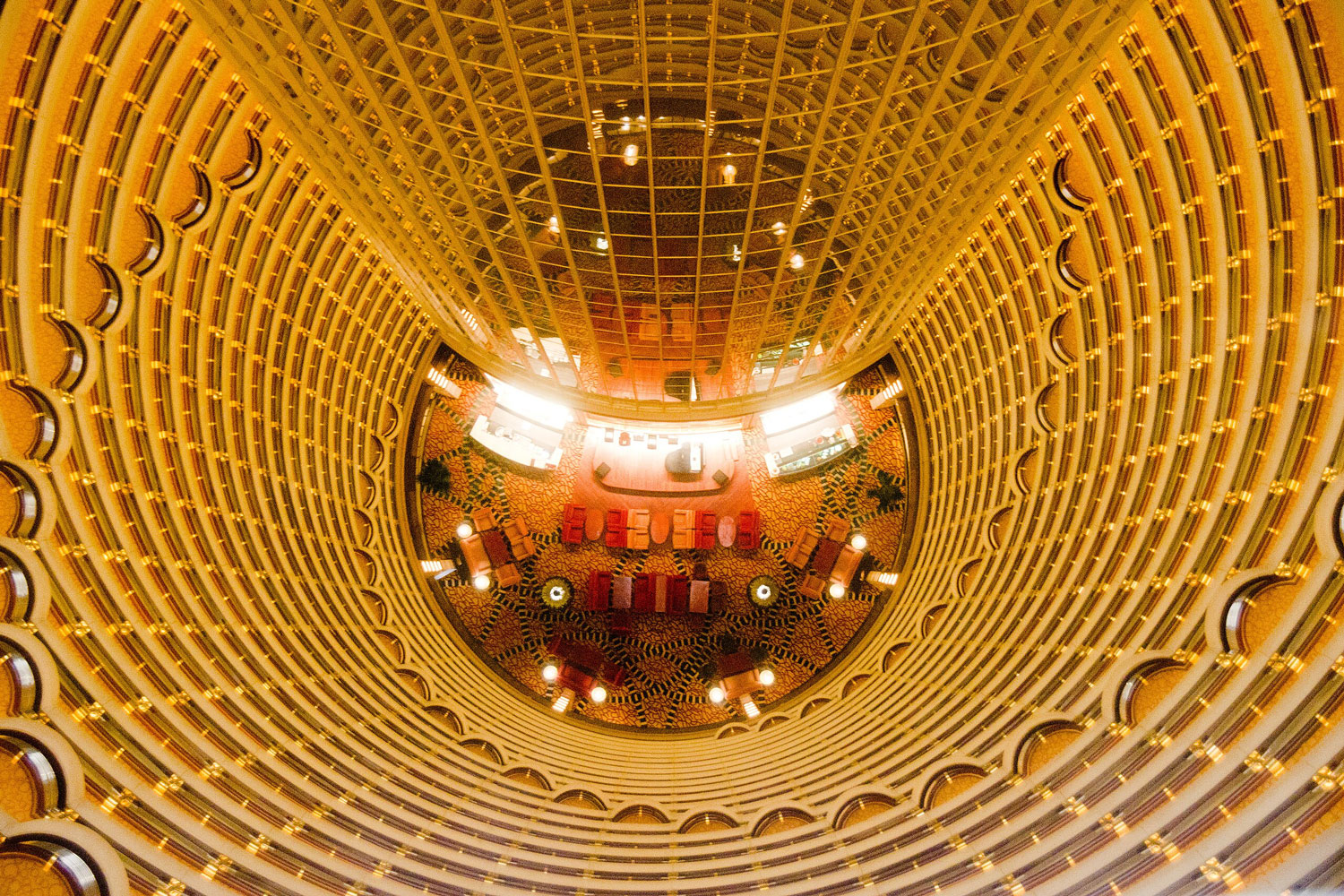
After we saw what we were interested in, we took the elevator back to the main floor.
Next, we stopped at the Shanghai Museum but we didn't go in. It's Monday and I think the museum is closed on Monday.
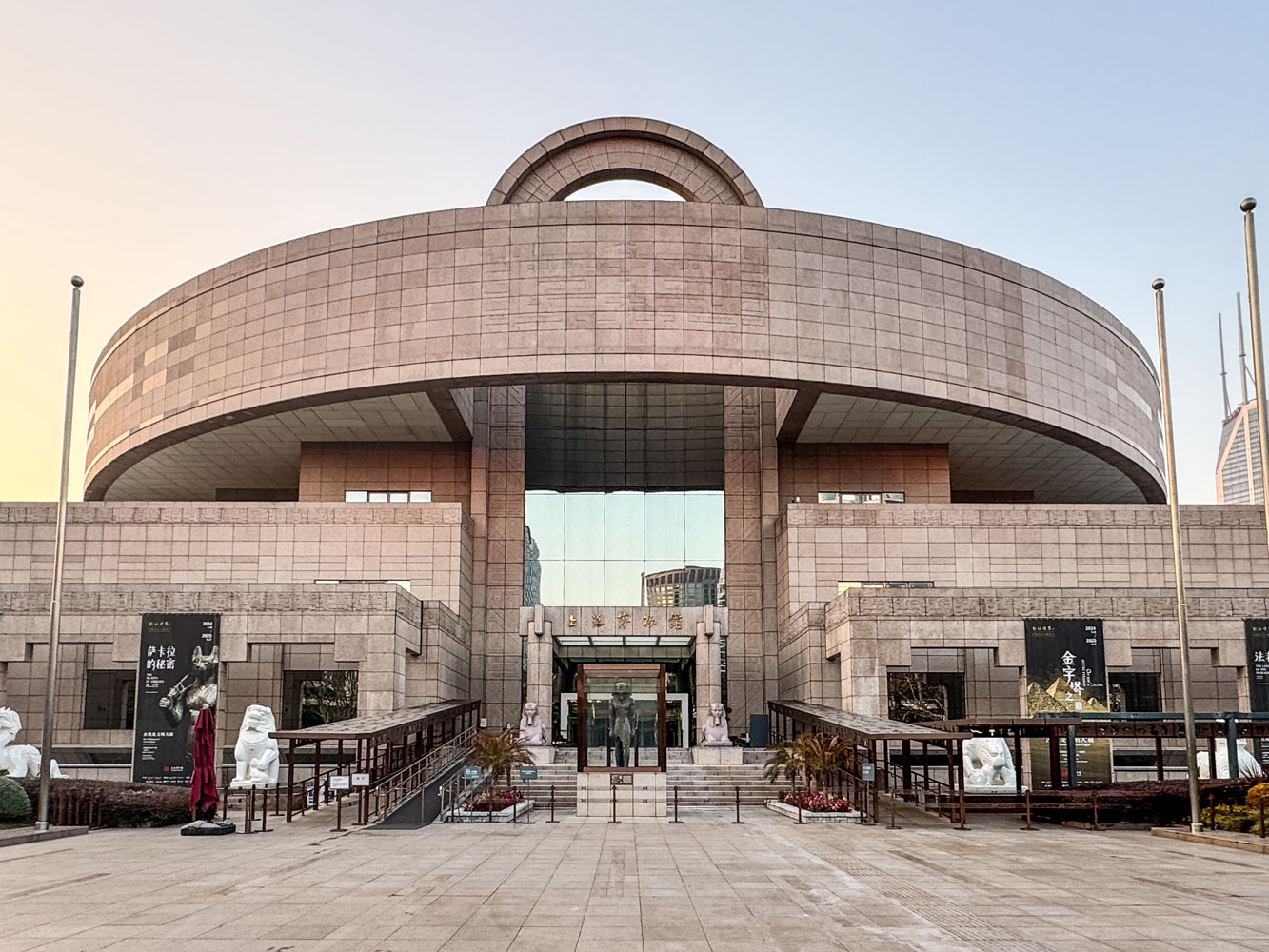
Here's a closer view of the entrance.
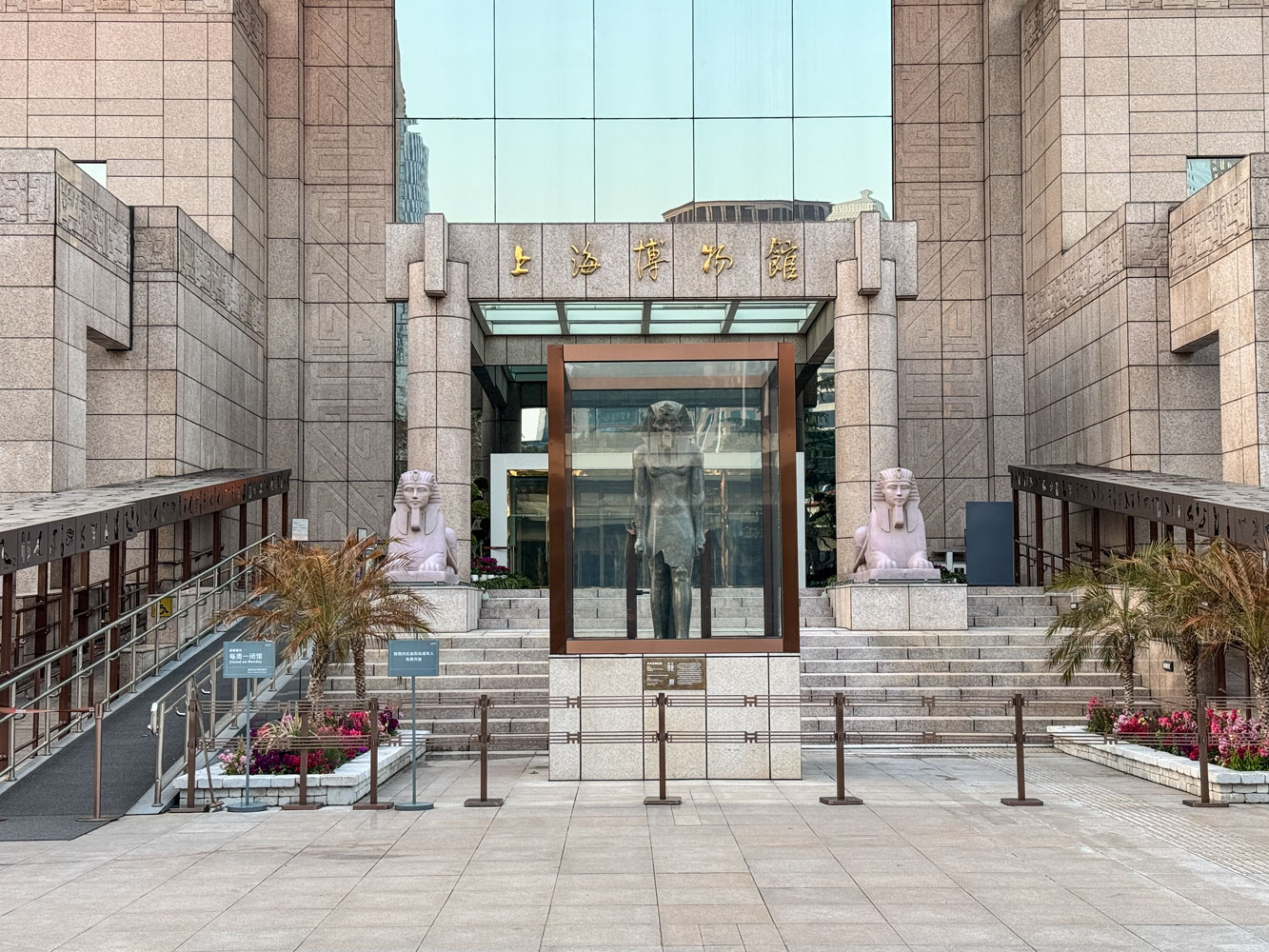
Our excursion had started late in the day and the sun was starting to go down.
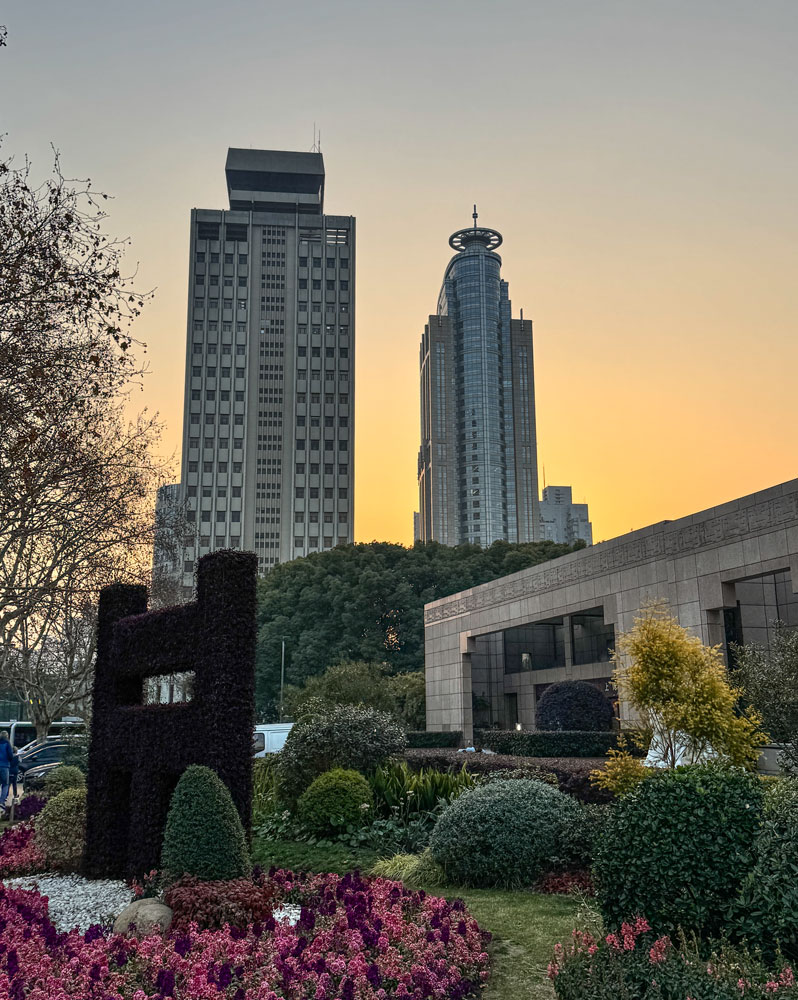
With that, we went back to the ship, arriving about 6pm. The most interesting part had been going up to the observation deck, but our tour guide was almost impossible to understand because of her accent.
The ship set up a buffet dinner in La Veranda, and we ate there. Then it was to bed.
+++++++++++++++++++++++++++++++++++++++++++++++++++++
2/25/2025 (Tuesday) We spent the night docked in Shanghai last night. After breakfast, we went to the buses for our tour of Shanghai. It was cold this morning, in the low 40's.
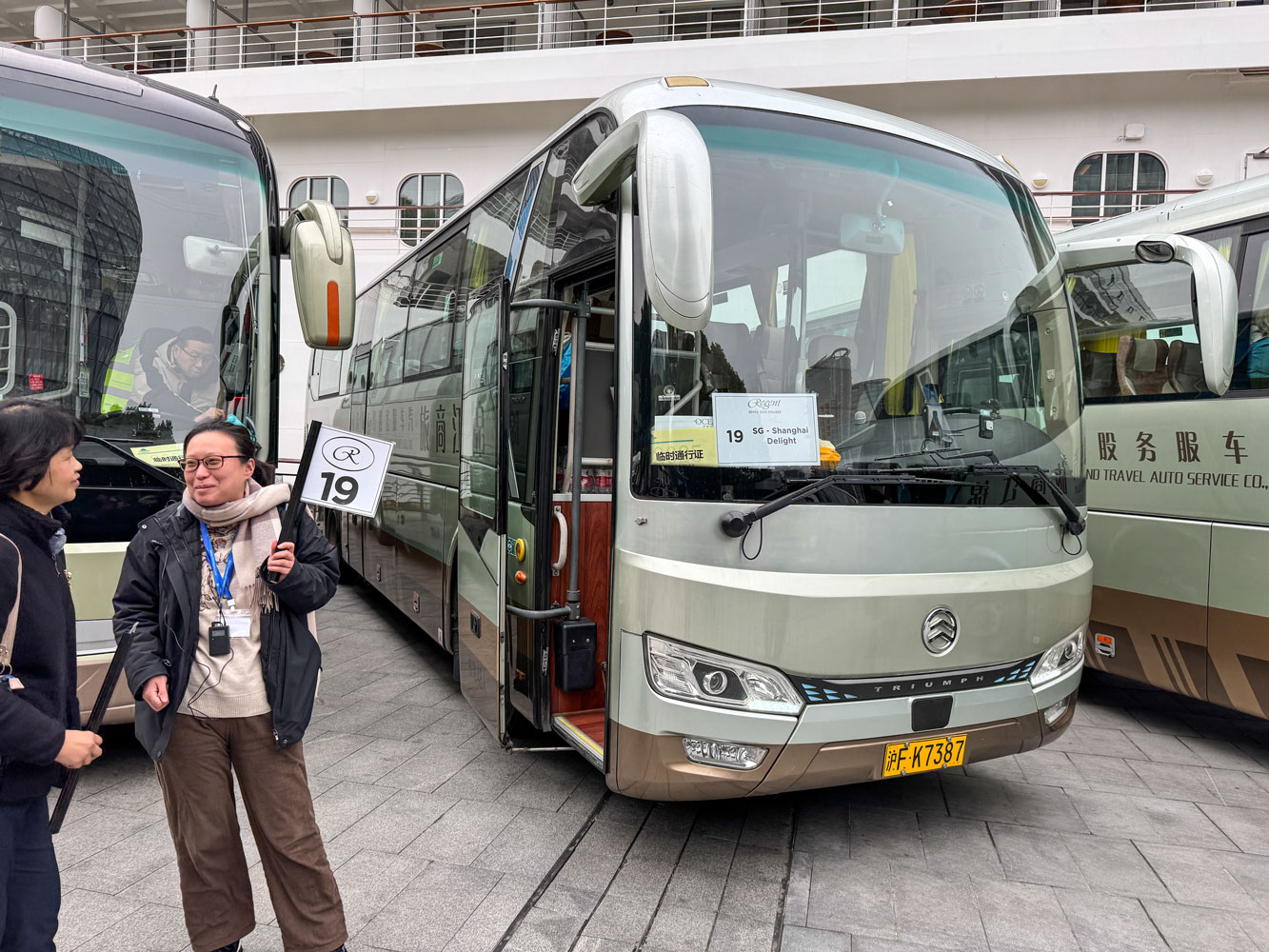
We're going to visit the Shanghai History Museum at the base of the Oriental Pearl Tower.
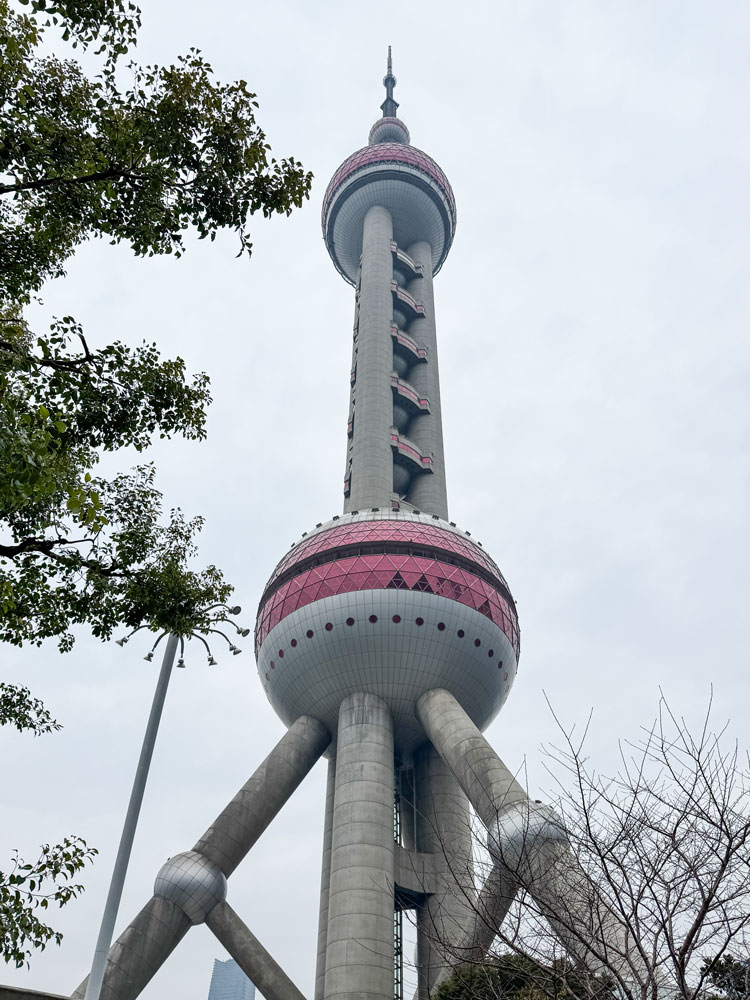
Here's our group.
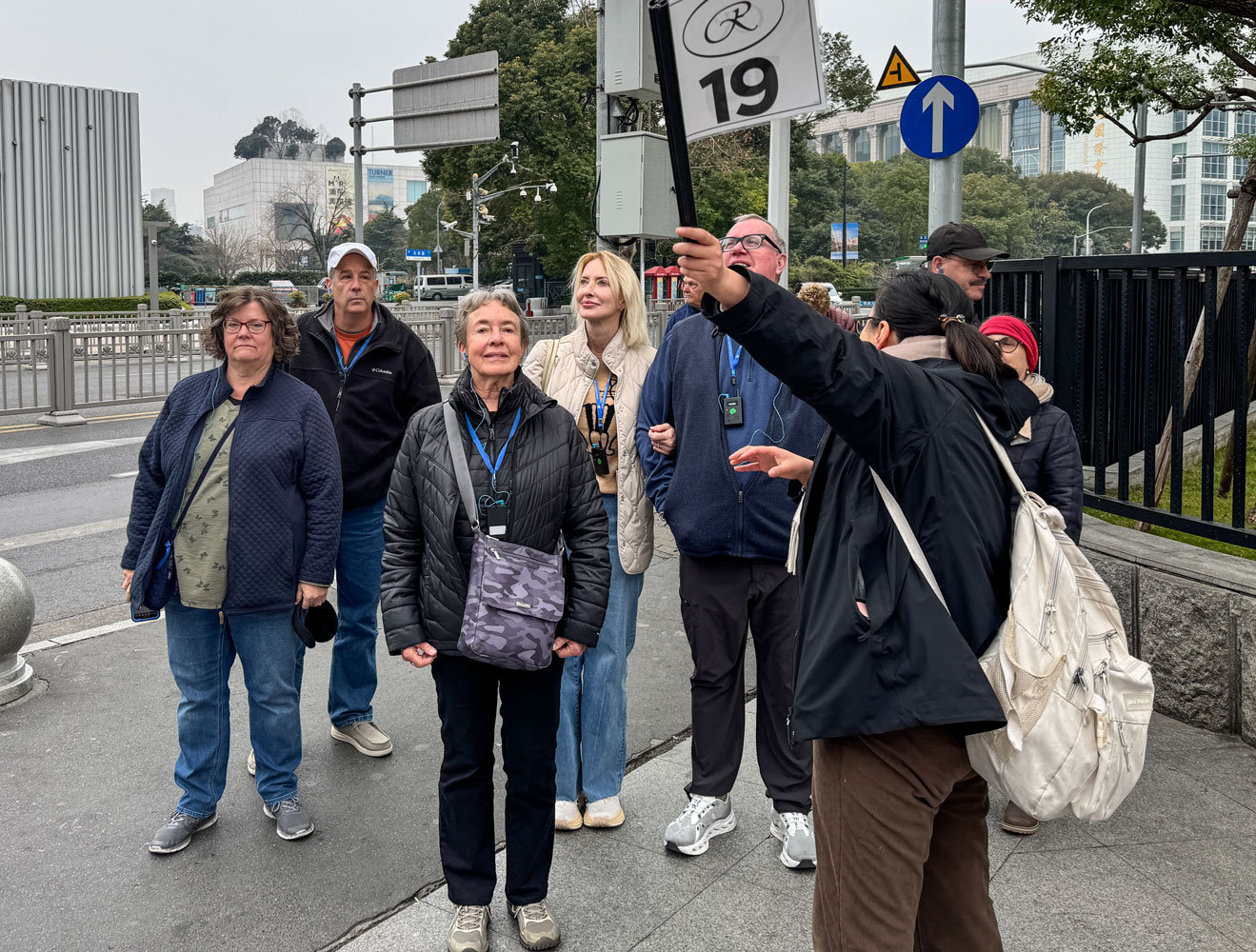
We entered the base of the tower, and found the entrance to the museum.
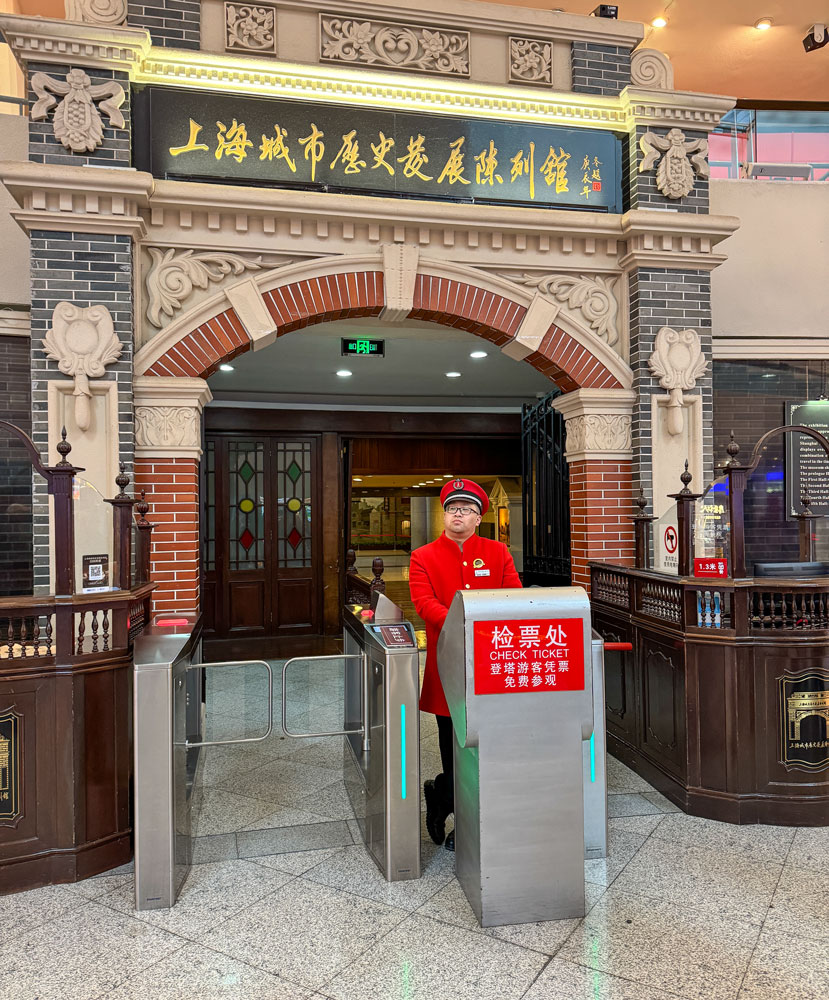
I'll just include a few pictures of the exhibits in the museum. First, some ancient transportation vehicles.
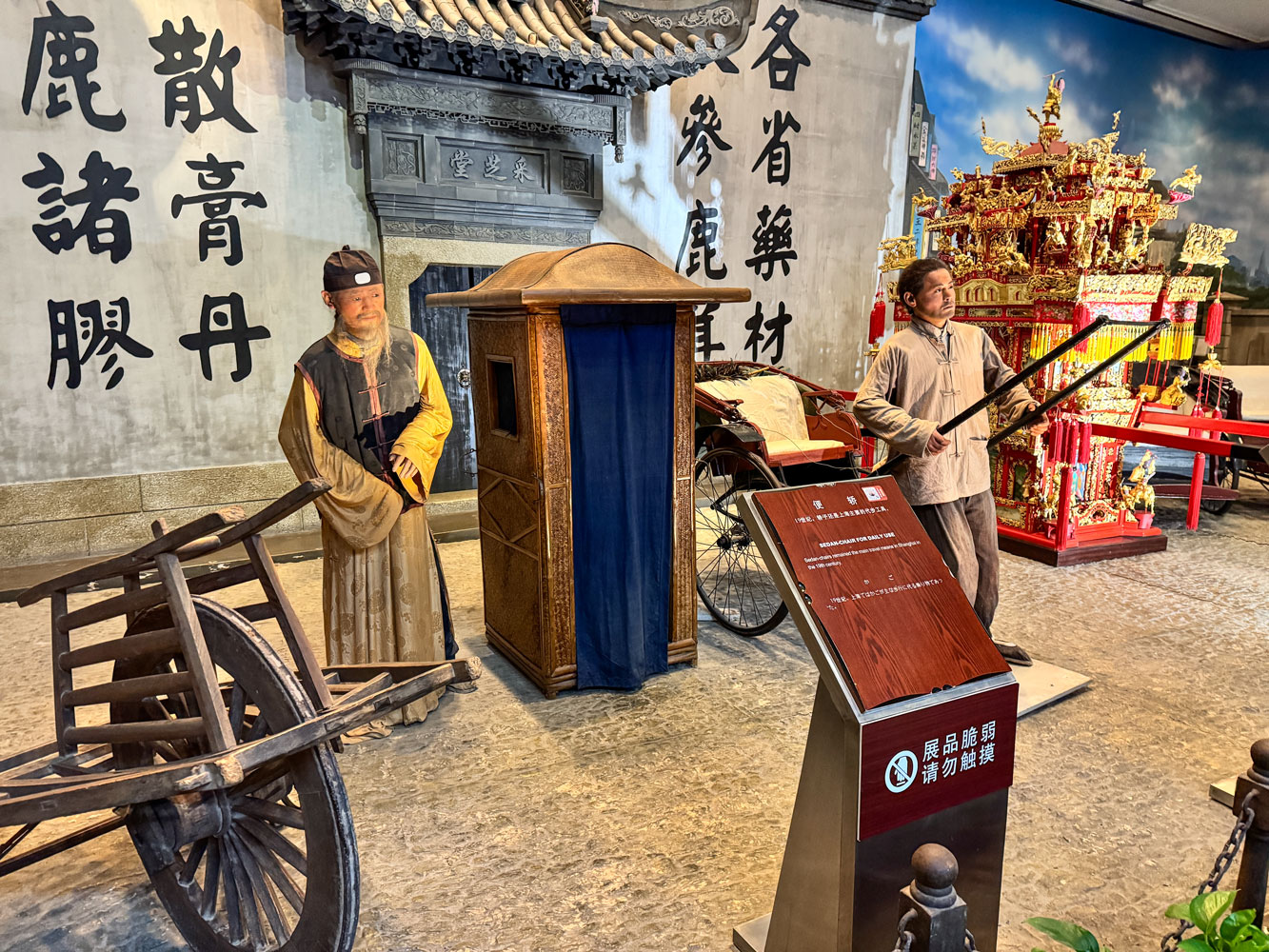
A highly decorated palanquin. Looks like it would be heavy.
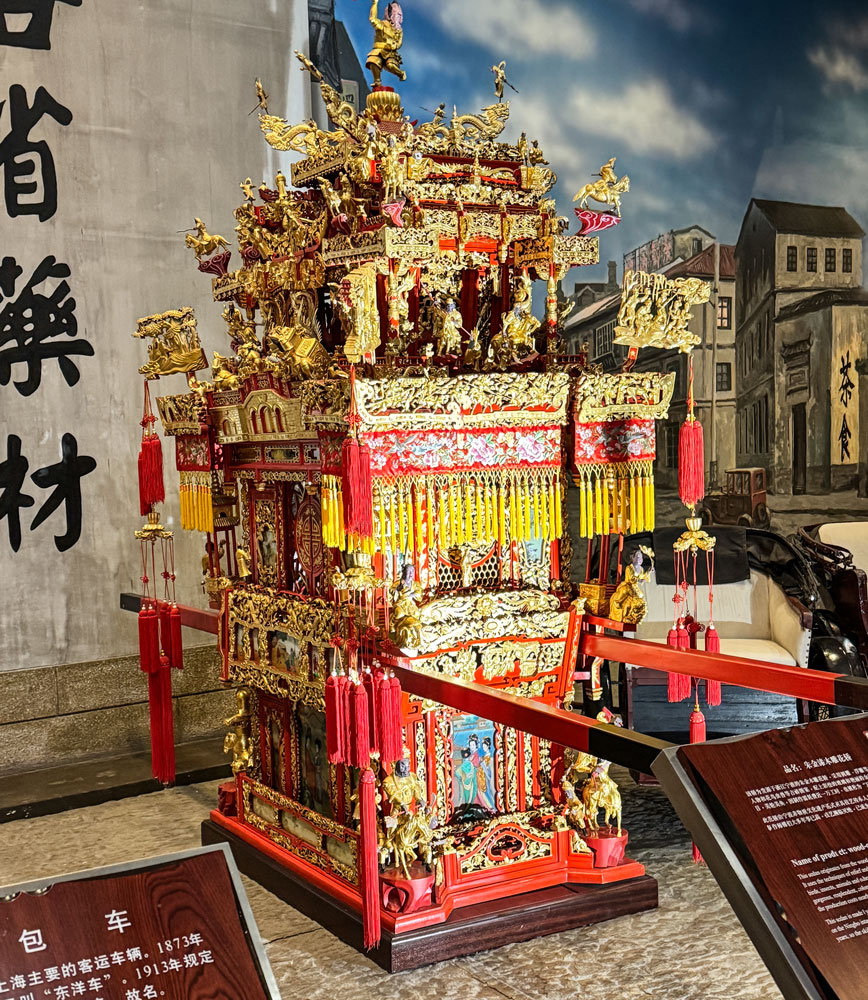
A kitchen scene.
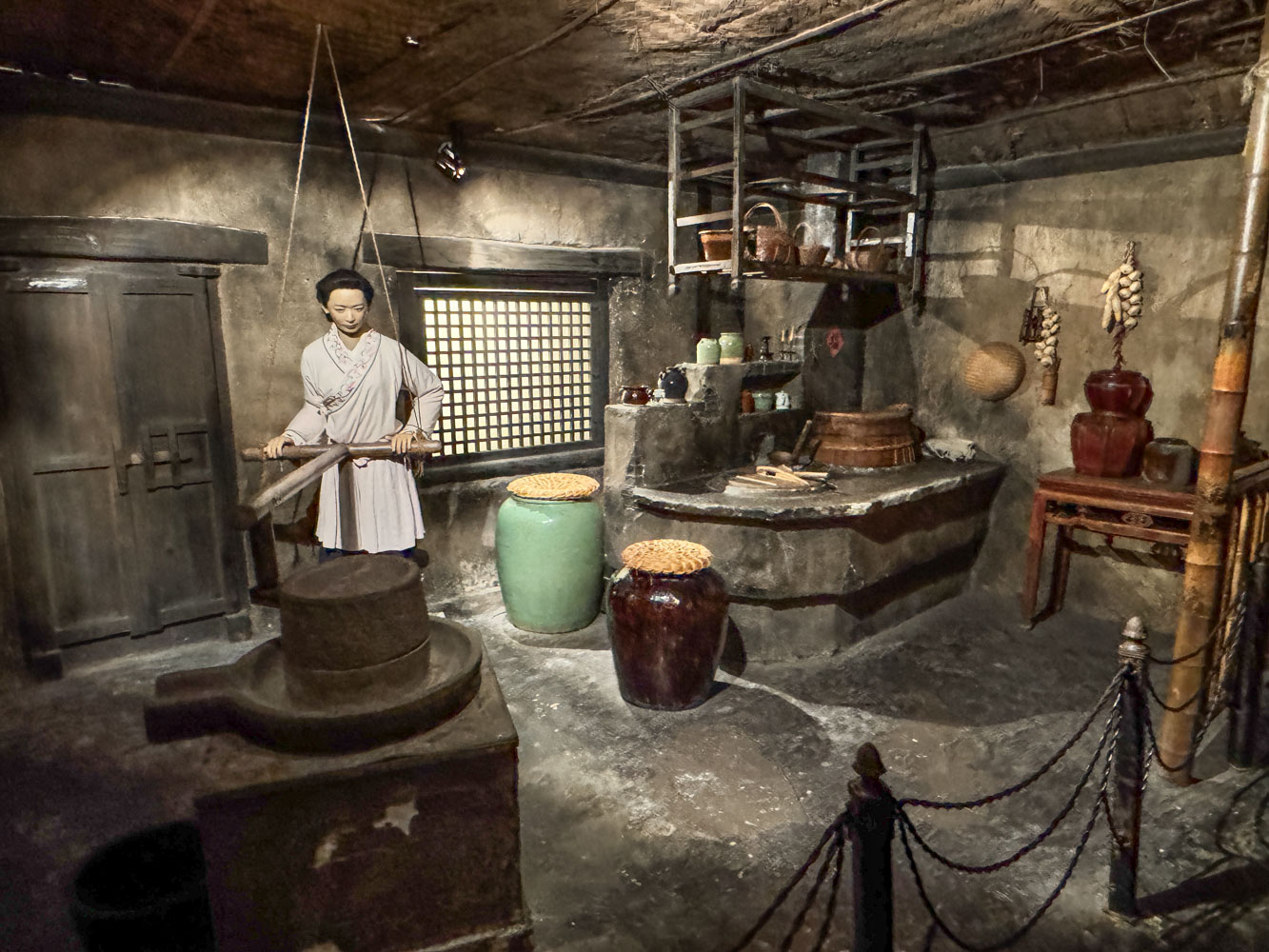
Unspooling silk from the cocoons.
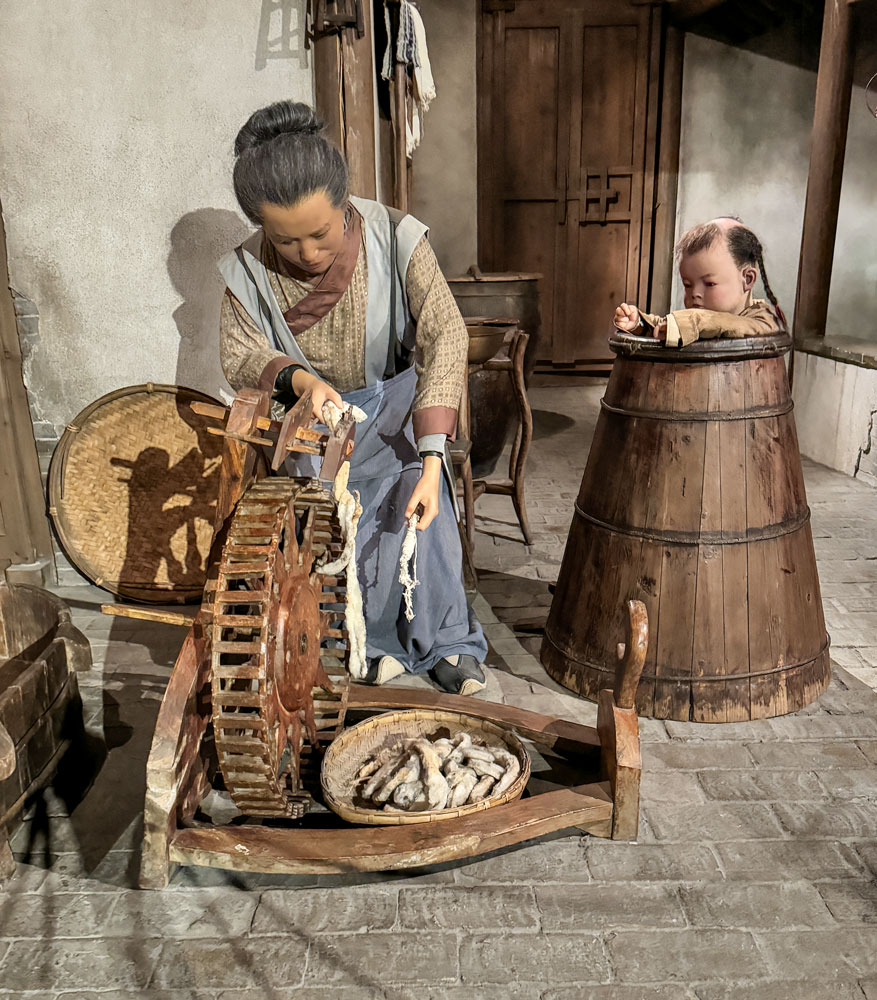
Weaving silk cloth on a loom.
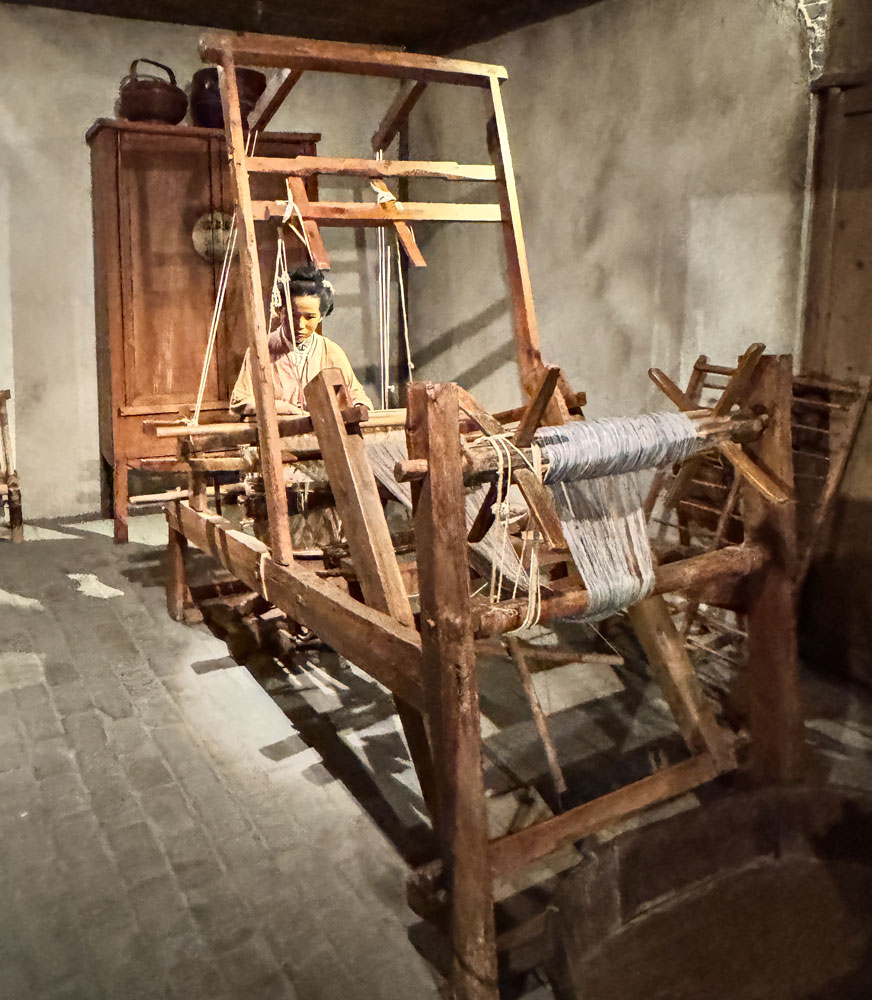
Basket weaving.
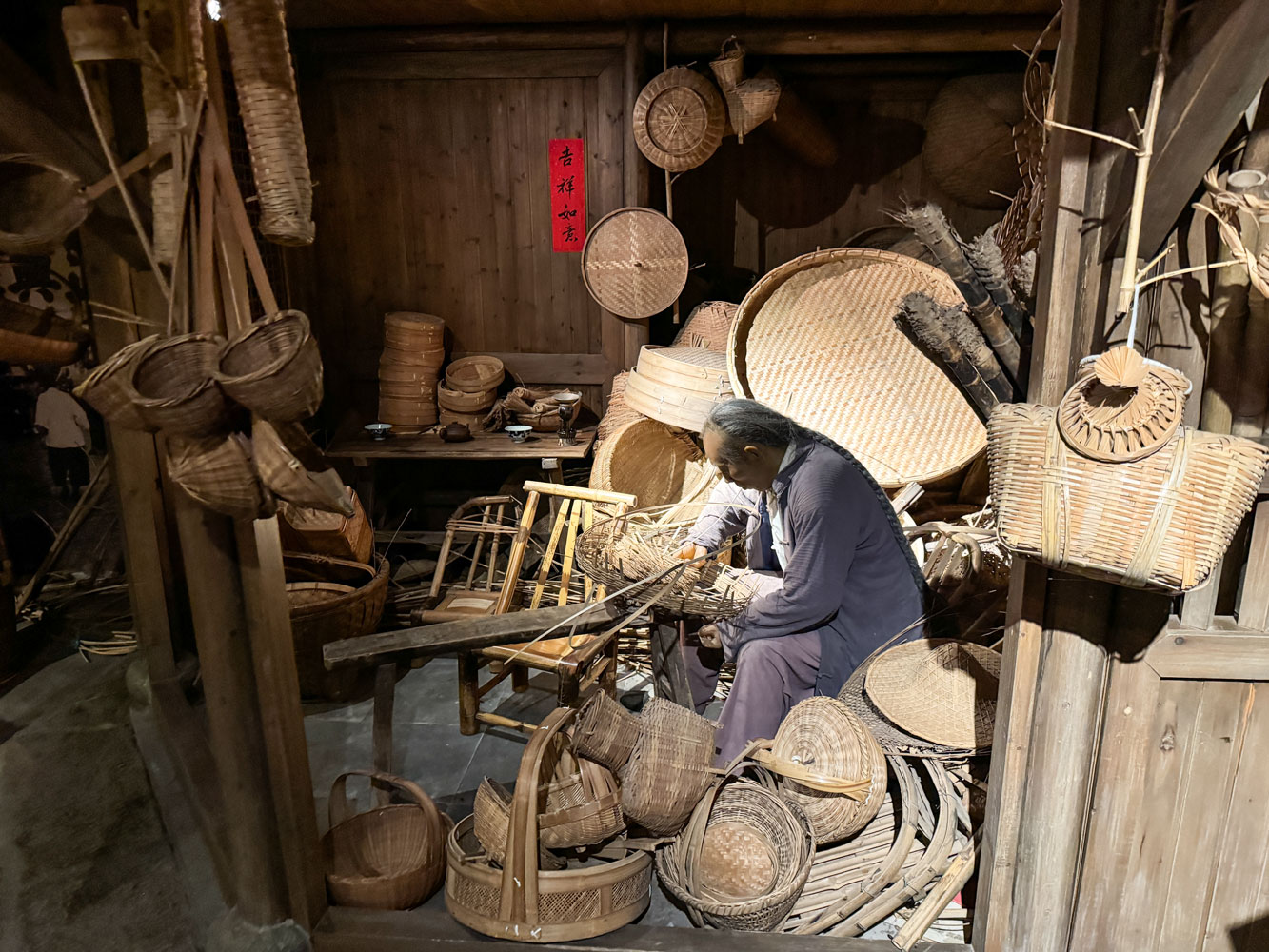
A cloth merchant.

Processing cotton into cloth.
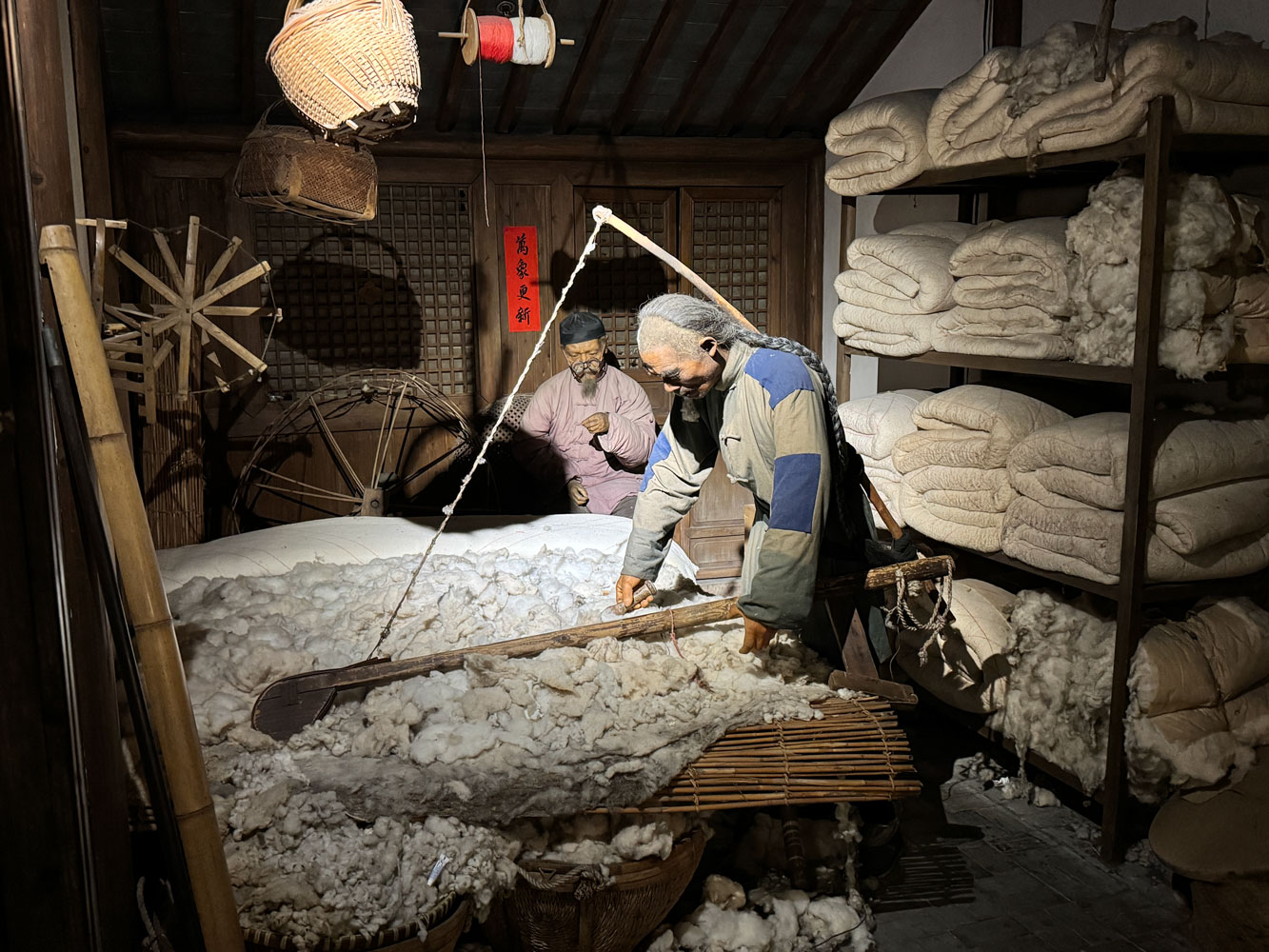
A herbalist.
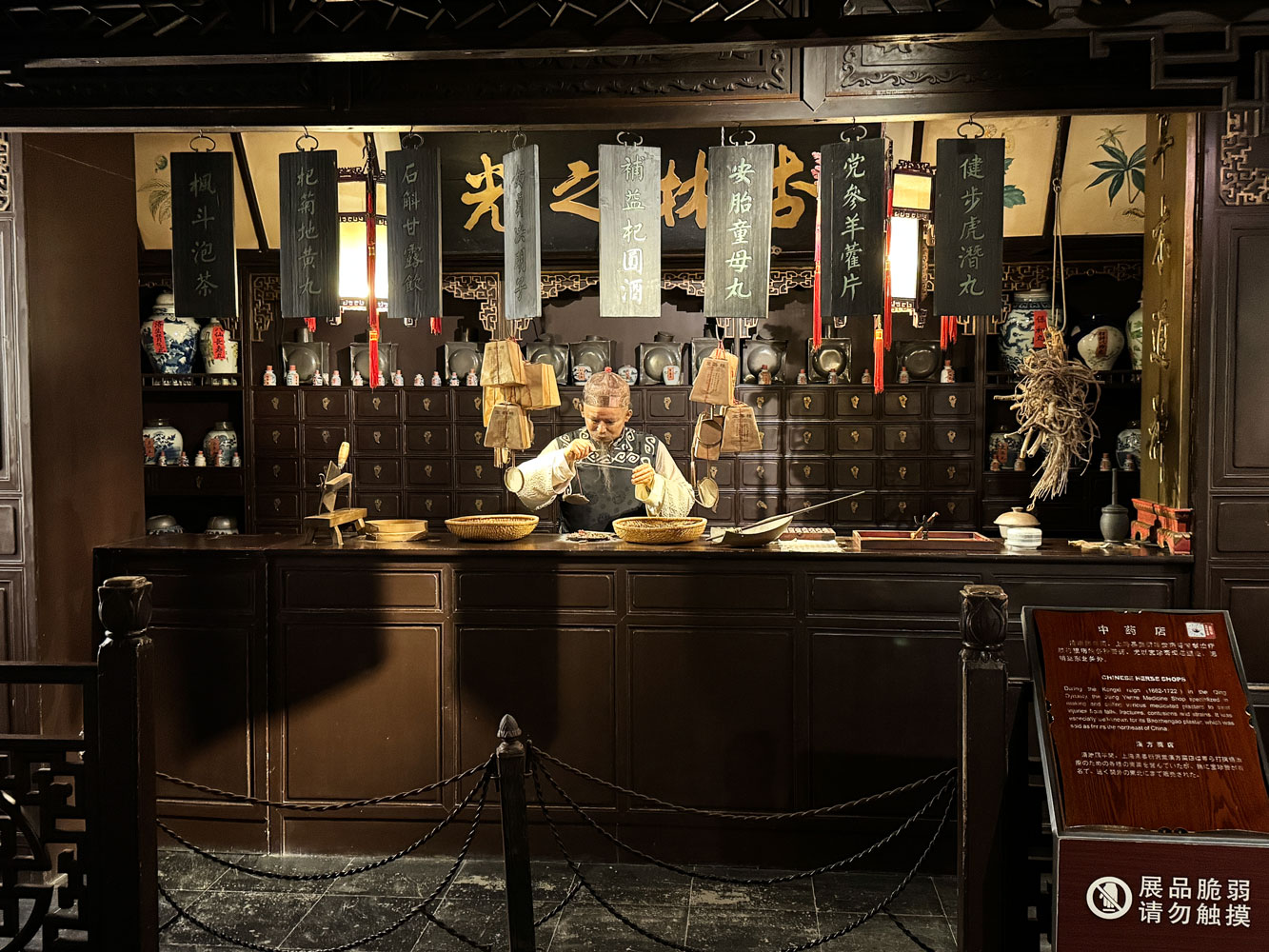
A fortune teller.
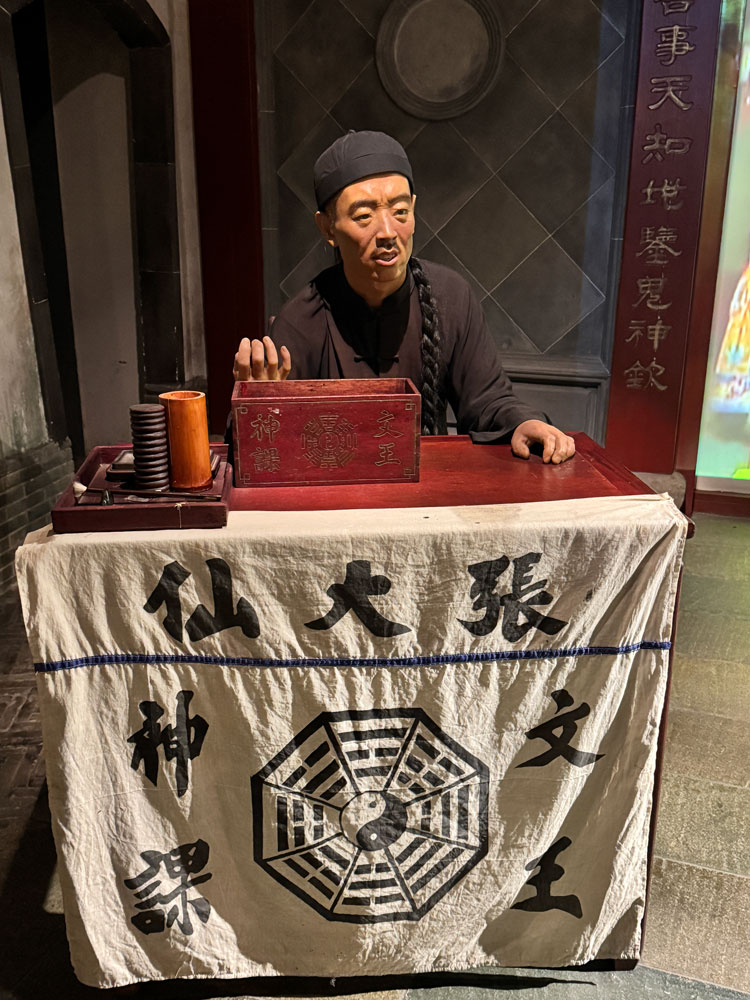
Opium den.
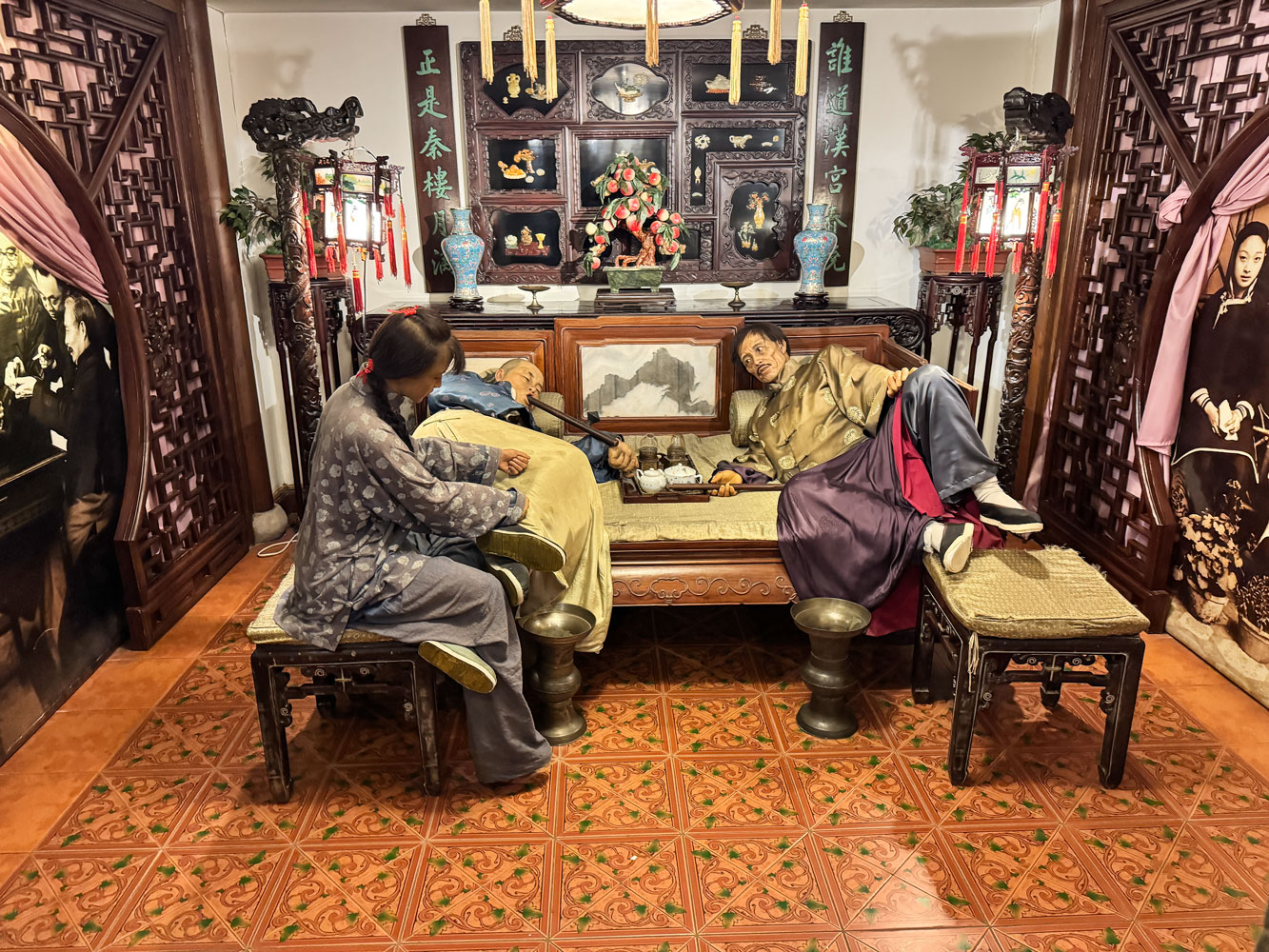
Representation of a commodity exchange.

Representation of the Dangui tea house.

There was a lot more, but I have to limit the number of pictures. We left the museum and went to the Yu Garden, which was built in 1559 by Pan Yunduan for his father, Pan En.
Here's one of the dragons on the wall.
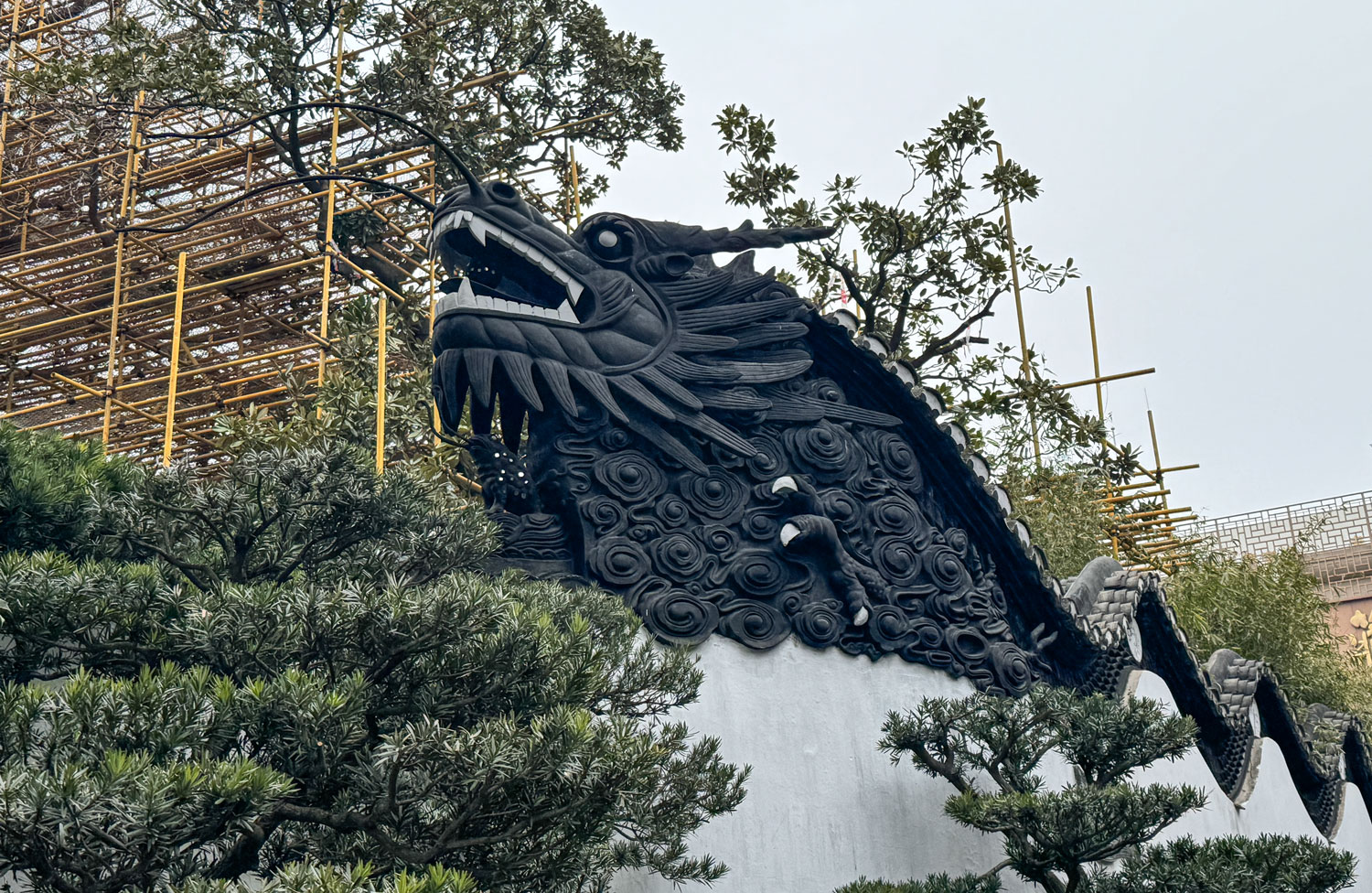
A building on the grounds. The top floor was the residence of the owners.
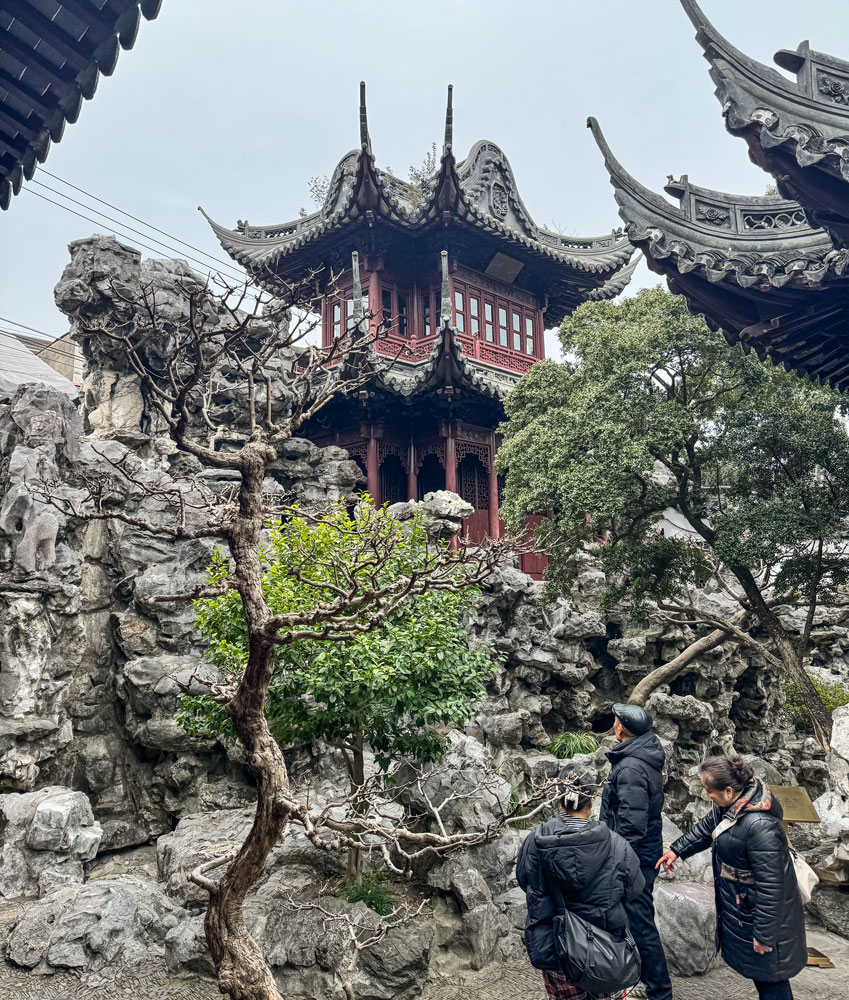
A view from a different angle.
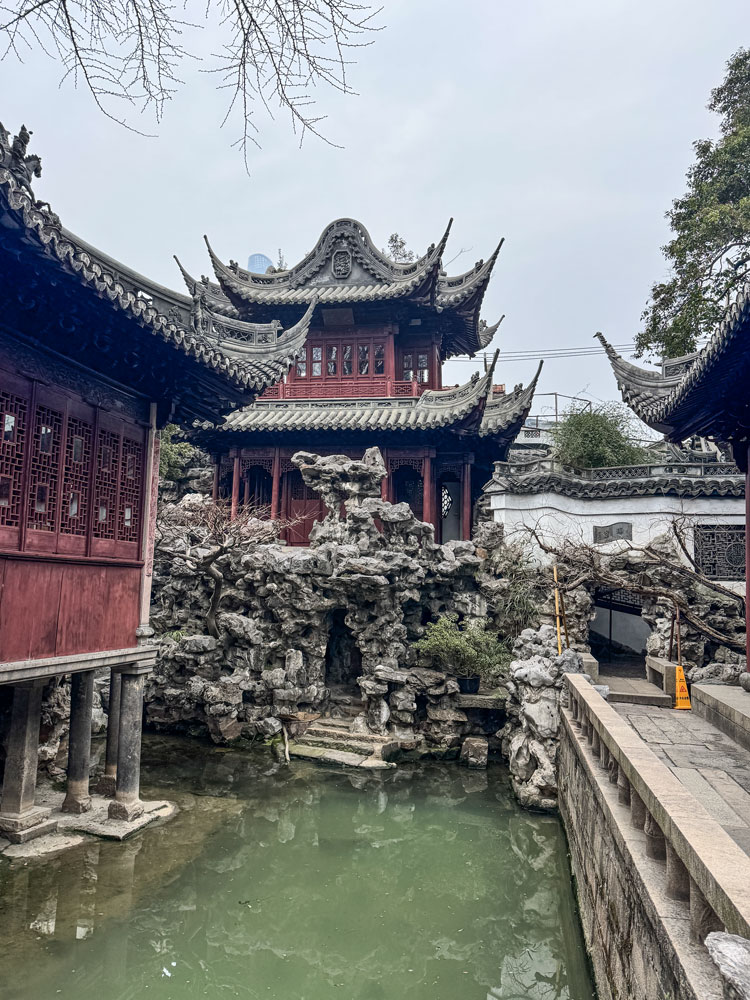
Another wall dragon.

A quiet water scene.
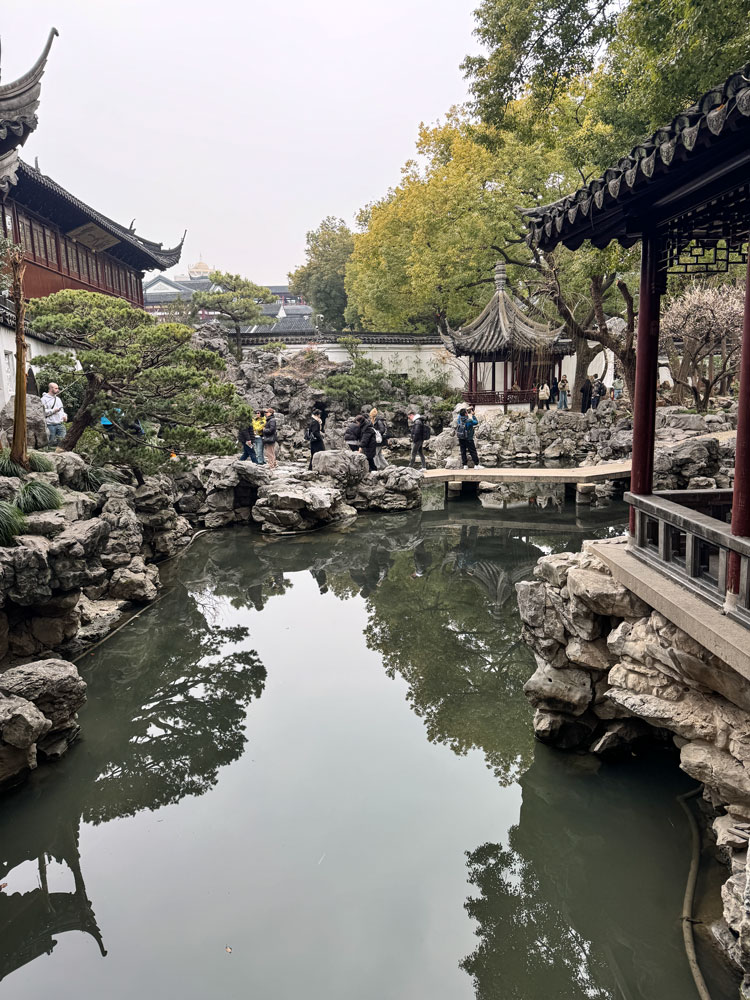
The "Exquisite Jade Rock" which is the centerpiece of the garden. It's the one in the center of the picture. It's just stone, not jade.

We left the garden through this gate.
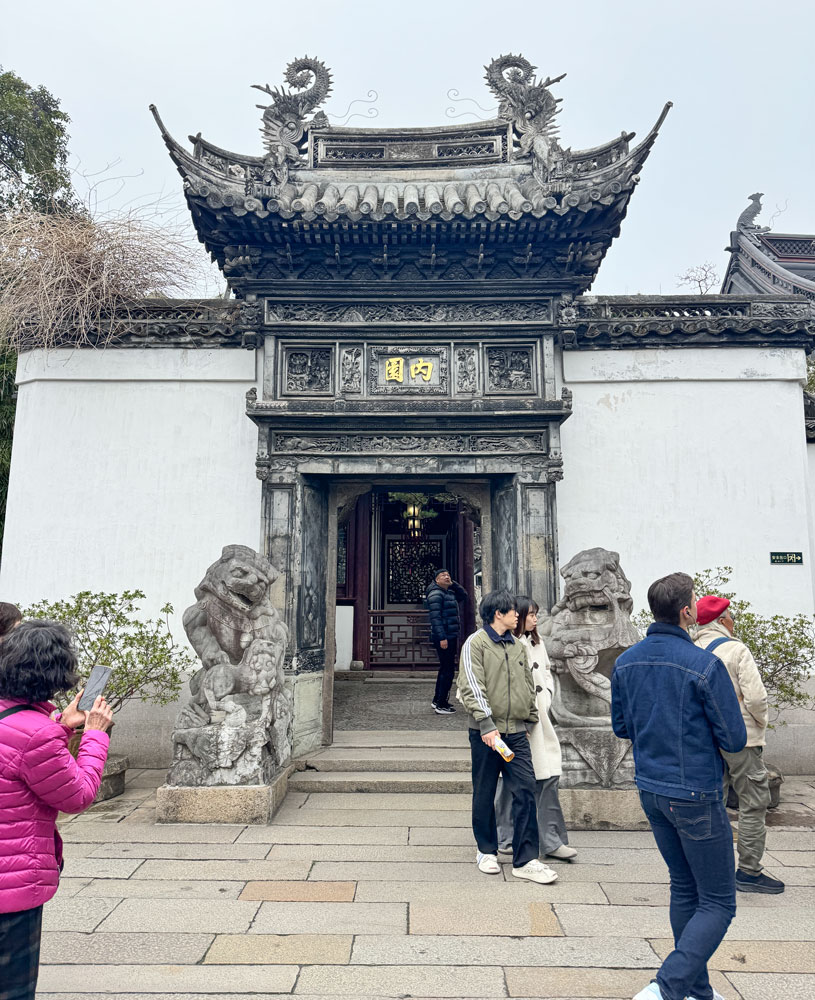
There's a shopping area just outside the garden and the guide took us there next.

Another view of the shopping area. It was really big.
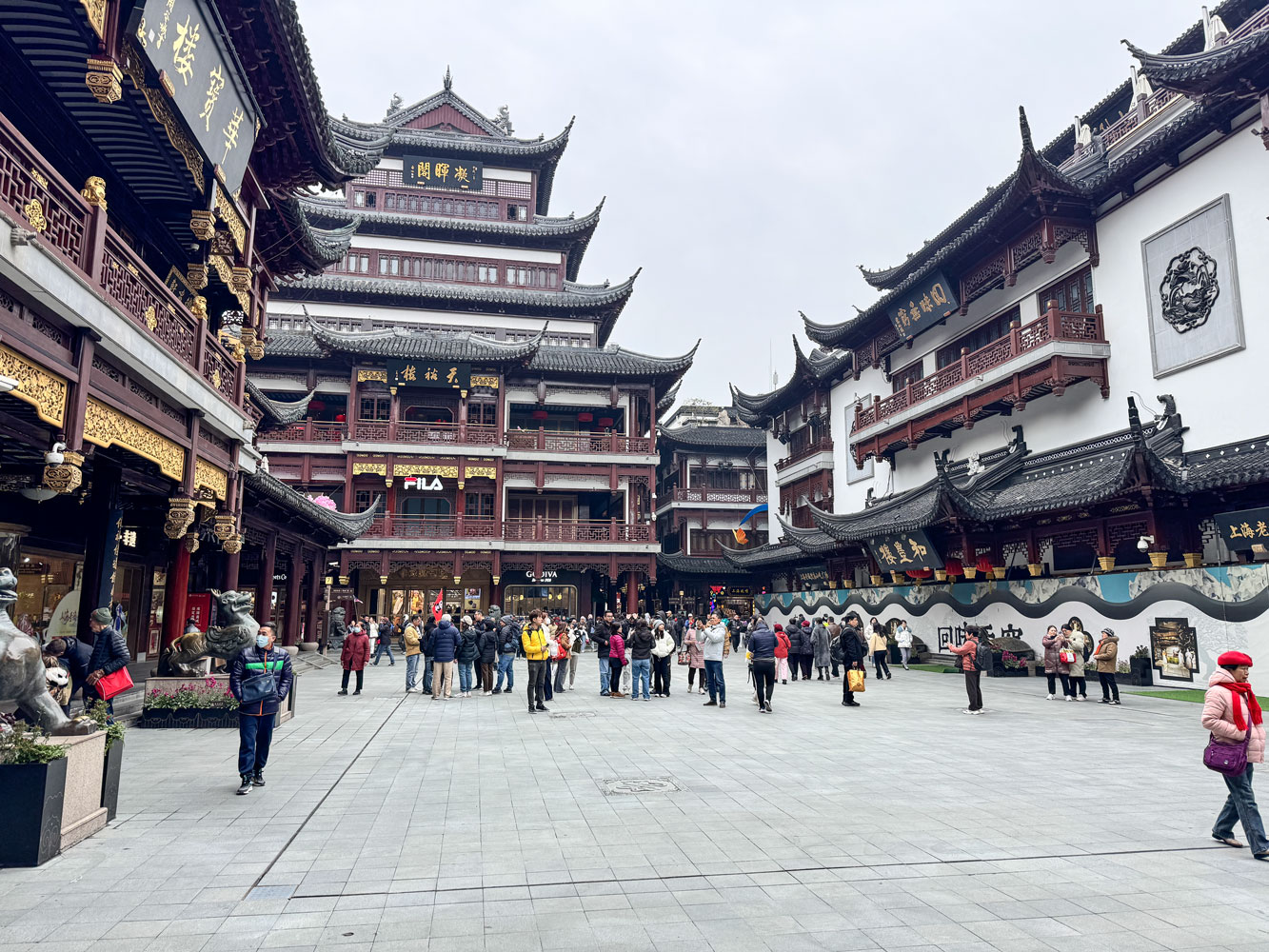
But it was mostly wasted on us. The Chinese use the WeChat or Alipay app to pay for things. Essentially none of the stores will take US credit cards. And to get local currency, you have to exchange $100 (a $100 bill) for local currency and if you don't spend it all, you can't exchange it back.
The guide took us to a jade and pearl place but most of us weren't interested.
Judy and I eventually waited outside - and it was cold.
The bus took us back to the ship, and we had a relaxing afternoon. After dinner, we went to bed and the ship departed Shanghai late, after midnight.
Let me point out that we learned more about Hong Kong, Xi'an, Shanghai and China than I can include in this blog. China is an up-and-coming country. Just as the 20th Century was the American century, it may well be that the 21st Century will be the China century.
That concludes our visit to China. Next, we'll touch on South Korea and then go to Japan.